
- About
- Library
-
Essays
Eric Dinerstein William C. Young
- Plants
- Birds
FIELD NOTES FOR NEW ZEALAND
September 19 to November 2, 2024
William Young
INTRODUCTION
Early in 2024, I decided to plan a trip to New Zealand. New Zealand's land area is about the same size as Colorado. It has two main islands — the North Island and the South Island. Both are long and skinny, and there are no places that are very far from the water. The population is only about 5.5 million.
Rebecca Bowater, a friend I met on a trip to the Antarctic in 2016, lives in Nelson on the north end of the South Island. She had repeatedly invited me to visit, and I finally accepted her offer. I had not travelled beyond 80 miles from my home in the Washington, DC, area since the COVID pandemic began, and I thought New Zealand might be a good destination for my resumption of travel. I had been to Australia four times between 1995 and 2003, but I had never spent time in New Zealand. My trip was scheduled to last 6 1/2 weeks, which is the longest trip I have ever scheduled.
I am a writer and naturalist, and I visited New Zealand primarily to study birds and nature. I also am very interested in art and culture. I had high hopes for the trip, and all of them were exceeded. During the trip, I sent emails about my activities to a list of friends almost every day. These field notes are an expansion of the emails and contain a lot more photographs than the emails did. All of the photos in these notes were taken by me unless otherwise noted.
Thursday, September 19, 2024
I arrived in Nelson around 10 a.m. I had flown from Houston to Auckland in business class, which permitted me to become horizontal on my seat and sleep a bit. Air New Zealand took care of many small details to make the flight more comfortable, and I was not badly jet lagged when I arrived. I had left the DC area on September 17 and crossed the International Date Line. I arrived two mornings after I left, and it was like getting a bad night's sleep. New Zealand was 16 hours ahead of Eastern Daylight Time when I left, and New Zealand time was always most of a day ahead of US time throughout my trip.
Nelson is a small city with a population of about 55,000. It is built on a human scale and has beautiful scenery. Rebecca's house is not far from the Nelson Airport. Her house has a view of the Tasman Bay, and because I flew from the North Island, she could see my plane fly over the water. She picked me up, and we went back to her house, where I met her husband Hanley. On the way, I saw Variable Oystercatchers and Pied Stilts. Around her house were a couple of White-faced Herons, some Silvereyes, some European Starlings, and a lot of House Sparrows.
After lunch, Rebecca drove me to the Nelson Sewage Ponds (aka Poo Ponds). Sewage treatment facilities often attract a lot of birds, and the Poo Ponds in Nelson had a good selection. We saw a great many New Zealand Scaup, some Grey Teal, quite a few Australasian Shovelers, Black Swans, Red-billed Gulls, Southern Black-backed Gulls, and some Australasian Swamphens. Female Paradise Shelducks make a loud peeping call, while the male's call is lower pitched. The male is all dark, while the female is russet with a white head.
Along the road leading to the Poo Ponds were a lot of White-faced Herons and quite a few Sacred Kingfishers. At the ponds were some Eurasian Skylarks on the ground; they are brownish birds with white outer tail feathers. And we saw more than 100 Chaffinches, an introduced species from Europe. A nest had Black Swan eggs that were much larger than chicken eggs. We also saw some swans with cygnets. Some Mallards and Pacific Black Ducks (also called Grey Ducks) had young. It is doubtful that there were any Pacific Black Ducks who did not have at least some Mallard genes. The Grey Teal are smaller than Mallards and have red eyes. The male New Zealand Scaup has yellow eyes. On the drive back, we saw a field that had a lot of swamphens. They often cock their tail and show a lot of white under the tail. A couple of Marsh Harriers soared above. This is the only hawk species who commonly occurs in New Zealand.
I am trying to learn about New Zealand flora, and Rebecca is an outstanding teacher about the subject. Her father was a botanist, and her mother was a horticulturalist. She is an excellent photographer, and her specialty is fungi. She has had a book of her fungi photos published, as well as a book of her alpine plant photos.
The Poo Ponds had a lot of New Zealand Flax, which has spiky long thin leaves. Many ground plants were surrounded by a paper structure which had three holes in a triangle — a device to protect them. On the way home, we saw a lot of Cabbage Trees, which have a spiky Afro on top. The Kowhai trees are in bloom, with their yellow flowers. The Manuka Trees are in bloom with their pinkish blossoms — this is the tree from which Manuka Honey comes.
 Grey Teal
Grey Teal
 Australasian Shoveler
Australasian Shoveler
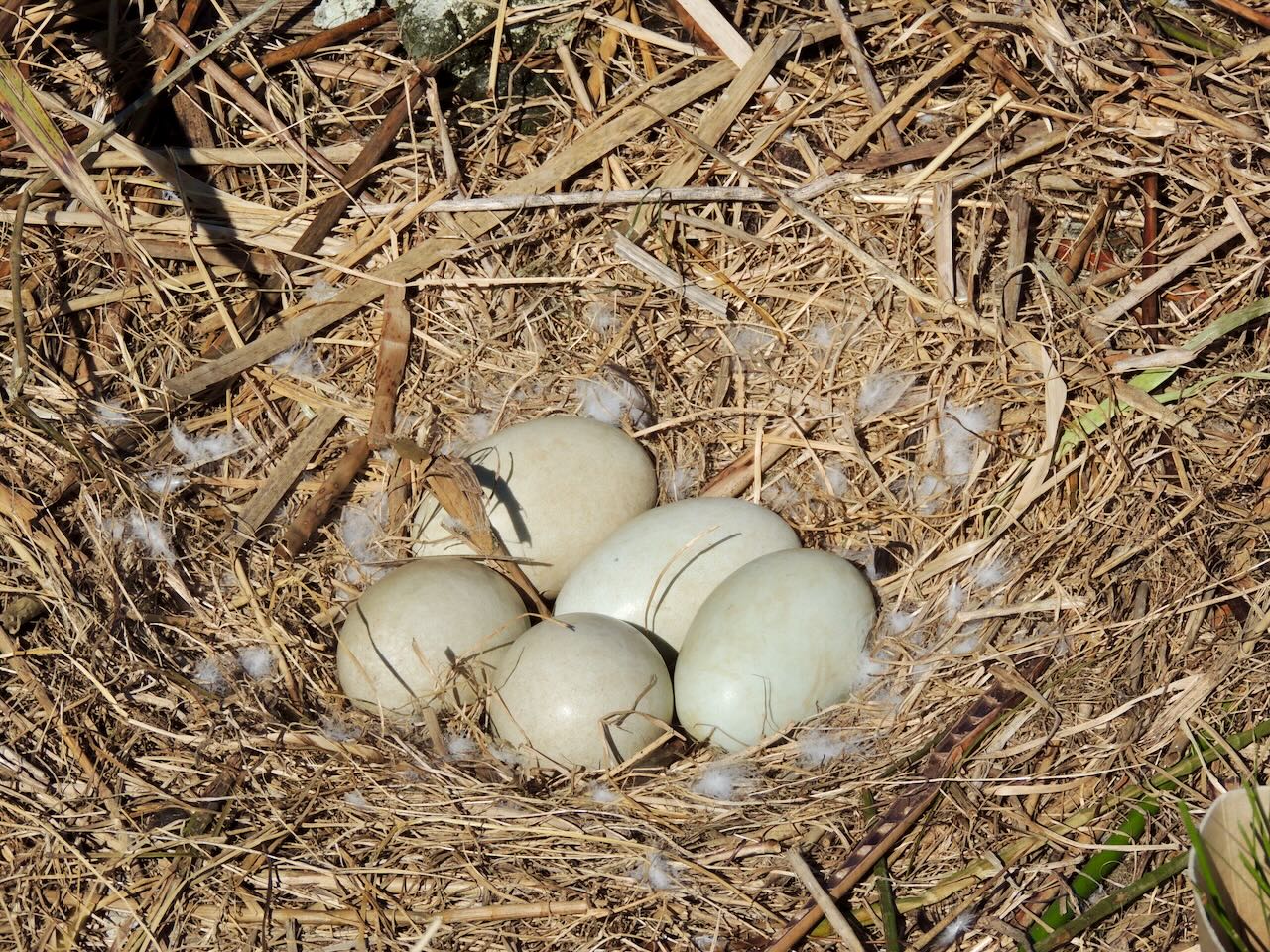 Black Swan Nest
Black Swan Nest
 New Zealand Flax
New Zealand Flax
 New Zealand Cabbage Tree
New Zealand Cabbage Tree
 Kowhai Tree
Kowhai Tree
 Manuka Tree
Manuka Tree
Friday, September 20, 2024
This morning at breakfast, I showed Rebecca a Dunnock in a Gingko tree in her backyard. Dunnocks are small sparrow-like birds with grey on their face, and Rebecca was not aware that they were in her yard. They were introduced from Britain, where they are sometimes called Hedge Sparrows. They are not sparrows and are in the accentor family. From the dining area window, I saw a bunch of White-faced Herons hanging around a tree near the water. A Sacred Kingfisher perched at the top of the same tree. New Zealand has only one regularly occurring heron and kingfisher. Silvereyes were in the Pohutukawa tree near the Gingko tree. The Pohutukawa had mostly white buds, and a few of the red flowers were already out. When in full bloom, the entire tree looks red, which usually happens just before Christmas (at the beginning of the Southern Hemisphere summer), which is why the Pohutukawa is also called the Christmas tree. I saw some Tui in a tree on the other side of the house. Tui are in the honeyeater family. They are common in most parts of New Zealand but can be difficult to photograph, because they tend to move around quickly among the leaves.
After breakfast, Rebecca and I walked along Boulder Bank in Nelson. It is a 13-kilometre stretch of rocks along the Tasman Bay. The rocks are not large boulders, but rather small stones. Not many birds were around, but we got some nice looks at Sacred Kingfishers. I also could see the hills where Rebecca's house is. I shot some video of the waves from the Tasman Bay so that I could capture the sound of the water moving over the rocks. The waves seem much gentler than ocean waves.
In the morning, I had looked at some of the foliage around Rebecca's house other than what I have already described. A symbol of New Zealand is the Silver Fern, and a Silver Fern tree is right outside the window of the bedroom where I slept at Rebecca's house. New Zealand has both tree ferns and ferns without trunks that grow closer to the ground. The top side of the Silver Fern's fronds are green, while the underside, which contains the spores, are silvery.
Rebecca has a lemon tree in her yard, and some of the lemons appear to be almost as large as grapefruits. Some camellias were in bloom, with large reddish-pink flowers. When driving back from the Boulder Bank, we saw a lot of Ngaio trees, which have small whitish flowers and scaly yellow bark on the trunk and branches. The first name of the New Zealand mystery writer Ngaio Marsh comes from this tree.
I felt comfortable in New Zealand from the moment I arrived. In Nelson, everything seemed to be a lot more relaxed than in the US. The people are very kind and friendly, and they often greet you and talk to you when you are on the street or in a shop.
The prices of goods and services require a lot of mental calculation. Everything looks really expensive. The New Zealand dollar was worth between 60 and 62 US cents, so all prices had to be multiplied by 0.6. Road distances and speed limits are measured in kilometres, which also have a conversion factor of about 0.6. Items in grocery stores are sold in kilograms, with a kilogram equalling roughly 2.2 pounds. If you want to buy produce that costs NZ$15 a kilo, an American who is used to imperial measurements first needs to convert it to pounds, which would make it about NZ$6.75 a pound, and then convert it to US dollars, which brings it down to a bit over US$4 a pound, which seems more reasonable.
Gasoline is much more expensive than in the US. It might cost from NZ$2.50 to NZ$2.70 per litre. A litre, which is slightly larger than a quart, is a bit more than a quarter of an imperial gallon. Gasoline costs about NZ$10 a gallon, or about US$6 a gallon, which is about twice as expensive as in the US. This is probably one reason I did not see a lot of large gas-guzzling SUVs on the roads. Almost all of the cars I saw in New Zealand appeared to be good shape. I saw no old junkers. I saw a few police on the street (especially in Nelson) monitoring speed and occasionally pulling over a speeder, but most people seemed to observe the speed limits. By US standards, there was little auto traffic.
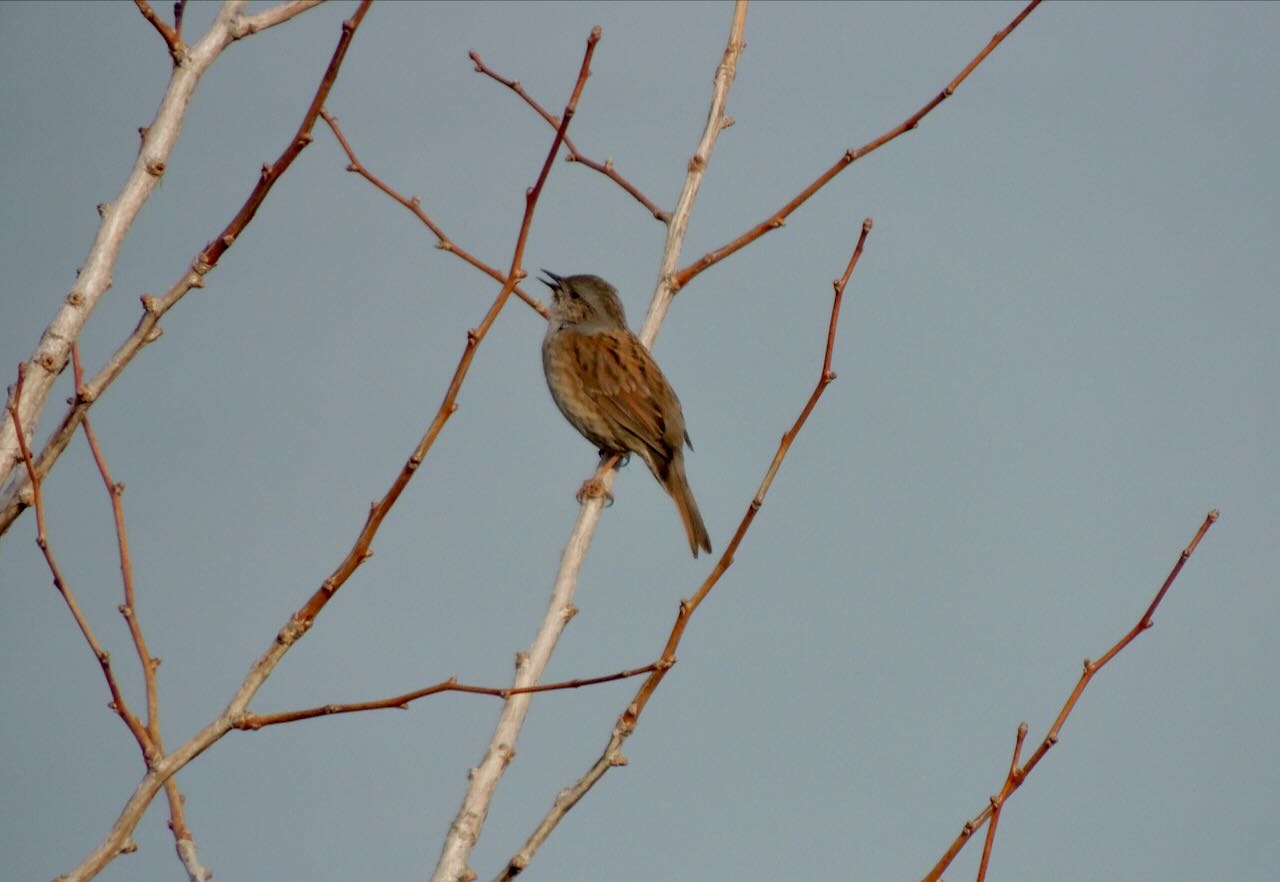 Dunnock
Dunnock
 Tui
Tui
 Sacred Kingfisher
Sacred Kingfisher
 Pohutukawa
Pohutukawa
 Lemon Tree
Lemon Tree
 Camelias
Camelias
 Underside of Silver Fern
Underside of Silver Fern
 Ngaio Tree
Ngaio Tree
 Ngaio Flowers
Ngaio Flowers
 View of Nelson from Boulder Bank
View of Nelson from Boulder Bank
Saturday, September 21, 2024
I felt as if I had lost my sense of direction. Today, we went west, but I felt as if we were going east. Downtown Nelson is south of where Rebecca lives, but when we drove downtown, I felt as if I were going north. I'm not sure if this has to do with the car's passenger seat being on the left side, and the car driving on the left side of the road. We drove to the Motueka Sandspit in the Tasman Bay, which is about 50 kilometres west of where Rebecca lives, but I felt as if we were going east. The Motueka Sandspit is not far from Abel Tasman National Park.
Our primary goal was to see Bar-tailed Godwits, who are tall wading birds. Their long bill, which is slightly upcurved, is black on the front half and red on the half near the face. They are communal birds who feed in large flocks. Bar-tailed Godwits engage in a spectacular migration from many thousands of miles away in Arctic coastal areas to spend the austral summer in the Southern Hemisphere. One godwit achieved the longest non-stop migration of any bird species, traveling from Alaska to New Zealand without stopping to feed — a distance of close to 7,000 miles. The arrival of the godwits in New Zealand each spring is a much-anticipated event, and it is reported by television news.
The weather was sunny and chilly. Rebecca and I went with three other people, one of whom was a woman named Sarah from Belfast, Northern Ireland. When we arrived at the spit, we walked along the beach to the area where we hoped to find the godwits. Some Variable Oystercatchers foraged on the beach. Most birds in this species are all black, but they get their name because they have variable colour morphs.
The Motueka Sandspit is different from past years, because the tides are penetrating deeper onto the spit and flattening the areas needed by some of the nesting birds. We eventually arrived at a spot where we could see about a couple thousand godwits who were at least a couple hundred meters away. Unfortunately, the tide had come in, and between us and the godwits was an area of water a foot or two deep. The only one of us who decided to go near to where the godwits were was Sarah. She took off her shoes and socks, rolled up her pants, and waded to the other side of the water. She told us that earlier in the week, she had swum in the bay. Sarah had never before seen a godwit, and she got an eyeful. The rest of us had to settle for seeing them at a distance.
We saw other birds along the spit. Quite a few Banded Dotterels were on the shore. They are also called Double-banded Dotterels, because they have a rufous broad band under their dark necklace. The males are more heavily marked than the females. Some Pied Oystercatchers, who resemble American Oystercatchers, were in the area on the other side of the water where Sarah went, but they were quite far away. Caspian Terns were over there as well. Caspian Terns are the largest tern species in the world, and I see them in the DC area. Canada Geese were introduced to New Zealand, and I saw some of them too. An Australasian Gannet flew over. A White-faced Heron fed in an area next to the spit.
When Sarah returned from the other side of the water, we walked back to the car and then had lunch at a place called Toad Hall. We stopped at a place where some Australian Wood Ducks nest. We saw two females and a male. Wood Ducks are considered a vagrant in New Zealand.
We ended up not seeing a lot of different species, but walking in the beautiful surroundings was very soothing and healing. When I looked in one direction, I saw the bay. In the other direction, I saw the snow-capped Mount Arthur. During the trip, there were many instances when I saw both water and snow-capped mountains in the same visual field.
Before dinner, I sat with Hanley and watched part of a rugby match featuring the New Zealand national team. Rugby seems to be a violent game. Players are hit as hard as they are in American football, yet they wear little or no padding or protection. Only a few players wear helmets. I wondered how long a career these players could have before their bodies broke down.
 Variable Oystercatcher
Variable Oystercatcher
 Male Banded Dotterel
Male Banded Dotterel
 Bar-tailed Godwits
Bar-tailed Godwits
 Caspian Tern
Caspian Tern
 White-faced Heron
White-faced Heron
 Australian Wood Ducks
Australian Wood Ducks
 Sarah Wading Across Water
Sarah Wading Across Water
 View of Mount Arthur
View of Mount Arthur
Sunday, September 22, 2024
I walked more than six miles this morning. Along the highway, I saw quite a few Norfolk Pines, which come from Norfolk Island, which is a small Pacific island north of New Zealand. They are tall trees with a triangular profile and a lot of space between the branches.
Nelson's sister city is Miyazaki, Japan, and I started by visiting some Japanese gardens which are in Nelson as part of the cultural exchange. The gardens had few visitors when I arrived, but more began to show up later. They contain cherry trees in bloom that looked similar to the famous ones in DC. Oddly, some cherry trees are considered to be invasive in New Zealand. I saw New Zealand Fantails flitting in the trees. They spread their mostly white tails while they busily forage. With the fantails were tiny birds called Grey Warblers, who are not related to the Wood Warblers in the US (or the warblers seen in Europe). A lot of Song Thrushes (another introduced species), foraged on the ground, and two Masked Lapwings were on a big grassy plot just outside the gardens. In this same area were signs about a peace grove, student peace initiatives, and Quakerism. New Zealand's oldest Quaker meeting house is in Nelson.
Next to the gardens is a marae, a place where the Maori language can be spoken and Maori culture can be celebrated. The building has a lot of Maori carvings and sculptures around it. Maori is one of the two official languages of New Zealand. The other is sign language. English is by far the most commonly used language, even though it is not an official language. I had the impression that there is still an enormous amount of animosity between the Maoris and the Europeans.
I then walked toward the Suter Art Museum. On the way to the museum, I asked a couple who were coming out of their house how far away it was. They were getting into their car and offered to give me a ride. I did not try thumbing — I don't know if people do that here. But I have found the people here to be very friendly and helpful.
The museum has a small statue of a gnome out front. Inside were a number of exhibits. I found during my trip that New Zealand art museums focus a lot more on New Zealand art than most American museums focus on American art. One painting was called All Along the Heaphy Highway, by the painter Bill Hammond. It is about a proposal to build a highway through an area that contains a famous walking track. The bird-headed figures on the right represent the people who wanted to build the road, while the left of the painting has the shadowy dreamlike world that the road would disturb. Another painting called Eh Bee See, by Wayne Youle, shows each letter of the alphabet, with many represented by people or objects which have had a significant role in Maori history, both positive and negative.
After the museum, I went to the adjacent Queen's Gardens. The gardens have a stream running through them, and a lot of sculptures are placed along the walking paths. I saw many Chaffinches feeding on the ground. Tui were in some of the trees, and a lot of Red-billed Gulls were near the water. The gardens have a good variety of trees. One is a Bunya Bunya, which every few years grows huge cones that are about as big as a soccer ball and can weigh more than 20 pounds. The Australian Aboriginal people harvested the cones in a special ceremony before roasting and eating them.
I walked in the areas outside the gardens and met a woman on a bike named Lena who tried to convince me to take a long walk up into the hills. I ended up walking all the way back to Rebecca's house from the gardens. New Zealand is one of the hilliest places I have ever been, and it seemed I had to walk up a lot of hills no matter where I was.
I saw a bit of street art. One work was done for the Brook Waimarama Sanctuary in Nelson. It showed painted images of some of the endangered and extinct New Zealand species. One is an extinct wattlebird called a Huia, whose female had a long, curved bill, while the male had a short, stout bill.
On the walk back to Rebecca's house, I saw a Dunnock singing in a tree. I tried to learn the songs of as many New Zealand birds as possible. The sunny day turned into a rainy one. Soon, the sun came out again, and I felt a bit warmer. On the way back, I walked through some residential areas, and quite a few mailboxes featured signs that said "No Junk Mail" or "No Circulars". One mailbox was for junk mail only. Young people are hired to deliver circulars and advertisements, and the signs are directed at them rather than mail carriers.
On my way home, I went up Malvern Street instead of Bay View and had to retrace my steps. When I was walking down the sidewalk, I saw a woman coming from the other direction, so I moved into the street. When we reached each other, she said, "I would have walked in the street if you were on the sidewalk." She said it in a friendly tone, and her intent was that I did not have to be nice and move. It is yet another example of how kind, friendly, and polite the New Zealanders are.
 Norfolk Pines
Norfolk Pines
 Nelson Japanese Gardens
Nelson Japanese Gardens
 Peace and Quaker Signs at Nelson Gardens
Peace and Quaker Signs at Nelson Gardens
 Nelson Marae
Nelson Marae
 Gnome in Front of Suter Art Gallery
Gnome in Front of Suter Art Gallery
 All Along the Heaphy Highway at Suter
All Along the Heaphy Highway at Suter
 Eh Bee See at Suter
Eh Bee See at Suter
 Bunya Bunya Tree
Bunya Bunya Tree
 Huia Street Art
Huia Street Art
 Mailbox with No Junk Mail Message
Mailbox with No Junk Mail Message
Monday, September 23, 2024
This morning, I ate breakfast while sitting next to a large window looking out over Tasman Bay. I saw a Silvereye foraging in a Judas Tree behind Rebecca's house. Silvereyes are kinglet-like birds who have a big white eye ring.
After breakfast, Rebecca took me Monaco, a Nelson suburb where she lived for ten years while raising her children. The accent in "Monaco" is on the second syllable rather than the first. The area has a Rainier Street and a Grace Street, but it does not appear to be as wealthy an area as the other Monaco. We were close to the Nelson airport. The tide was out, and we saw some Royal Spoonbills more than 100 meters away. Next to them were a few Pied Oystercatchers.
We later went to Jimmy Creek and mostly looked at plants. Rebecca showed me Kawakawa leaves, which are heart shaped. Wineberry is a native New Zealand plant whose leaves have jagged edges. We heard Tui in one of the trees near a feeding station, but they never came down. A couple of Grey Warblers were near the place where we parked.
For lunch, we went to the place where Pic's peanut butter is made. The building has a very tall representation of a jar of peanut butter in front, and inside were posters advertising peanut butter milkshakes.
After lunch, we went to the Marsden Valley Reserve. We mostly looked at plants and fungi, and a fantail followed us around. We found some Bird's Nest Fungi, which look like tiny brown bird nests. Many of the fungi are very small and can be difficult to see. As we were driving away, I spotted a pair of California Quail. We then returned to Monaco. The tide had come in, but the spoonbills had not come in with it and were still in the same spot as they had been earlier.
The sunset was beautiful over the water in Nelson. When it got dark, a naturalist named Peter Jamieson picked us up in his Tesla and took us for a private tour to see glowworms in the Brook Waimarama Sanctuary in Nelson. The glowworms are the carnivorous bioluminescent larvae of fungus gnats who produce vertical threads covered with mucus. The bioluminescence attracts small insects who become entangled in the sticky threads and are eaten by the larvae. Most of the other members of the family eat fungus, which is the basis for the fungus gnat name, but this species does not. To see the glowworms, we had to walk more than a mile along a dark path in the forest with only a dim red light so that we could see where we were going. There was not much moonlight, and we could see the Southern Cross constellation in the sky. I mention this, because some of the places that had a lot of glowworms looked like a planetarium at eye level. The bioluminescence does not flicker, as with fireflies. It shines like a small star, and a lot of them together create the planetarium effect. If you shine a light on them, the threads with the larvae look like strings of shining necklaces. I was able to take a few photos of the hanging strands with my phone.
Along the path are little wooden boxes for Wetas, who are very large crickets indigenous to New Zealand. I told Peter that I live near Washington, DC, and our public radio station is WETA. There was a dead Weta specimen in the visitors' centre.
The Brook Waimarama Sanctuary is doing remarkable work, despite the challenges of having to deal with a host of introduced mammals, including deer, pigs, goats, mice, rats, stoats, hedgehogs, and others. New Zealand is one of the leading countries in the world in eradicating invasive predators. Peter showed us a map with the locations of 300 traps and tunnels at the sanctuary to try to control predators. To go from the staff headquarters to see the glowworms, we needed to go through a special gate designed to keep out predators. It is possible that within six months, the sanctuary will be able to resettle some kiwis within the predator-free area.
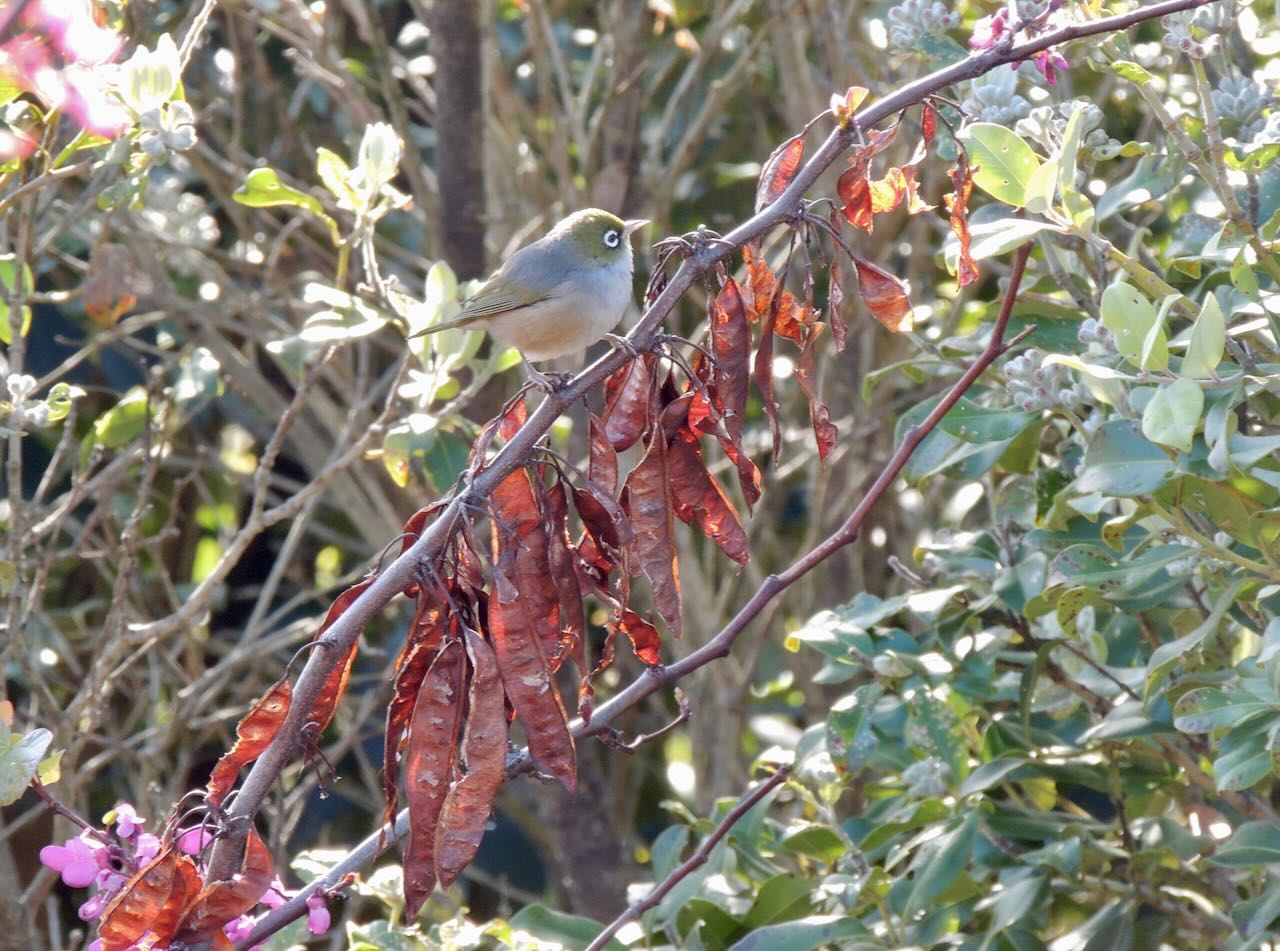 Silvereye in Judas Tree
Silvereye in Judas Tree
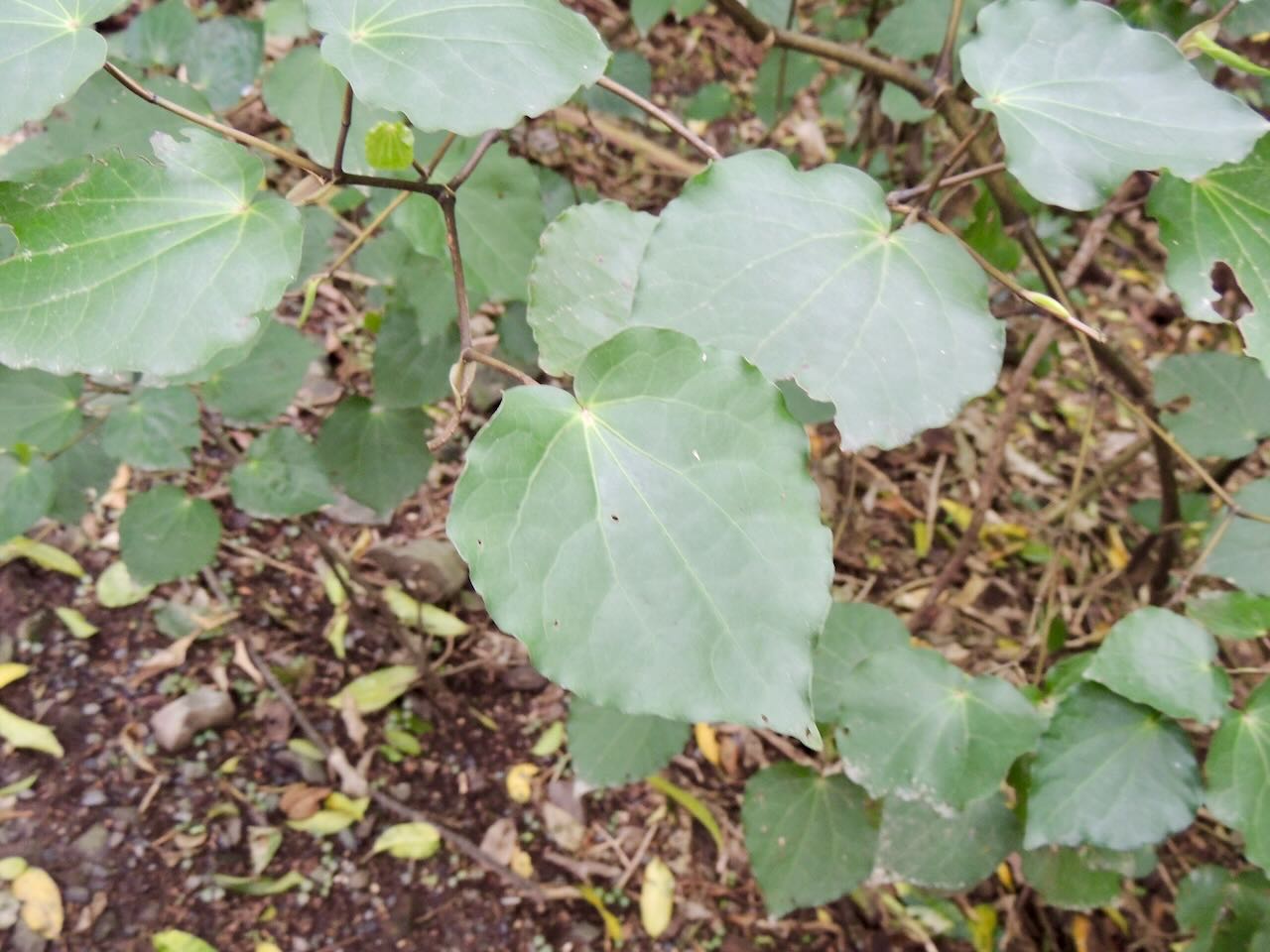 Kawakawa Leaves
Kawakawa Leaves
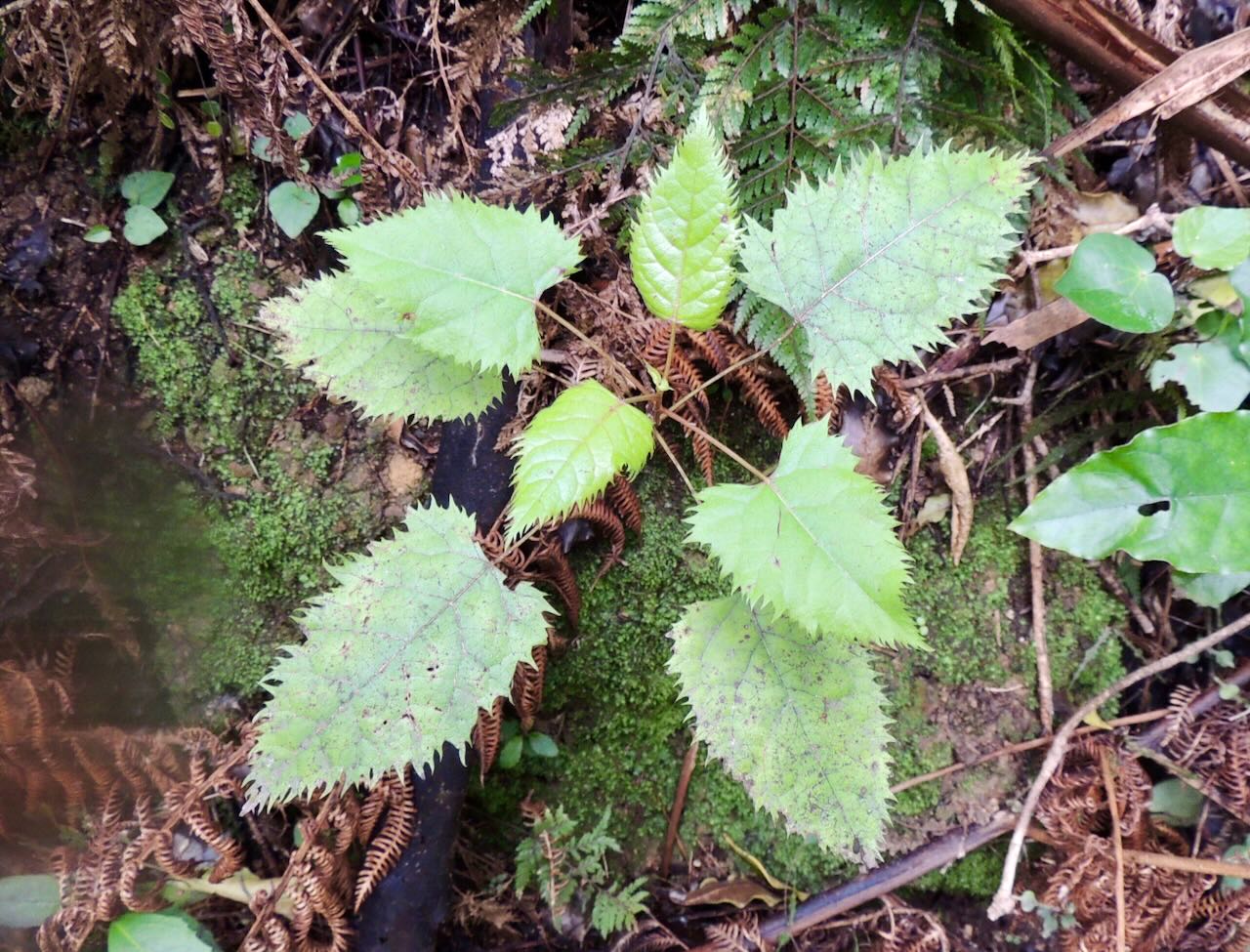 Wineberry Leaves
Wineberry Leaves
 Pic's Peanut Butter Headquarters
Pic's Peanut Butter Headquarters
 Peanut Butter Milkshakes
Peanut Butter Milkshakes
 Bird's Nest Fungus
Bird's Nest Fungus
 California Quail
California Quail
 Nelson Sunset
Nelson Sunset
 Glowworms
Glowworms
 Weta at Brook Waimarama Sanctuary
Weta at Brook Waimarama Sanctuary
Tuesday, September 24, 2024
Rebecca showed me around her garden this morning. We then went to Boulder Bank, but the tide was not right to see Bar-tailed Godwits. After I mailed a postcard, we took a drive into the hills, which had beautiful views of the city. After lunch, we went back to Boulder Bank and saw godwits. The name means "good creature", because people thought they were good to eat. A friend once said that the collective noun for these birds should be a "pantheon of godwits." Today, a pantheon of about 1,000 newly arrived Bar-tailed Godwits was pretty far away from the shore from where we viewed them, but not as far away as the ones on Saturday. To get to the place on the shore to see them, we had to walk a few hundred yards in winds blowing into our face at more than 30 miles per hour. The arrival of the godwits in New Zealand is in some ways treated like the return of the swallows to San Juan Capistrano used to be treated. Some New Zealand churches ring their bells to commemorate the return.
We then went to a beautiful area at Cable Bay. The water was a deep bluish green, almost like the water I saw in Banff. On the way up a hill to get a better view, I saw two Yellowhammers on some steps. (They are buntings.) We encountered two young Frenchmen who were in the midst of a one-year walking tour of New Zealand. They seemed very happy, like most people I met in New Zealand, either native or foreign. When driving back, we stopped to look at some Australasian Swamphens feeding in an enclosed area with two large bulls and a bunch of chickens. We later saw some Royal Spoonbills, who were quite far away.
This morning when I looked out the window, I saw a rainbow. A bigger rainbow appeared later. Tomorrow morning, the temperature is supposed to dip below 40 degrees F before warming up. Last week, parts of the South Island had snow. I sat next to a woman on my flight to Nelson who said that the previous week, the temperature in Christchurch dipped into the 20s. I am glad I brought the coat I wore when I was in the Antarctic in 2016 (the trip where I met Rebecca).
 View of Nelson
View of Nelson
 Bar-tailed Godwits
Bar-tailed Godwits
 Cable Bay
Cable Bay
 Australasian Swamphen
Australasian Swamphen
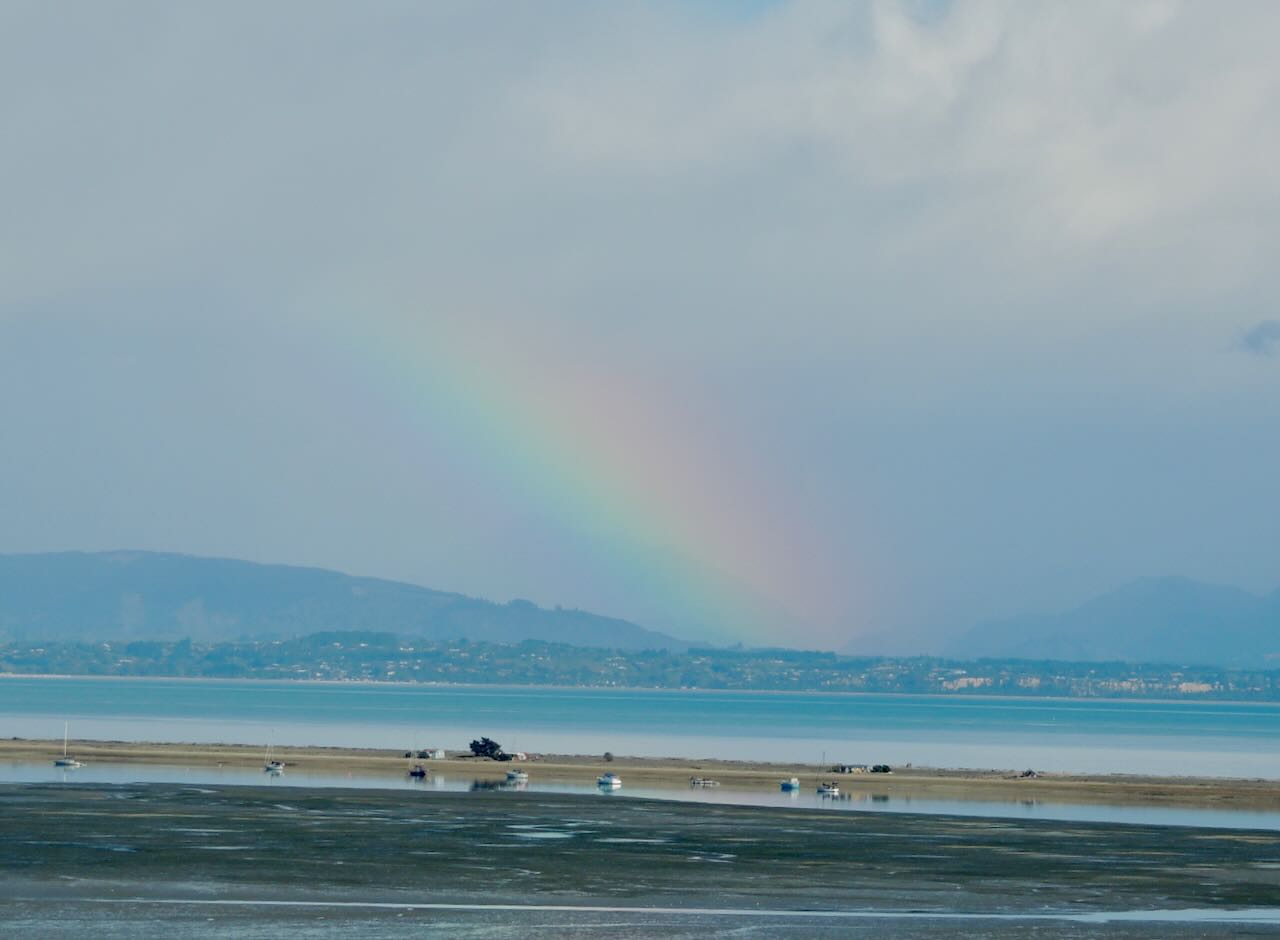 Nelson Rainbow
Nelson Rainbow
Wednesday, September 25, 2024
We spent the day at Nelson Lakes National Park, which is about an hour and a half from Rebecca's house. The scenery in the park is spectacular — snow-capped mountains, crystal clear water, clean mountain air. Mallards in the parking lot and at the lodge were looking for a handout. The jetty next to the parking lot had a pair of Black-billed Gulls, a new species for me. They look like Red-billed Gulls with black bills and black legs. A lot of New Zealand Scaup swam near the shore, and in the afternoon, there was one Black Swan. On the hikes we took, we saw few birds, but the flutelike notes of the Tui and Bellbirds provided the soundtrack. Bellbirds were new for me. They are green like the Bell Miners in Australia.
Nelson Lakes is mostly beach forest. Unlike the deciduous beech trees in North America, the New Zealand beech trees are evergreens, as are most New Zealand trees. Along the paths were a lot of Crown Ferns, which have long fronds and form dense ground cover in places. The fronds are quite long and have been eaten as greens, and the roots have been used to make a poultice for boils. Some of the trees had Bracket Fungus, which could be either small or quite large.
On the way back, we drove past a lot of holiday homes, which are called "batches". We stopped to visit Rebecca's friend Nola, whose house has a spectacular view of the mountains. Nola gave us home-made cookies which she said are like a yo-yo (which is a type of cookie). I sat in her yard and enjoyed breathing the clean air while looking for birds. However, outside the park were a lot of areas where the trees had been logged, leaving large expanses of stubble. Yesterday, we had seen a lot of Monterrey Pines (Pinus radiata) which are raised for timber. They have spread to many places. There was an enormous amount of gorse, which is now in bloom. All along the highway one sees patches of yellow gorse flowers. It was brought to New Zealand from Scotland and is really nasty stuff.
The problem with invasive species in New Zealand is enormous. One reason there are so few bird species is that many of them have been wiped out by invasive predators, such as stoats, weasels, rats, and others. The only two native mammals in New Zealand are bats, who do no harm to birds. The Maoris brought over rats, mainly to eat, and the rats killed a lot of ground-feeding and ground-nesting birds who had never before encountered mammalian predators. The Europeans brought rabbits, also for food. The rabbits soon reached plague proportions, and to try to control them, the Europeans introduced stoats and weasels. Possums, who were introduced from Australia, eat huge amounts of foliage, thereby decreasing habitat for many nesting birds. They also eat the eggs, chicks, and adult birds. Nelson Lakes, as well as many parks I visited, had traps for catching rats and other predatory invasive mammals. Peter, who took us to see the glowworms, showed me a map with the locations of 300 traps and tunnels that the Brook Waimarama Sanctuary has positioned to try to control predators. As a result of all the predators, many bird species have either gone extinct or are found only in predator-free areas, especially offshore islands where predators have been eliminated. New Zealand has vowed to be predator-free on its two main islands by 2050, but I doubt they will be able to achieve this. Still, they should be applauded for trying.
 Nelson Lakes National Park
Nelson Lakes National Park
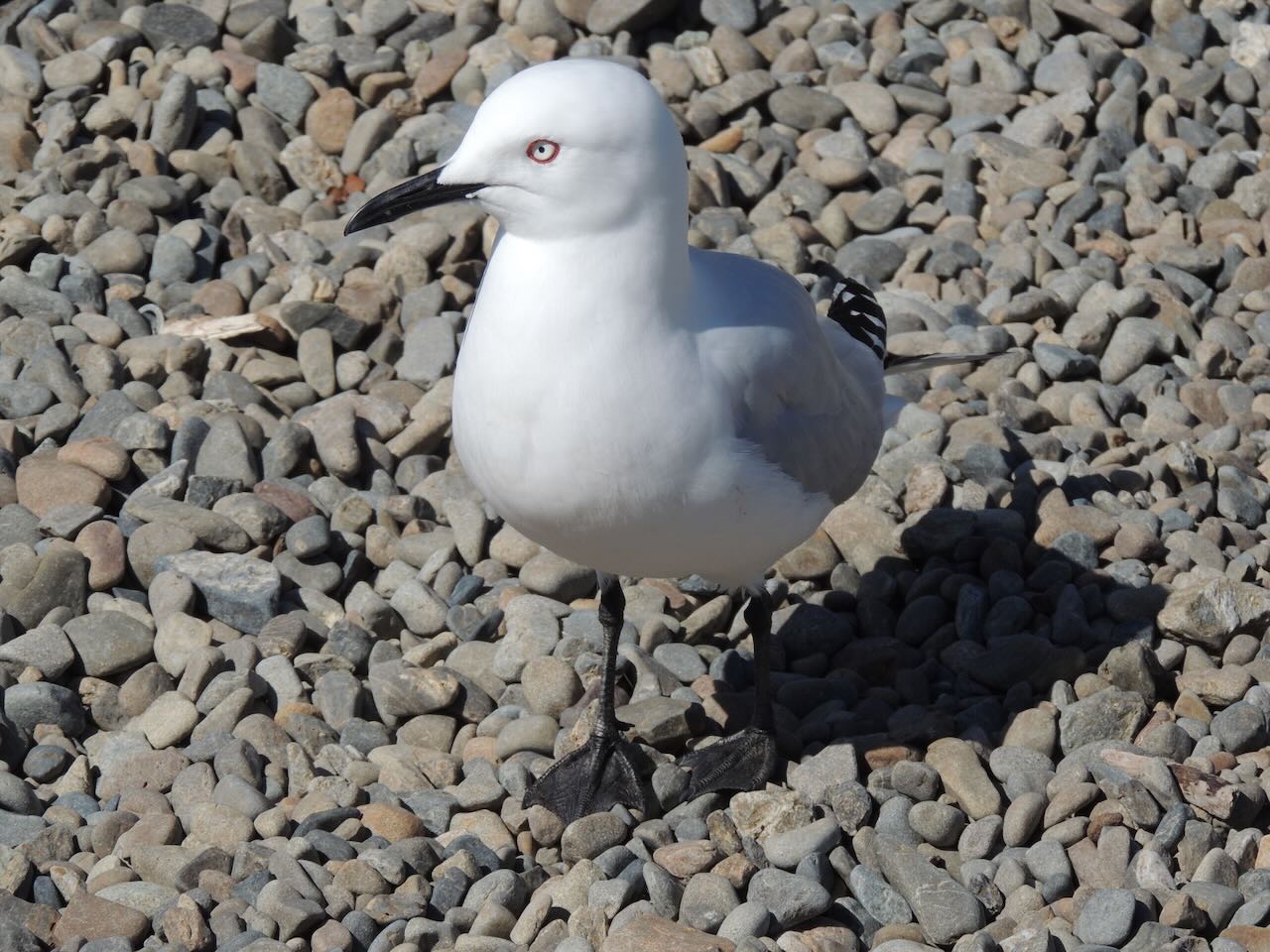 Black-billed Gull
Black-billed Gull
 New Zealand Scaup
New Zealand Scaup
 Crown Ferns
Crown Ferns
 Bracket Fungus
Bracket Fungus
 View from Nola's House
View from Nola's House
 Rat Trap at Nelson Lakes National Park
Rat Trap at Nelson Lakes National Park
Thursday, September 26, 2024
Rebecca brought me to the Brook Waimarama Sanctuary (the glowworm place) so I could see it in the daylight. We saw some of the glowworm strands, although we could not see the glow in the daylight. We didn't see many birds. The Tui and Bellbirds were singing all over the forest, and I saw a few of them. A couple of California Quail were on a path ahead of us. The only new species I saw was a Tomtit. A pair was flitting low as we walked along a path. They were close to us, but very active. The male was black and white with some yellow below, while the female was duller. She hung around longer than he did. This is not the same species that was sung about in The Mikado.
The area where we hiked was formerly used by the town of Nelson for its water supply. In looking at how clear the water is in the sanctuary, I would have no qualms about drinking it straight from the stream. We mostly looked at trees, plants, and fungi. Along the paths was a shrub called Rangiora. The back of the leaves is smooth and grey. This plant is known as the bushman's friend. People wrote letters on it, and it was also used as toilet paper. We saw Kanuka trees, which are different from Manuka trees. The Kanuka has very stringy bark. On one of the paths were some Fuchsia trees, which are among the few deciduous trees in New Zealand.
Rebecca found a Green Hooded Orchid, the first New Zealand orchid I have seen. We saw Hen and Chicken Ferns, which are unusual in that rather than reproducing by sending out spores like most ferns, they produce small plants on top of their fronds and let them drop to the ground and take root. Rebecca found an Eyelash Fungi; if you look carefully around the edges, you can see a slight fringe that resembles eyelashes. The specimens were a bit old, and younger ones have more of a fringe. And we found some Scarlet Pouch Fungi, which appear to be little red pouches.
Today marked the first full week since I arrived in New Zealand. Despite all of the adventures I had had, I felt ever so relaxed, content, and at peace. Rebecca and I met on a trip to the Antarctic in 2016, and we have stayed in touch. Today, we both put on the jackets we were given on the trip, and Rebecca has sent the photos of the two of us in the jackets to two other people who were on the trip.
Rebecca has rarely worn her jacket since the trip, but I had worn mine every day in New Zealand. My body still had not adjusted to the cold temperatures, so I wore many layers under my jacket. When I flew from Auckland to Nelson, the woman sitting next to me said that the South Island had had snow and below freezing temperatures the previous week. I had not felt warm since arriving. Rebecca put an electric blanket on my bed, which helped a lot. Unlike the electric blankets in the US, which go on top of the person in bed, the ones in New Zealand go beneath the undersheet, and you sleep on top of them. That kept me warm at night. Spring has officially arrived in New Zealand, but I am very glad I decided to bring by Antarctic coat rather than a lighter one.
 Female Tomtit
Female Tomtit
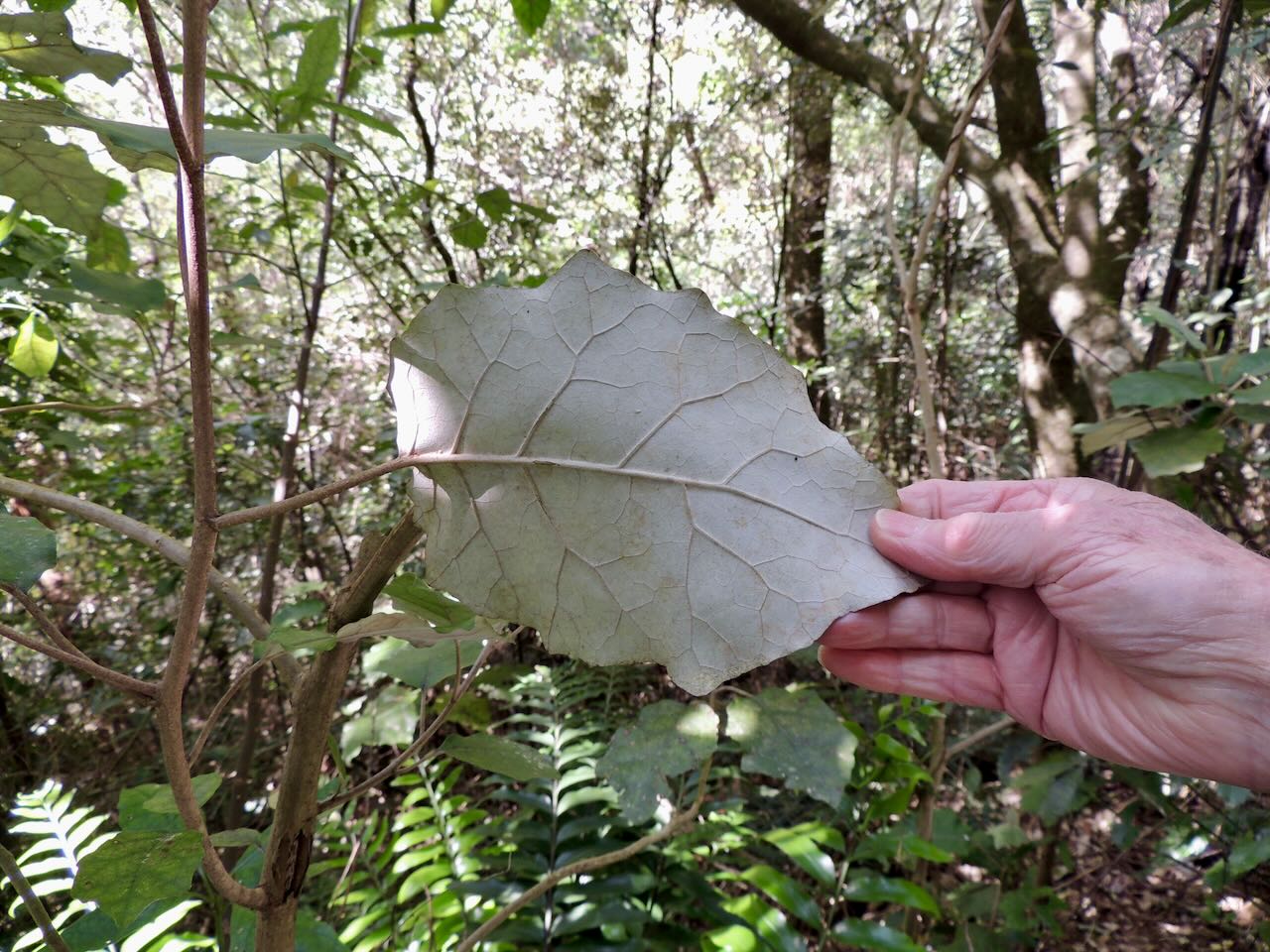 Rangiora
Rangiora
 Kanuka Tree
Kanuka Tree
 Fuchsia Tree
Fuchsia Tree
 Green Hooded Orchid
Green Hooded Orchid
 Hen and Chicken Fern
Hen and Chicken Fern
 Eyelash Fungi
Eyelash Fungi
 Scarlet Pouch Fungi
Scarlet Pouch Fungi
Friday, September 27, 2024
This morning was very windy, so we did not do much. We drove into the hills to look for New Zealand pigeons in Lucerne trees, but we didn't find any. We stopped at a house owned by an engineer named John. He is a hunter who goes after feral pigs and deer. It does not seem as bad as people who hunt native animals for sport. On the way over, we saw about a half a dozen Royal Spoonbills. Rebecca had not seen them there previously. We stopped briefly in a neighbourhood so that I could photograph some street art. Quite a lot of street art is scattered around.
Today was my final full day in Nelson. Even though I had no jet lag on my flights over, I'm glad I was able to stay with Rebecca at the beginning of the trip to become acclimated. Rebecca and Hanley have been very gracious and generous hosts, and I have felt totally at home while staying with them. I still needed to get used to getting in on the left side of the car.
Nelson is a very pleasant and civilized place. It has nature reserves and sanctuaries all over the city. I have not encountered any rude people. In fact, many seem to go out of their way to be polite. One senses that they understand that if they are polite and friendly to other people, others are more likely to be polite and friendly to them.
New Zealand has a goods and services tax, which is figured into all applicable purchases you make. And very few people in New Zealand tip. The amount on your restaurant bill is what you pay. I thoroughly dislike tipping and wish the US would go to the New Zealand system where the wait staff are paid higher wages, and restaurant customers know exactly what their meal will cost from looking at the menu.
The Maori influence is strong. I learned all of the English names for birds, but some people refer to the birds with their Maori names. For Instance, a fairly common bird I have seen is the Australasian Swamphen, who resembles the Purple Gallinule in the Americas. Most people here prefer the Maori name Pukeko. From this point on in my field notes, I will use more of the Maori bird names, which often are more useful. Many Maori names are based on a bird's vocalizations, which can assist in learning birdsong. America now is in the process of changing the names of birds who are named after people, which I think is a wise course.
Two of the biggest sports here are rugby and cricket, neither of which get much attention in the US. Rugby seems like a violent game, with people wearing no padding crashing into each other. I tried to learn more about cricket, but the rules are complicated. Some matches can last for five days. I watched quite a bit of a match between New Zealand and Sri Lanka, and Sri Lanka played much better.
I had a drama teacher in college who, when talking about all of the glitzy productions on Broadway, said, "You leave the theater whistling the props." In New Zealand, you leave places whistling the scenery. It is a beautiful place, and I look forward to beginning the second phase of my trip tomorrow.
 Nelson Street Art
Nelson Street Art
Saturday, September 28, 2024
I said good-bye to Rebecca and Hanley and began a two-week trip with my guide Steve Attwood. We drove East toward Picton through beautiful country, although I saw quite a few areas that had been logged and had only slash remaining. Steve said that New Zealand Falcons like areas with the slash for hunting. Some magpies were in the fields.
We stopped at the Pelorus Bridge Scenic Reserve. In a parking area was a New Zealand Pigeon. I had seen one while we were driving, but the one we saw in the parking lot was preening low in a bare tree. They are much bigger and more colourful than the Rock Pigeons seen in cities, and the feathers on their head and back are iridescent. Steve said the males do a parabolic display flight when courting females.
Steve showed me a Tutu plant, which is one of the few toxic plants in New Zealand. It produces a toxin called tutin. The plant has tops that look like asparagus. These were eaten by the Maori, sometimes with fatal consequences.
While we were walking through this reserve, Steve received a call from the company scheduled to take us on a boat to Blumine Island, a predator-free island in the Queen Charlotte Sound. The boat company thought we were supposed to go today rather than tomorrow. Steve hurried us off to Picton, where we got on a boat and began to explore the sound. Queen Charlotte Sound is also known as Totaranui. The area used to have Totara trees, and on the map, it is shaped like a totara tree.
The skipper was a knowledgeable man named Paul who knew a lot about the birds in the sound. On the way out, we saw two Little Penguins swimming not far from our boat. We passed a couple of New Zealand Fur Seals sunning themselves on rocks. Also on some rocks were a group of Spotted Shags — shags are in the same family as cormorants. Spotted Shags get their name from the spots on their back. A little later we saw a New Zealand King Shag, who is a very rare species. They are found only in this part of New Zealand, and there are probably about 800 left in the world. We also saw Pied Shags, who appeared to be quite large.
We saw Australasian Gannets, who are in the same family as boobies, and a couple were plunge diving. A lot of Fluttering Shearwaters were sitting on the water. Shearwaters get their name because they often fly low and appear to be shearing the water with one of their wings. Fluttering Shearwaters are named because they sometimes appear to flutter their wings, especially after taking off from the water. We saw quite a few Dusky Dolphins, who were swimming near our boat. Paul said that if you wave your hand outside the boat, the dolphins will come closer because they think you are communicating with them. Paul also said that sometimes people go to zoos to look at animals stuck in cages. But when people are in boats, it is the equivalent of people being in cages, while the dolphins are free to swim anywhere they want.
When we arrived at Blumine Island, I saw a few Weka walking around near where our boat landed. A Weka is a flightless rail, and they walk around looking for food and handouts. A couple Weka walked up to us and were about a meter away. Some Variable Oystercatchers were on the shore, and at one point, one of them chased the Weka, who hurriedly ran into the bush (they can't fly). Weka eat the eggs and chicks of other birds.
Blumine Island is one of the Islands that has eliminated predatory mammals, so some bird species who are difficult to find on the two main islands can be seen here. The island is covered with Manuka trees. One of the species we looked for is the Orange-fronted (Malherbe's) Parakeet. These parakeets are uncommon, but we found two in the trees not far from where our boat landed. One sat still among some branches in a nearby tree and was not easy to photograph, but I had good looks at it. A male Tomtit was in the same area. They have orange and yellow over the bill. The most common species in the areas where we walked was the Bellbird. Some appeared to be in territorial battles — it is spring in New Zealand when many birds are engaged in mating activities.
The Maoris were astute observers of birds, who were an important source of food on an island that had no mammals. They put information about the birds into stories and legends to help people learn and remember things about birds.
When Paul picked us up to take us back, we saw more dolphins, including one who jumped out of the water and did four backflips. We got close to a King Shag for photos. As with the Double-crested Cormorants in the DC area, these rare shags have pretty blue eyes.
On the way out, Paul commented on the many Moon Jellyfish who could be seen in the clear water. They are round and range in size from a saucer to a small dinner plate. All jellyfish sting, but the sting of this jellyfish is so mild that it cannot be felt. They are semi-transparent and odourless, and Paul said that Maori women used to put them on their face to soften their skin and treat conditions such as acne. Paul caught one and put it into my hands. It was a bit gooey and appeared to be dripping a viscous substance. When I dried my hands, they felt very soft, as if I had just treated them with skin lotion. On the way back, Paul caught a really big one and put it into my hands. This time, I massaged it into the front and back of my hands, and they felt very soft. My Hands still felt soft later in the evening.
Daylight Savings Time in New Zealand was scheduled to begin overnight in New Zealand, so the clocks were turned forward and I lost an hour's sleep. I was operating on a lot of adrenaline, so such time changes did not affect me much. Also, we were generally getting started around 7:30 in the morning, which is a civilized time by birding standards.
 New Zealand Pigeon
New Zealand Pigeon
 Tutu Plant
Tutu Plant
 Little Penguin
Little Penguin
 Spotted Shag
Spotted Shag
 King Shag
King Shag
 Fluttering Shearwater
Fluttering Shearwater
 Australasian Gannet
Australasian Gannet
 Weka
Weka
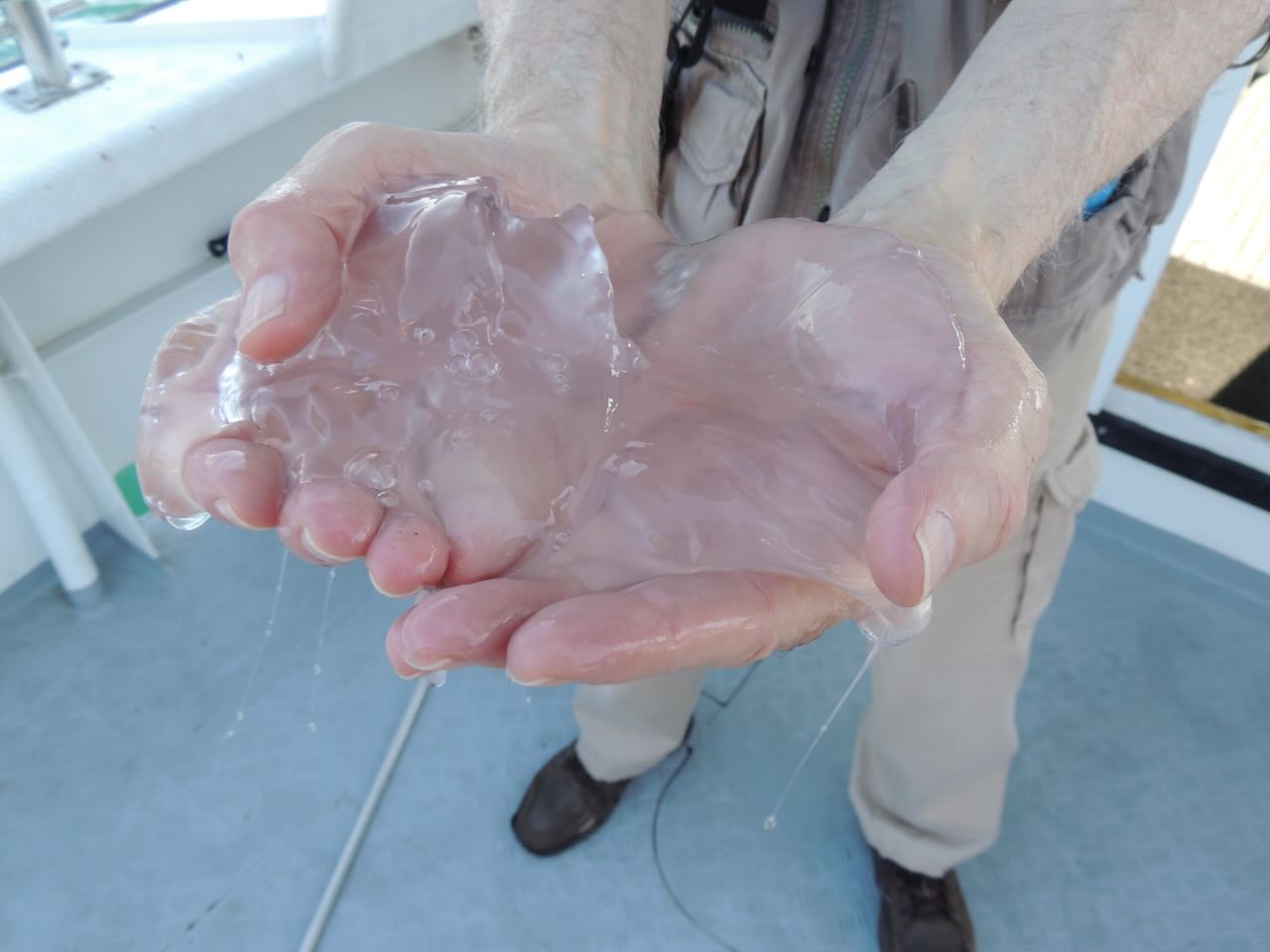 Moon Jellyfish - Photo by Steve Attwood
Moon Jellyfish - Photo by Steve Attwood
Sunday, September 29, 2024
We stopped at Taylor Dam, which has a large pond you can walk around. A lot of Black Swans, Australian Coots, and New Zealand Scaup were swimming there. We looked for New Zealand Dabchicks (a species of grebe), and we found two. When we walked around the circumference of the pond, we did not see them again. Steve said this part of New Zealand is about as far south as they get. A Great Cormorant and a Little Pied Cormorant were sunning themselves. We saw two European Goldfinches during our walk.
We spent the rest of the day walking through saltmarshes. The soundtrack in these marshes was singing skylarks, the birds who inspired Percy Bysshe Shelley and Ralph Vaughn Williams. Many skylarks were singing and doing display flights, which you need to experience to fully appreciate these birds.
We first went to the Wairau Lagoons in Blenheim and saw a nesting colony of Royal Spoonbills. They nest in trees, and some of them had their crests erected. We saw a New Zealand Pipit perched on a rock. They look very much like skylarks. There were a couple of Yellowhammers.
We had lunch in Seddon, which had been seriously damaged by an earthquake in 2013 measuring 6.5 on the Richter scale. New Zealand has a lot of earthquakes, and a website reports the earthquakes that occur every day.
We then headed to Lake Grassmere and hiked along a path next to the Pacific Ocean. I spotted a Greenfinch in the top of a tree. We saw a magpie attack a harrier. We did not see the species we had hoped to see, but we saw Canada Geese, Pied Stilts, Mallards, shovelers, Grey Teal, and Caspian Terns.
We also saw a lot of plants, including Vegetable Sheep. It is named because from a distance, it looks like a sheep. The Maori name for it is tutahuna. We walked past ice plants, which have yellowish centres and thin pinkish petals. Purple Groundsel has bright purplish petals around a yellow centre.
 New Zealand Dabchick
New Zealand Dabchick
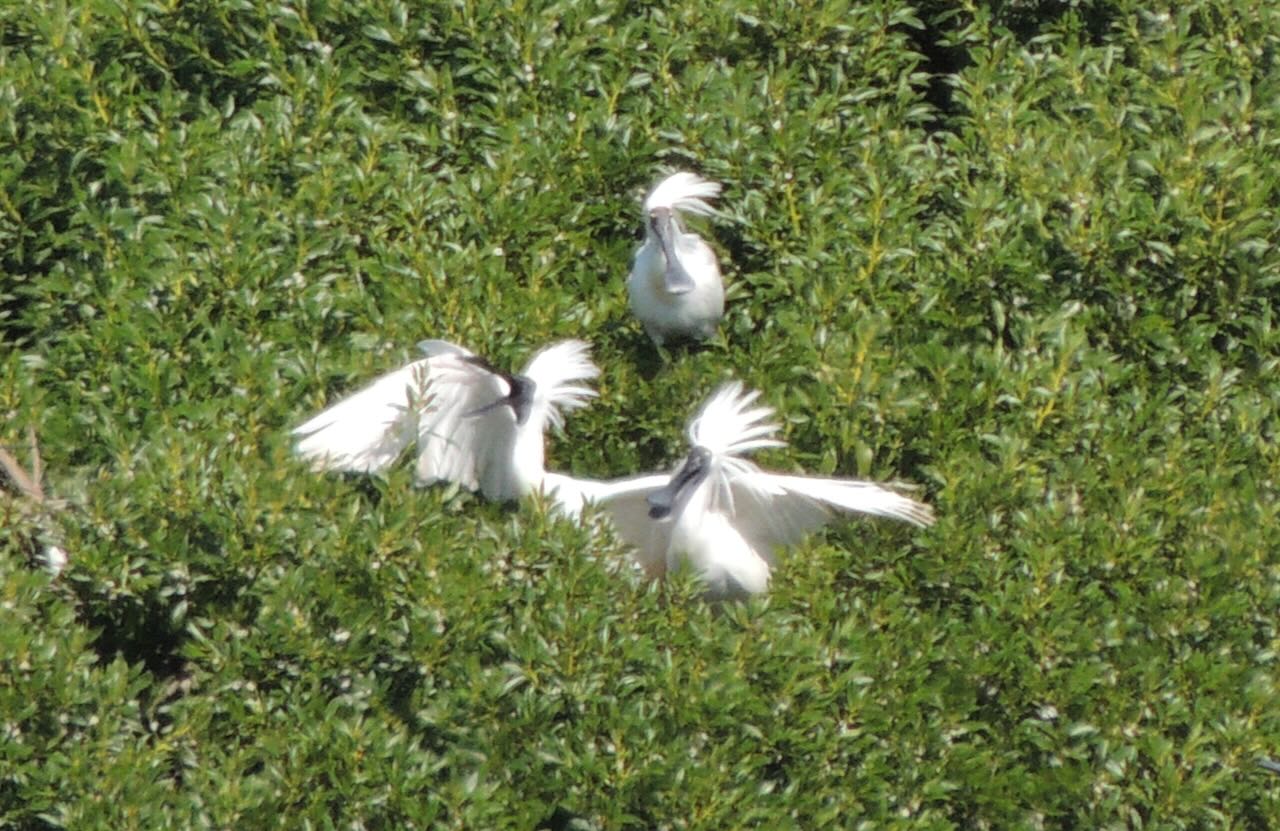 Royal Spoonbills
Royal Spoonbills
 Eurasian Skylark
Eurasian Skylark
 Vegetable Sheep
Vegetable Sheep
 Ice Plants
Ice Plants
 Purple Groundsel
Purple Groundsel
Monday, September 30, 2024
We rode from Picton to Kaikoura. Kaikoura means "lobster food", because it is a place where the Maoris found a lot of lobsters to eat. (Kai means food and koura means lobster.) At one place we stopped, we walked on an area that had been sea floor before the massive 2016 earthquake lifted the land 4 to 5 meters. Many of the roads in the area had to be rebuilt after being destroyed by the quake.
Our first stop was Lake Elterwater, where Steve hoped to find a Hoary-headed Grebe. We saw two New Zealand Dabchicks, Black Swans, scaup, and other waterfowl, but no Hoary-headed Grebes. We next stopped at Kekerengu and saw Pied Stilts, Masked Lapwings, and a Dunnock. At Ohau (pronounced OR-hoe), we saw a colony that had Silver Gulls, Spotted Shags, and New Zealand Fur Seals. A great many Seals were lazily lying on the rocks. A few big bulls were moving around, and there were a lot of pups. One place near the colony had a stretch of water, and some young seals appeared to be playing as they swam. Near the observation point were a lot of Rock Daisies.
Cormorants had nests on top of the rocks and in rock crevices. A lot of guano was on the rocks. We saw an Eastern Reef Heron, which was a new bird for me. It is smoky grey, the colour of the rocks, with yellow feet which stick out when the bird flies. I had a good look at it flying low across the water, but I never saw it standing up. The bird is hunched when flying.
We stopped for lunch in Kaikoura, which had some street art. In the afternoon, we went to an area where Banded Dotterels nest. These plovers are having the same problems as certain species of plovers in the US, with people driving vehicles through their nesting areas on beaches or allowing their pets to run wild. If you stand still on the beach, the dotterels sometimes come very close to check you out. One came to within 10 feet of me. Many of the dotterels had bands of different colours on their legs. Coloured bands are put on the legs so that researchers can identify and monitor the behavior of individual birds.
We later went to a different area of South Beach and saw a Little Black Cormorant on the rocks with a lot of Pied Shags.
The scenery today was really beautiful. In many places, I could see snow-capped mountains or ocean. The only thing between me and South America is the Pacific Ocean. At times, it was fairly breezy because of the wind coming off the ocean. My body was becoming a bit more acclimated to the cold, but I still had a long way to go to catch up with the New Zealanders. I was wearing four layers under a heavy coat. Lots of people (including Steve) wore shorts. I saw numerous people wearing short-sleeved shirts. One schoolgirl, who appeared to be about 10 years old, was walking around in a short-sleeved cotton dress with nothing on her legs.
 Floor of the Pacific Ocean
Floor of the Pacific Ocean
 New Zealand Fur Seals
New Zealand Fur Seals
 Red-billed Gull
Red-billed Gull
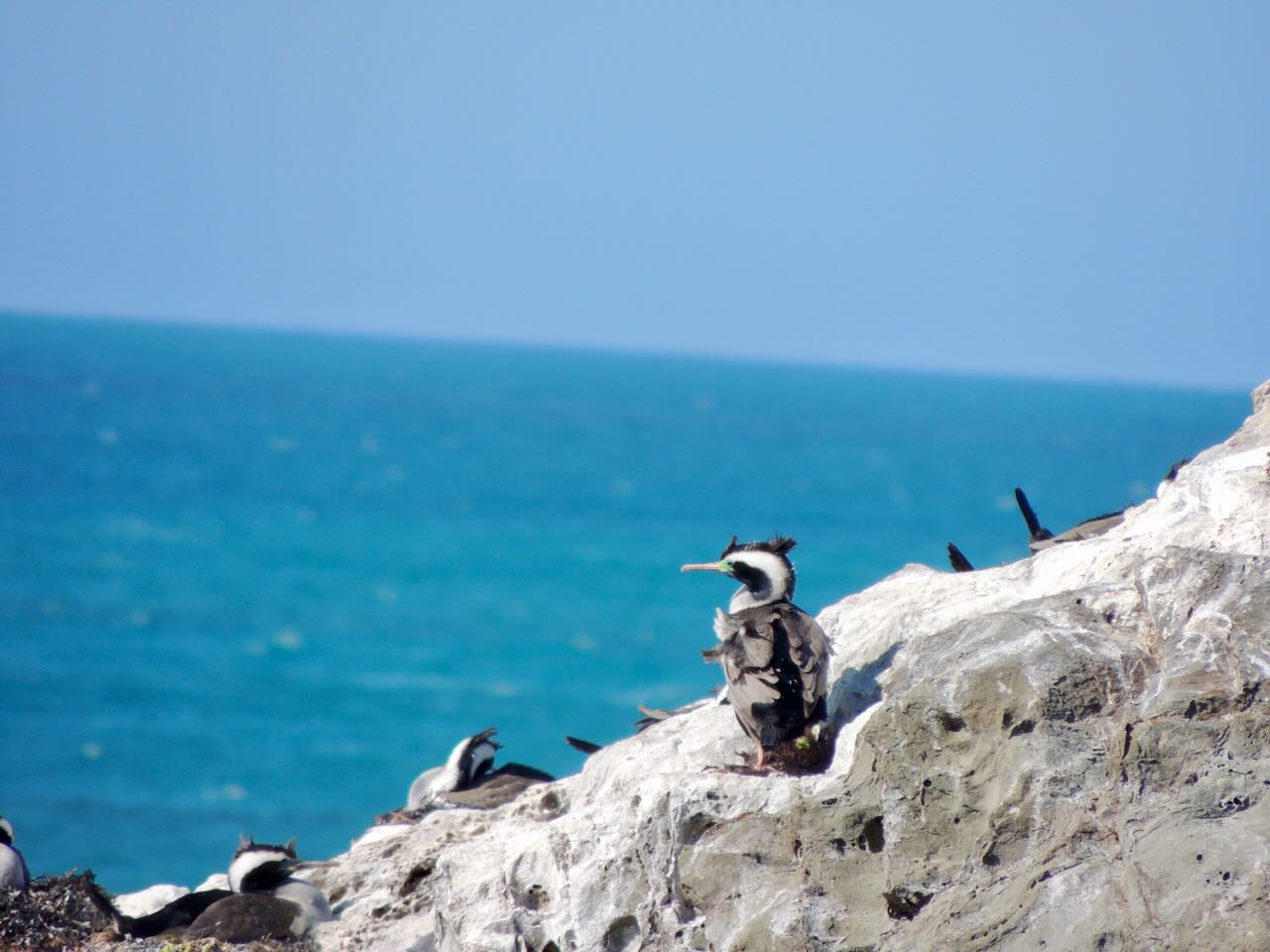 Spotted Shag Colony
Spotted Shag Colony
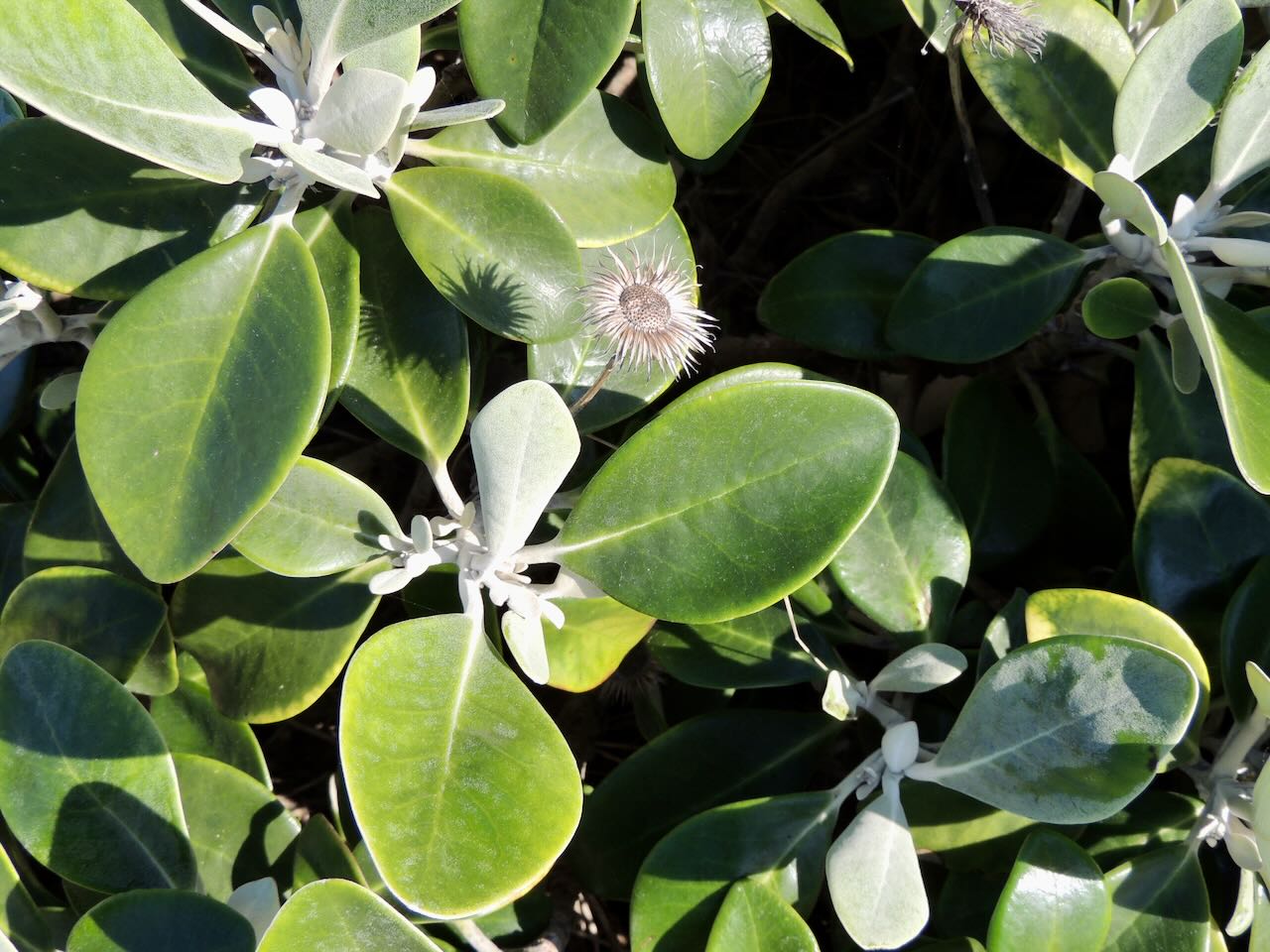 Rock Daisy
Rock Daisy
 Kaikoura Street Art
Kaikoura Street Art
 Female Banded Dotterel
Female Banded Dotterel
Tuesday, October 1, 2024
We went on a 4-hour Albatross Encounters pelagic trip with our skipper Gary and two other birders from Christchurch: Annie, a relatively new birder who really knows her seabirds; and Mahan, a man from Iraq who is primarily interested in photographing birds. He was fairly quiet, and Steve told me that his wife had been killed in the 2011 Christchurch earthquake.
Near the beginning of the trip, we saw Hector's Dolphins near the boat. They are the smallest dolphins in the world at only 4 or 5 feet long. On the way back, we saw Dusky Dolphins swimming near our boat. We saw a fishing boat and went toward it, because a lot of seabirds were near it. Gary threw a bag attached to the boat into the water. The bag had holes in it and was filled with fish meat. The birds attacked it and each other, but oddly, most did not seem to want the fish that they managed to pull out of the bag. Gary said they were interested in getting at fish liver and did not care about the rest.
In most of the scrums, the major players were Wandering Albatrosses, Northern Giant Petrels, and Cape Petrels. The biggest birds in the group were the Wandering Albatrosses. They have one of the longest wingspans of any bird in the world, at about 12 feet. The first one I ever saw was so big compared to other birds that it looked like a pterodactyl.
The Giant Petrels are not as large as the Wandering Albatross, but they are as large as some of the smaller albatrosses. They are big and appear to have a crazed look in their eyes, but they are not as big as the Wanderers. The aggressive posture of the Giant Petrels involved spreading their wings and sticking their rounded tail in a vertical position. They squabbled with each other and with the Wanderers. Some of the Giant Petrels appeared to be a bit older, having light feathering on the face. We later saw a couple of Southern Giant Petrels, who look almost identical, except they have a greenish tip to their bill.
The smallest birds in the group were Cape Petrels, who are small, with black-and-white plumage. Because of the patterns on their feathers, they are sometimes called Pintado Petrels. Pintado means painted, and the scientific genus name for this species is Daption, which is an anagram of pintado.
Red-billed and Southern Black-backed Gulls lurked on the outside of the scrums, realizing they had no hope of getting anything with these huge birds around. It was one of the few times I have felt sorry for gulls. There is a sign at Albatross Encounters warning people to protect their food from gulls and saying people will not be reimbursed if their food is stolen.
Photography on a pelagic trip is difficult. The boat is moving, even when it is not going forward, so one rarely can take a stabilized shot. Also, I was sitting on the box containing the motor, which was constantly vibrating, so my butt was a little sore by the end of the trip.
Identifying seabirds is difficult. The Wanderers and the Northern and Southern Royal Albatrosses all look similar. The Wanderers have more white on their back, the Southern Royal has darker wings, and there is no black line on its bill. The Northern Royal has the blackest wings, and there is a black line on the bill.
The smaller albatrosses are sometimes called mollymawks. We saw Salvin's Albatrosses, who are mollymawks who have a grey head and what appears to be a permanently furrowed brow. The White-capped (Shy) Albatross has a white head and a grey bill with a yellow tip. We saw one Black-browed Albatross, who has black wings. Annie said it appears to be wearing mascara and lipstick.
We saw two dark seabirds. Quite a few Westland's Petrels were around. They are all chocolate brown. One Short-tailed Shearwater circled our boat and at times rested on the water. It was smaller than the Westland's. One Grey-backed Storm-Petrel briefly made an appearance. It was not all dark and looked white below. Before the end of the trip, we stopped by a rock that had a lot of White-fronted Terns. They are natty and stern looking, with a black bill and black cap that accentuate their white body. Some Rock Pigeons were on the same rock, and below were some fur seals.
In the afternoon, we went with Ted Howard to help with a Hutton's Shearwater nesting project. Ted's wife Alisa coordinates the Banded Dotterel nesting project. Ted took us to the site, which is on land owned by a Maori farmer who raises cattle. We rode in a small jeep that was full of dog hair. Ted and Alisa are both quite intense. Alisa gets up at 4 in the morning and plays the piano. I noticed in their house was a copy of Sartre's On Being and Nothingness.
The Hutton's Shearwaters breed in burrows on a hillside. At this site, a tube at the base of the box leads to a nesting compartment in the back, which has a black cover. If the sticks in front of the tube have been knocked down, the shearwaters might be inside (although often none are). The box contains data recording equipment, and Ted needed to periodically record the data, which is what Steve and I helped with. The shearwaters have numbered leg bands, put on by scientists. If birds were in a burrow, Ted had to pick them up and read the band number to me. The birds do not like to be handled, and a couple of them drew blood when they could latch onto a finger or hand. This project and the one Alisa coordinates are labours of love, and the dedication of the people involved is amazing.
 Wandering Albatross
Wandering Albatross
 Northern Giant Petrels and Cape Petrels
Northern Giant Petrels and Cape Petrels
 Cape Petrel
Cape Petrel
 Northern Royal Albatross
Northern Royal Albatross
 Salvin's Albatross
Salvin's Albatross
 White-capped (Shy) Albatross
White-capped (Shy) Albatross
 Black-browed Albatross
Black-browed Albatross
 Westland Petrel
Westland Petrel
 Short-tailed Shearwater
Short-tailed Shearwater
 White-fronted Terns
White-fronted Terns
 Hutton's Shearwater Study Site
Hutton's Shearwater Study Site
 Hutton's Shearwater Nest Burrow
Hutton's Shearwater Nest Burrow
 Hutton's Shearwater Egg
Hutton's Shearwater Egg
Wednesday, October 2, 2024
This morning, we drove from Kaikoura to Reefton through beautiful rolling mountains and hills. The weather held out for most of the day until we neared Reefton, at which point the rain became heavy. The hills and mountains are the result of some of New Zealand's faults. The Pacific and the Australasian Plates are under New Zealand's South Island. Over millions of years, the movements and collisions of these plates have resulted in the mountains and hills. We stopped at Marble Hill on the way to Reefton which is on the Alpine Fault line. An 80-foot wall is built right on the fault line, and scientists periodically measure how much the wall moves over time.
We saw a map (pictured below) with red lines that look like a Dali-esque pitchfork. The very long line running through the middle is the main fault line. The prong on the right ends at Kaikoura, where we were yesterday. Ted, the man whom we helped with the Hutton's Shearwater study, said that at one beach in Kaikoura, the ground rose 8.6 meters, which is more than 28 feet. The South Island is very vulnerable to earthquakes, and as in Los Angeles, some people here worry that "the big one" might happen. In a few weeks, I will be heading to the North Island, where the concern about earthquakes is not as great. On the North Island, they only worry about volcanoes.
We stopped at Hanmer, which has a lot of forested area. We did not see anything unusual. I managed to photograph a New Zealand Fantail, a friendly little bird who allows you to get close, but rarely stays still. It repeatedly fans its tail while flitting through the trees. We saw Silvereyes, who are common birds. I took a photo of one who was foraging while upside down. These birds frequent flowering trees, and one often sees them in odd postures. In one area, I saw an Australian Coot (which looks like an American Coot) swimming in a pond.
At the stop with the fault wall, a number of New Zealand Pipits foraged on the ground. They are LBJs (little brown jobs) who resemble skylarks, and they constantly flick their tail while foraging.
The only new species I saw today was a Black-fronted Tern. I could not take any photos, because the terns were flying around in a farm field. They are an endemic species, which means they are native only to a particular place — in this case, New Zealand.
We had dinner at the Dawson Hotel, which had slot machines. Gambling is tightly regulated in New Zealand, but it is still openly done. I saw casinos in some of the cities I visited. The police generally do not arrest people for cannabis use, unless someone is driving while under the influence.
In Reefton, which is in the western part of the South Island, we stayed at the Reef Cottage B&B. Reefton is an old gold mining town which had profitable mines in the latter part of the 1800s and the early part of the 1900s. This B&B used to be a bank where prospectors brought their gold. I was assigned to the Vault Room. My toilet was in a room that was formerly the bank's vault. The metal door was really heavy, and it had a burglar proof insignia on it. Because the door was so heavy, I left it open, which defeated the whole purpose of having it.
 South Island Fault Lines Map
South Island Fault Lines Map
 New Zealand Fantail
New Zealand Fantail
 Silvereye Foraging Upside Down
Silvereye Foraging Upside Down
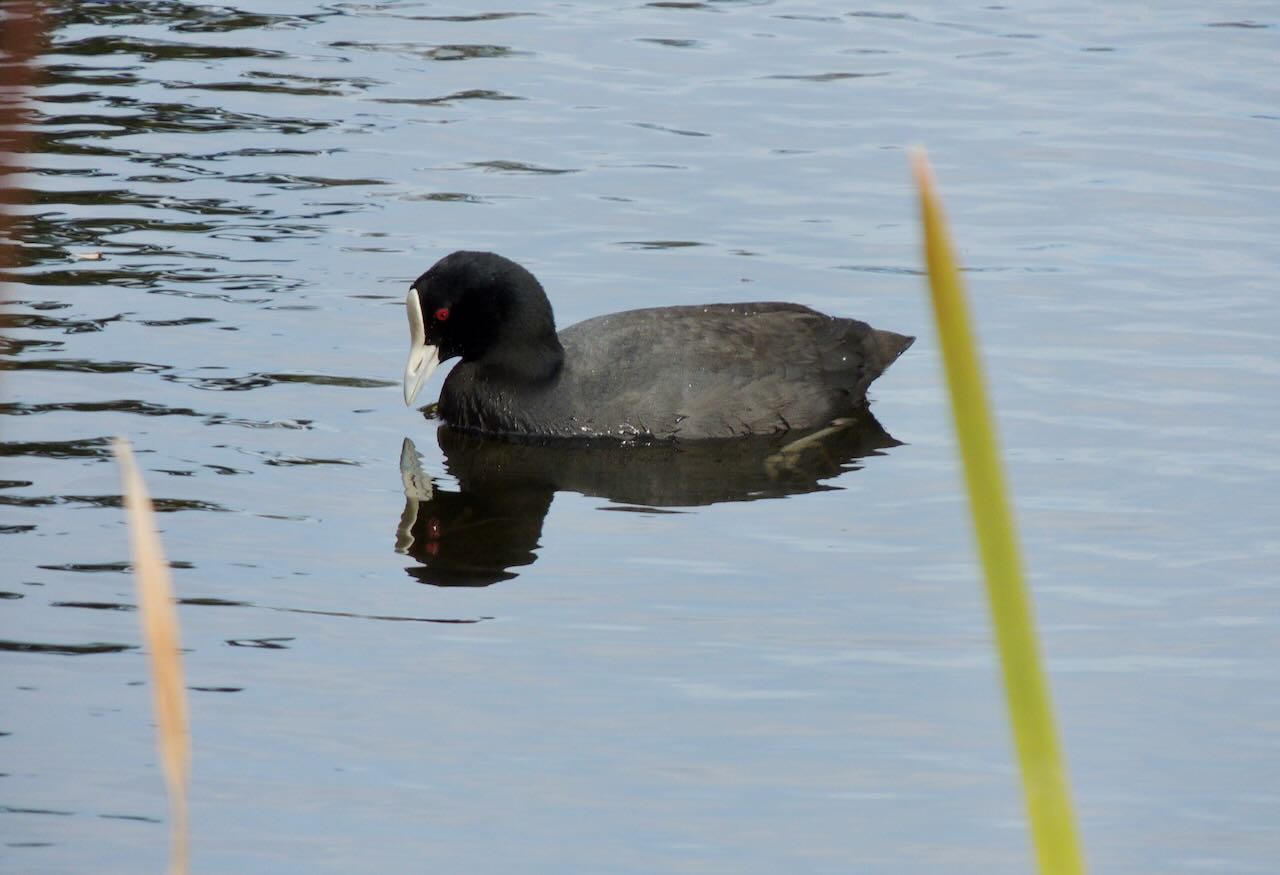 Australian Coot
Australian Coot
 New Zealand Pipit
New Zealand Pipit
 Bank Vault Bathroom Door
Bank Vault Bathroom Door
 Insignia on Bank Vault Bathroom Door
Insignia on Bank Vault Bathroom Door
Thursday, October 3, 2024
During my trip, I saw very few people in New Zealand use umbrellas when it rains. Most put on a covering, scrunched up their shoulders, and walked into the rain. People had to do that a lot over the past two days. The rain yesterday was part of a storm system heading north, which was the direction we had planned to go. Instead of spending the day in heavy rain, we headed south toward Greymouth on the west coast of the South Island. We drove through rain and low clouds, passing a lot of pasture with grazing sheep, cows, llamas, and other animals. We saw at least six Weka, including two juveniles. Lots of Paradise Shelducks were in the fields, and there were also some Pukeko.
When we arrived at a place called Pancake Rocks in the Paparoa National Park, the weather began to clear, allowing us to enjoy a remarkable natural spectacle. Imagine a stack of pancakes made of limestone which formed 35 million years ago from the remains of dead animals. The spaces between the pancakes came from weathering. All around this area were huge stacks of these limestone pancakes at the edge of the Tasman Sea. The sea came swirling into some of the places which had blowholes, shooting water straight into the air, sometimes with a loud bang. The amount of water shooting out of the blowholes is greater when the sea is agitated, which it was because of the weather front that had just passed through. I recorded video of the phenomenon. The pancakes had colonies of White-fronted Terns nesting on them, and I recorded video of two of them mating.
One set of rocks had a Red-billed Gull colony. Another set had shapes which appeared to be figures of humans and other animals. The area with all the rock formations and blowholes was at the end of a path lined with native trees and ferns. All in all, visiting Pancake Rocks was an exhilarating way to start a day that seemed destined to be a washout.
We later went to a nearby beach and saw two Variable Oystercatchers. The weather was a bit blustery, and each of the oystercatchers stood on one leg. Shorebirds sometimes do this to preserve body heat. Their legs are not feathered and can lose heat faster than other parts of their body. What was odd is that when I walked toward them, they did not run or fly away. Instead, each one hopped on one foot as if playing hopscotch. They seemed to be saying that I might be getting too close but not close enough for them to take major evasive action. I had never seen birds do this.
We headed over to a temperate rainforest in Moana next to Bruner Lake, which has a view of the New Zealand Alps. The sun came out, and we saw a few birds — a pair of Tomtits (male and female), Grey Warblers, New Zealand Fantails, Tui, Bellbirds, and others. We were looking for Riflemen and Fernbirds, but we arrived too late in the day to have much of a chance.
After lunch, it began to rain. In Greymouth, we saw a couple Pied Stilts, a Great Cormorant, and a Paradise Shelduck, but not many other bird species. There were quite a few Prince of Wales Feather Ferns, which were named for their resemblance to feathers worn in the ceremonial headgear of the Prince of Wales.
We went out in the early, but the rain started again, and we called it a day. West of the New Zealand Alps is much rainier than the east side. I had hoped to go to an area that night to see glowworms, but the rain was not forecast to stop until early the next morning.
The name "Greymouth" comes from the fact that the town is at the mouth of the Grey River. At the restaurant in the hotel, I ordered a plate of Green-lipped Mussels, a New Zealand specialty. The shell of this mussel has green edges. Many pharmacies in New Zealand sell a variety of supplements containing Green-lipped Mussels, which apparently have a number of beneficial properties, including helping to alleviate symptoms of arthritis for some people. I don't have arthritis, but my butt is still a bit sore after sitting on the vibrating motor box on the boat during the pelagic trip a couple days ago.
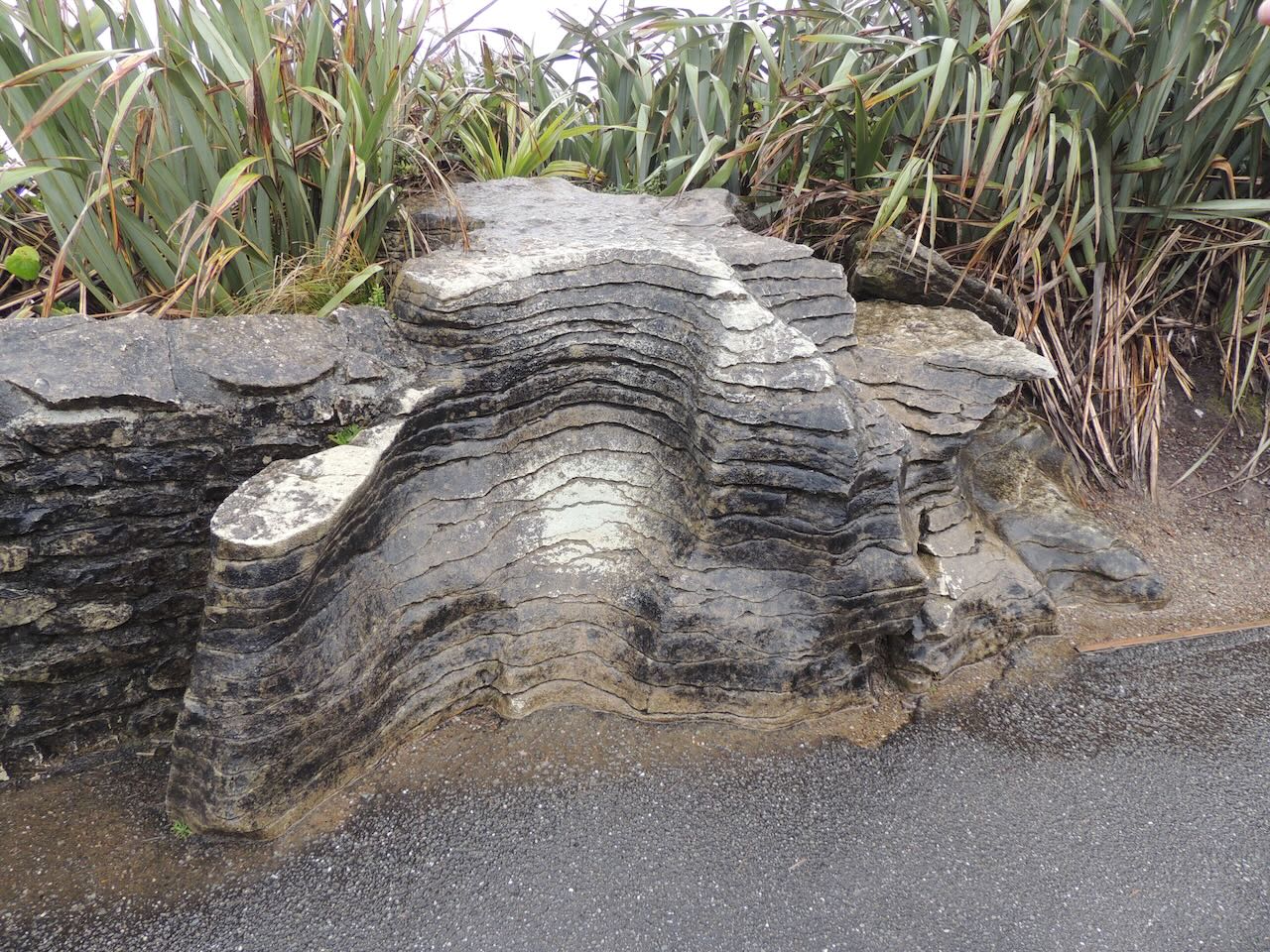 Pancake Rocks
Pancake Rocks
 Pancake Rocks
Pancake Rocks
 Mating White-fronted Terns
Mating White-fronted Terns
Friday, October 4, 2024
This morning when returning from breakfast, a Weka was walking near my room. The bird came pretty close to me.
The rain had gone, and the sun was shining. We drove to Woods Creek, which had been an old gold mine. In fact, on the way we passed through an area where gold mining was still taking place. Big machines were doing excavation. After we arrived, I photographed a male Tomtit, flitting among the branches. The only new bird I saw was a Brown Creeper, a small robin-like bird who flits around quickly and doesn't stay still. It is often seen in flocks with Silvereyes.
Bird names can be confusing. The US has a species called a Brown Creeper who is nothing like the New Zealand bird, who is a small active bird who flits around in the trees. The Brown Creeper in the US creeps along tree trunks like a woodpecker.
An example of how confusing bird names can be is that I see Red-winged Blackbirds in the Washington, DC area. This blackbird is not related to the Eurasian Blackbird (a very common introduced species in New Zealand), who is in the same genus as the American Robin, who is not related to the robins seen in Europe, who in turn are not related to the robins seen in New Zealand. At times, I wish that the common names of many birds could be changed to eliminate this confusion.
We birded in temperate rainforest habitat and then in a wetland habitat on the other side of Brunner Lake. Not many birds were around, but Steve showed me the leaves of an Easter Orchid plant. It blooms around Easter, so we did not see any of the flowers.
We also saw a LOT of gorse. I have seen flowering gorse almost everywhere I have been in New Zealand. A friend warned that I should not "put on my invasive plant goggles", because once you put them on and learn what various invasive plants look like, you begin to see them everywhere.
Tonight after dinner, we went to Lake Bruner to look for bitterns, penguins, and glowworms. Bitterns skulk in the reeds, but they often become more active at dusk. We could see the mountains of the New Zealand Alps in the background. We did not see any bitterns, but we saw more Weka running around in the adjacent picnic area. We then went to look for penguins, who have burrows along a long stretch of the shore of the Tasman Bay. To reach the beach where they might come ashore, we had to walk ten minutes through rainforest. We then sat on the shore and waited as the colours of the sunset diminished from the sky over the rolling waves. We did not see any penguins, but the experience was beautiful and contemplative.
Walking back through the rainforest in the dark caused me to look at the ground that was lit by my flashlight. I saw all the ferns and other flora that I sometimes overlook when walking through a forest and looking for birds up in the trees.
Our final stop was a glowworm dell. We had to walk a few minutes through forest to get to a spot where a lot of glowworms were concentrated. As with my previous visit to see them, the area reminded me of a planetarium with hundreds of twinkling stars.
In a number of places, I saw electronic signs that said "BILL IS BORED". I think it had something to do with a marketing plan for a book. In any event, it certainly was not the case while I was in New Zealand.
 Weka
Weka
 Male Tomtit
Male Tomtit
 Gorse
Gorse
 Expanse of Gorse
Expanse of Gorse
 View from Lake Bruner
View from Lake Bruner
 Bill is Bored Sign
Bill is Bored Sign
Saturday, October 5, 2024
We went to the village of Arthur's Pass in the Southern Alps. In this area, the Australasian Tectonic Plate collides with the Pacific Tectonic Plate, which is why all the mountains were here. I breathed clean mountain air all day. It was cold and I wore a few extra layers of clothing, but I still saw some people walking around in shorts and tee shirts.
On the way to Arthur's Pass, we stopped at a scenic overlook to see if any Kea's were there. The Kea is the only species of alpine parrot in the world. They live only in New Zealand, and there are only about 5,000 left. As one approaches Arthur's Pass, one sees road signs warning people that Kea are present and to not feed them. No Kea were at the overlook, but I saw later one on a sidewalk next to a parked tourist bus in Arthur's Pass. The driver of the bus might have fed it in the past. We went back to a lookout and saw a pair of Kea, one of whom was a young bird with a yellow cere (the area over the bill) and a yellow eye ring. One of them pecked at my shoelaces. A Dunnock was also in this area, singing from a low perch.
We went to lunch at the main place to get food in Arthur's Pass, and suddenly, Kea were all over the place. At least a half a dozen hung around the outdoor tables, harassing diners and trying to steal food. Steve bought a custard square, and a Kea managed to steal some of it. A guy next to me had a meat pie, and a Kea got some of that as well. The warnings should be restated, because rather than telling people not to feed the Kea, they should say to be vigilant in protecting your food from them. They work the tables in groups, and I subsequently heard stories about Kea knocking over people's drinks, and when people reach for the tumbling cup, the Kea grab their food. They seemed somewhere between endearing and thuggish.
We went to the Hawdon Valley and looked for a small species called a Riflemen without success. We found a couple of South Island Robins. Steve made a divot with his foot, and one of the robins came down to look for grubs in the disturbed soil. One robin stood about a meter from us. I found a Grey Warbler nest, which is a round hanging structure. We later saw a Welcome Swallow nest under the eaves of a building. A lot of Chaffinches, an introduced species, have been virtually everywhere I have been. I had a close look at a female Bellbird, who was foraging low in a tree. Bellbirds and Grey Warblers provided the soundtrack for much of our walks. We drove past a field that had about five Black-fronted Terns flying around. One field had a lot of Southern Black-backed Gulls.
We ate dinner at the Bealey Hotel, about 6 K from our accommodations. The hotel has a statue of a moa out front in honour of the former manager of the hotel named Paddy Freaney who in 1993 created a sensation by claiming to have seen a live one. The moa theme continued inside where we ate. Moas were huge birds who were up to 12 feet tall, with some weighing more than a quarter of a ton. They have been extinct for about 500 years.
We sat at a table that had a view of the mountains. Most of the day had been sunny, but we drove to the hotel in the rain. By the time we had been served, the sun had reappeared. I did not spot any moas, but I saw a rainbow over the mountains. It was a special way to end a special day.
 Adult Kea
Adult Kea
 Young Kea
Young Kea
 Kea Area Sign
Kea Area Sign
 Do Not Feed the Kea Sign
Do Not Feed the Kea Sign
 South Island Robin
South Island Robin
 Grey Warbler Nest
Grey Warbler Nest
 Welcome Swallow Nest
Welcome Swallow Nest
 Male Chaffinch
Male Chaffinch
 Moa Sign at Bealey Hotel
Moa Sign at Bealey Hotel
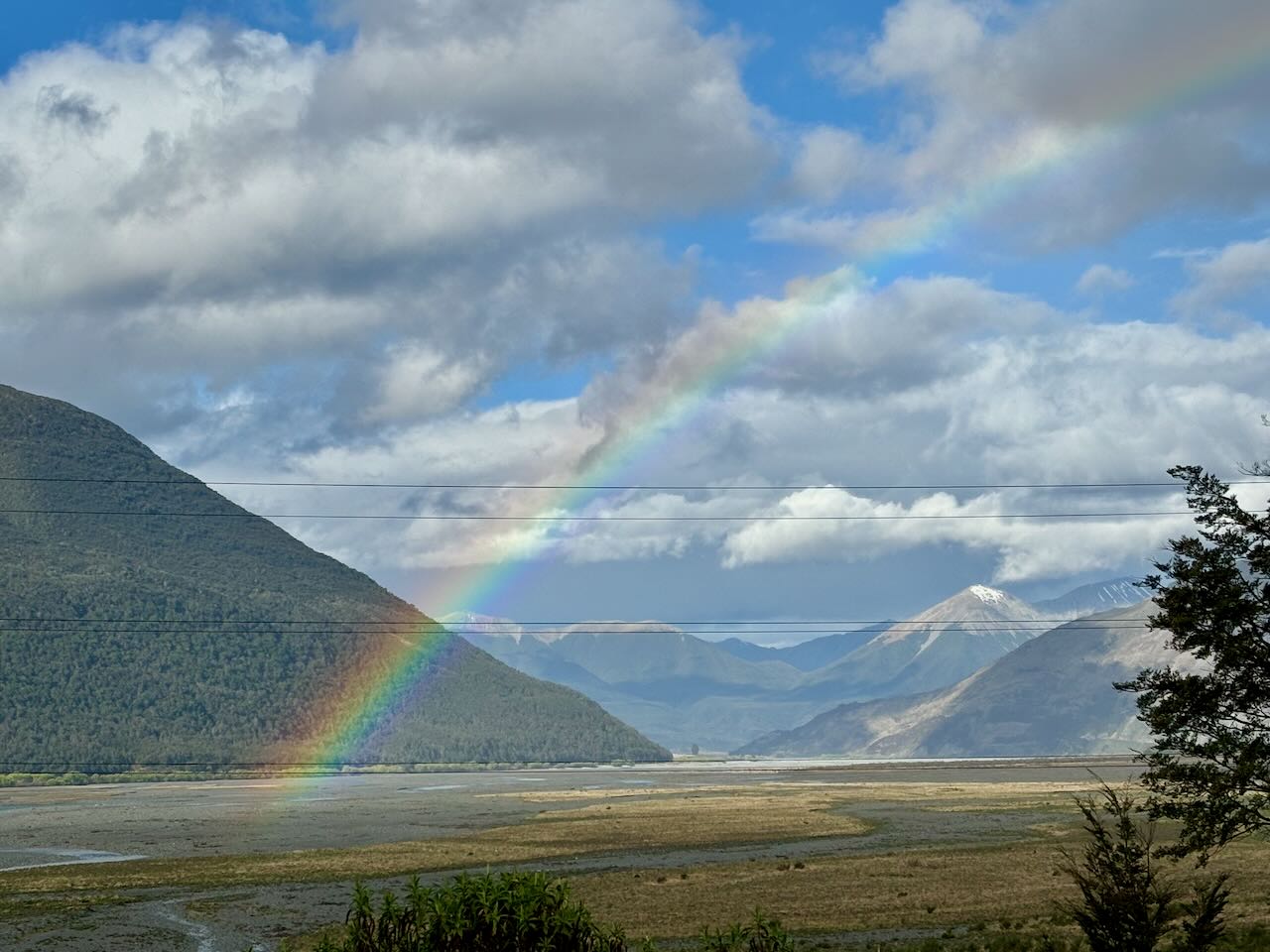 Rainbow in Southern Alps
Rainbow in Southern Alps
Sunday, October 6, 2024
While I saw beautiful scenery most days I was in New Zealand, today's beautiful scenery was almost nonstop. We drove along the New Zealand Alps from Arthur's Pass to Lake Tekapo. In addition to the beautiful scenery, we went past a rocky area that appeared in one of the Lord of the Rings movies. We drove through a town called Springfield, which has a statue of a doughnut with a bite taken out of it. The people who produce The Simpsons have donated one of these statues to every place in the world called Springfield. And we stopped at one place where a river looked very blue. The water in the river came from a glacier, and the high mineral content of the pulverized rock in the water caused sunlight to scatter, creating the very blue colour.
In addition, I saw the New Zealand bird species I most wanted to see. I am very interested in bird behavior, and I am especially interested in birds who have developed unique adaptations to their environment. The Wrybill is a small shorebird found only in New Zealand. It nests on braided riverbeds, which are covered with gravel and small stones. The back of the Wrybill blends in with the stones. What makes the Wrybill unique is that it is the only bird in the world whose bill curves sideways. Some species have bills that curve downward, and some upward, but the Wrybill's bill curves to the right. It is an adaptation to allow it to probe under the gravel and stones in its habitat for insect larvae and other arthropods. The bird I saw was a male who had a dark line above the eyes, which the females lack. Wrybills are not skittish, and I was able to get pretty close without him flying away.
While we were on the road, I saw a New Zealand Falcon. Steve did not see it, but I saw the orange-brown chest, pointed wings, and hunched posture which Steve described as M-shaped. Across the road from Lake Tekapo, I saw a small flock of Redpolls, an introduced species sometimes seen in the winter in Washington, DC. The males were in breeding plumage, and they had a lot of red on the breast, like a House Finch. A Pied Oystercatcher was on a lawn not far from our vehicle.
At the lake was an Australasian Crested Grebe, diving near the shoreline. John Oliver promoted this species to be New Zealand's "Bird of the Century" (whatever that means). A few Black-billed Gulls were in the water. At one time, they were the most endangered gull species in the world, but more of their breeding areas have been discovered. Some Grey Teal were on the shoreline, and Steve was surprised to see so many Australasian Shovelers so far inland. Pied Oystercatchers were loudly displaying at each other.
Stilts are shorebirds whose name comes from their very long legs. We saw a hybrid between a Pied Stilt and a Black Stilt. The Black Stilt is the rarest shorebird in the world. Only 50 to 100 pairs are left in the world, all in the Mackenzie Valley of New Zealand where we were at the time. The hybrid had much more black on the breast than a Pied Stilt and much more white than a Black Stilt. Black Stilts have declined because of predation and habitat loss. It is not good for the species when the small number of Black Stilts hybridize. We looked for Black Stilts in a pond a couple of times in the afternoon but could not find any.
Near where I saw the Wrybill were Black-fronted Terns. They must have had a nest nearby, because one of the terns flew at us a few times. They have grey plumage that blends in with the stones on the braided riverbed. The "front" in bird names usually refers to the area directly over the bill. Also in the area were many Banded Dotterels, who also blended in with the stones.
I found out after dinner that there had been Aurora Australis activity (the Southern Hemisphere equivalent of the Northern Lights) the previous night at Lake Tekapo, but none was likely for the next few nights. Still, I probably had more than enough beauty for one day.
 Doh-nut Statue in Springfield
Doh-nut Statue in Springfield
 Deep Blue Glacial Water
Deep Blue Glacial Water
 Braided Riverbed
Braided Riverbed
 Wrybill
Wrybill
 Wrybill Probing Under a Rock
Wrybill Probing Under a Rock
 Pied Stilt
Pied Stilt
 Pied Stilt - Black Stilt Hybrid
Pied Stilt - Black Stilt Hybrid
 Black-fronted Tern
Black-fronted Tern
Monday, October 7, 2024
This morning, we returned to a pond we had checked twice yesterday, and we saw a pair of Black Stilts. I spotted them while Steve was driving. I saw two black birds at the back of the pond. The birds foraged over most of the pond and at times came close to us. The weather was overcast, but I was able to get a few decent photos and some video. Because of the low cloud cover, we did not travel toward Mount Cook, which is the highest mountain in New Zealand at 12,218 feet.
Black Stilts are important in the culture of the Mackenzie Valley. In the nearby town of Twizel, images of them were on signs, in murals, and in statues. In many places where we looked for a bird species that had become rare and confined to a certain area, I saw numerous representations of the species. I don't sense that Americans take pride in any types of wildlife to the same extent that people in New Zealand do. The fact that New Zealanders call themselves Kiwis, a nocturnal bird the majority of New Zealanders have never seen in the wild, says a lot about how the country values its natural heritage.
Across the street from Lake Tekapo, we looked for Redpolls and found a couple. Also in that area, a South Island Pied Oystercatcher strolled in the road. At Wairepo Arm, I saw two Australasian Crested Grebes engaging in courtship behavior. They stretched their necks and put them together, but they did not do anything as elaborate as some of the grebe displays in nature shows.
In the afternoon, we went to the Clay Cliffs. This area resembles the Badlands habitat in the US. Some of the clay towers on the cliffs rise up like a cathedral. We looked for New Zealand Falcons, but we didn't find any. We likewise did not find any other Black Stilts. I photographed a plant called Lamb's Ear, whose leaves are soft like a lamb's ear.
We spent the night in Omarama (accent on the second syllable), which is Merino Sheep country. One saw statues of Merinos or the real thing almost everywhere you looked. The market for Merino wool was good, but the market for wool from other types of sheep had crashed. Merino wool is a magnet for dirt, so the unshorn sheep look like chunky, dirty grey poodles. The wool contains a lot of lanolin, so the people who handle it tend to have very soft hands. Some of the Merinos had white bottoms because of a practice called crotching. The fur around their anus was trimmed so that poo would not get tangled in it, which would attract flies and affect their health.
We had lunch at a place called The Wrinkly Rams, which said it offered Sheep Sheering, a Cafe, a Winebar, and Gifts and Art. The sheep shearing had been discontinued because of COVID, and I could not find art. Before dinner, we stopped to see Steve's friends Anabel and Richard, who operate a big sheep station in Omarama.
 South Island Pied Oystercatcher
South Island Pied Oystercatcher
 Black Stilt
Black Stilt
 Black Stilts Statue
Black Stilts Statue
 Black Stilts Mural
Black Stilts Mural
 Australasian Crested Grebes
Australasian Crested Grebes
 Clay Cliffs
Clay Cliffs
 Lamb's Ear
Lamb's Ear
 Merino Sheep
Merino Sheep
 Crotched Merino Sheep
Crotched Merino Sheep
 Merino Ram Statue
Merino Ram Statue
Tuesday, October 8, 2024
We drove from Omarama to Oamaru, which is on the coast. We encountered fog, and it had not completely cleared by the time we arrived at the Katiki Historic Reserve, which has a path along a wild bluff next to the Pacific. I saw skylarks displaying. I also saw goldfinches in the trees and some Dunnocks on the ground. The area had a large colony of Red-billed Gulls, some of whom were copulating. There was a smaller colony of Southern Black-backed Gulls, some of whom were carrying mud for nests. On the ground next to the farthest point on the path, a New Zealand Fur Seal was lounging.
No Yellow-eyed Penguins were there. We later went to Bushy Beach to look for them, but we were there too early for them to return from their day of fishing, and some people disobeyed a sign that said you are not supposed to be on the beach before 9 a.m. of after 3 p.m. The penguins are very skittish, and people easily disturb them. One small child on the prohibited section of the beach was throwing rocks at one of the resting fur seals.
We saw a bridge with an Otago Shag colony in Oamaru. There appeared to be about 600 Otago Shags on the bridge. About ten Spotted Shags were perched in the front of the colony, along with one Little Pied Shag. Some Southern Black-backed Gulls were also there. The Otago Shags have two colour morphs. One is black on the back and white underneath, with a white slash on their wings. The other morph is an all-dark bronzy colour. Their nests look like bowls made out of mud.
Oamaru (pronounced o-A-ma-ru) is a strange place, even by my standards. Imagine someone who designs haunted houses being turned loose to design the downtown area of a city. Oamaru is the steampunk capital of New Zealand. Steampunk is a subgenre of science fiction that focuses on steam-powered technology from the Victorian period. Oamaru has a steampunk museum. We ate lunch at a place next to a steampunk playground, which has a lot of old Victorian features such as a penny-farthing bicycle with a giant front wheel. Parked near where we ate was a hearse with many macabre features. The downtown area has the Steampunk Headquarters, outside of which are a blimp, a locomotive, gargoyles, and a lot of other things which look either old or rusted. There is a metal figure of a man with a grappling hook who appears to be fishing from the roof.
We had dinner at the Star and Garter, the oldest restaurant in the city. It has been serving food in this location (near Steampunk Headquarters), since the early 1900s. One of the walls has wedding pictures of people who married in the 1950s — probably people who had wedding receptions or wedding meals at the restaurant. Some of the buildings in Oamaru were built during the Victorian period, which had no codes so that structures could better withstand earthquakes, so parts of the city could be very vulnerable if a large earthquake occurs. Similarly, Greymouth, where I had been a couple of days ago, has a floodwall around the city that is higher than the city, so if the wall is breached during a major flood, the floodwaters will be trapped inside the city with no way to get out. Living in many places in New Zealand is not for the faint of heart.
After dinner, we went to see Little Penguins returning from their day at sea. They are also called Little Blue Penguins or Fairy Penguins. They are the smallest penguin species in the world. An organization in Oamaru has constructed boxlike burrows for them, similar to the boxes at the Hutton's Shearwater colony I visited. Road signs warn people that penguins are in the area. Bleachers have been set up so that people can watch as the penguins come out of the ocean, waddle up a steep hill, and return to their burrows. Most of them go through little tunnels which count the penguins and weigh them as they pass through. Before going to their burrow, many stop to preen their feathers in preparation for another long day at sea the next day.
I had a really good seat for observing them. When they turned a certain way under the lights, I could see the blue sheen on their feathers. I could also see their stubby little tails. When they walked toward the weighing tunnel, they leaned forward like Groucho Marx used to do in some of his movies. On the way out, we walked past some of the penguins who were standing near the boardwalk which led to the parking area. It was worth sitting in the cold for two hours to see the penguins. Taking photos of them was prohibited, but on the way in, I took a photo of one of the burrows. We were told that when we reached our vehicle after leaving the viewing area, we should check underneath to make sure no penguins were there.
The wind along the ocean was bitterly cold this morning. Yet I still saw two children wearing shorts. At lunch, it was a bit warmer, and I saw children in bathing suits swimming in the water outside our lunch spot. I watched them while I was wearing multiple layers of clothing and not feeling warm.
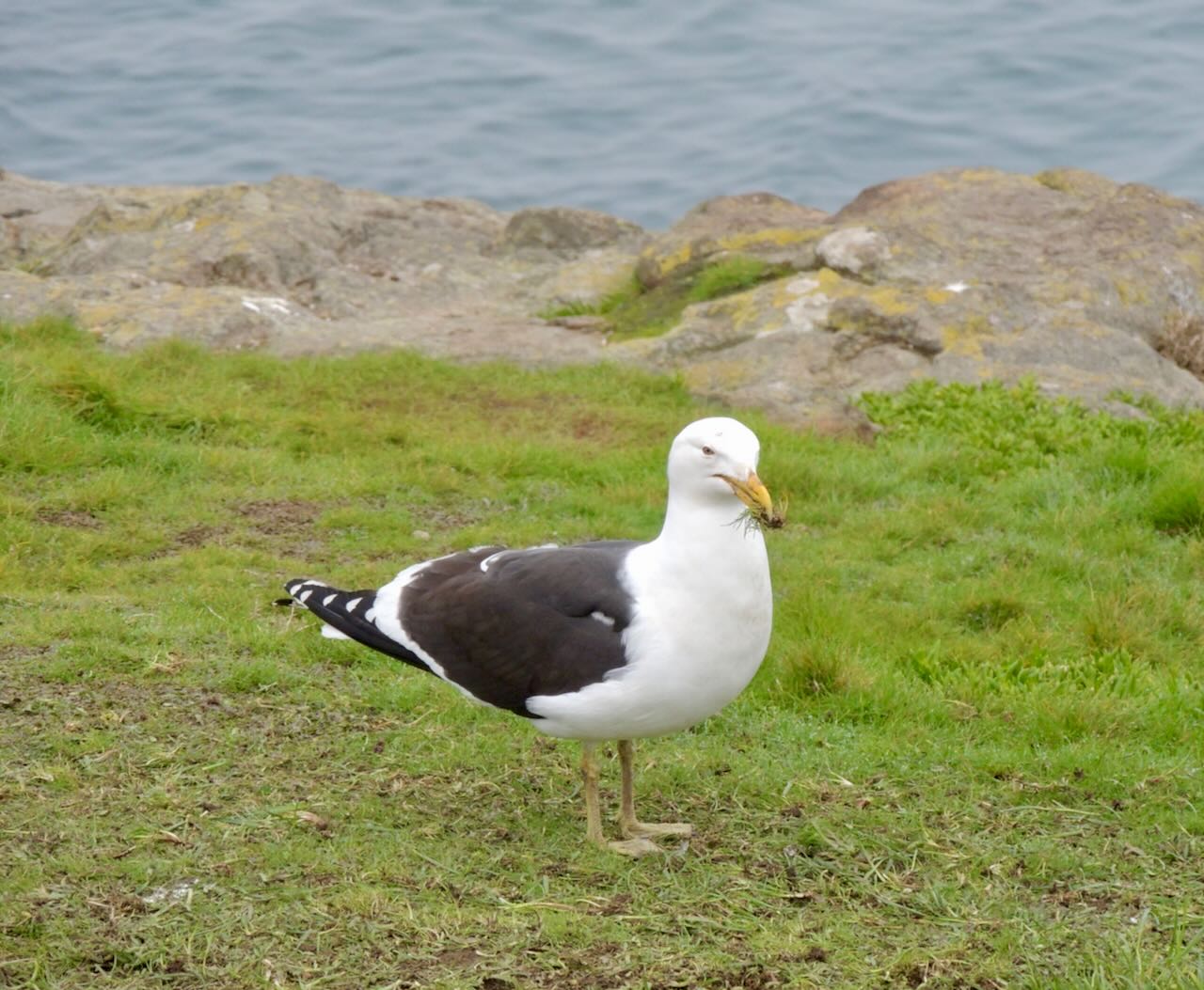 Southern Black-backed Gull with Nesting Material
Southern Black-backed Gull with Nesting Material
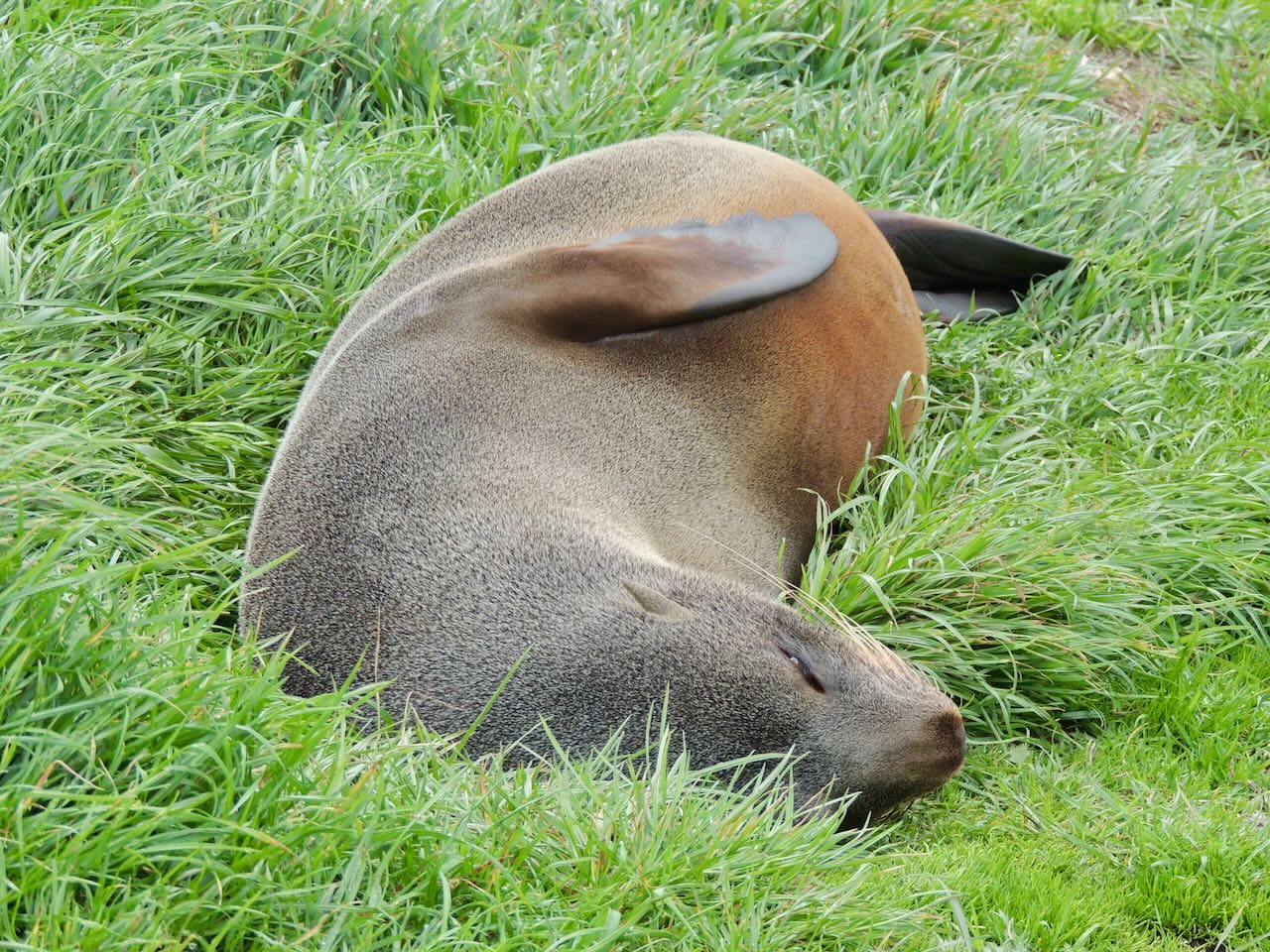 New Zealand Fur Seal
New Zealand Fur Seal
 Otago Shag Colony
Otago Shag Colony
 Steampunk Playground
Steampunk Playground
 Hearse in Oamaru
Hearse in Oamaru
 Steampunk Sign
Steampunk Sign
 Steampunk Headquarters
Steampunk Headquarters
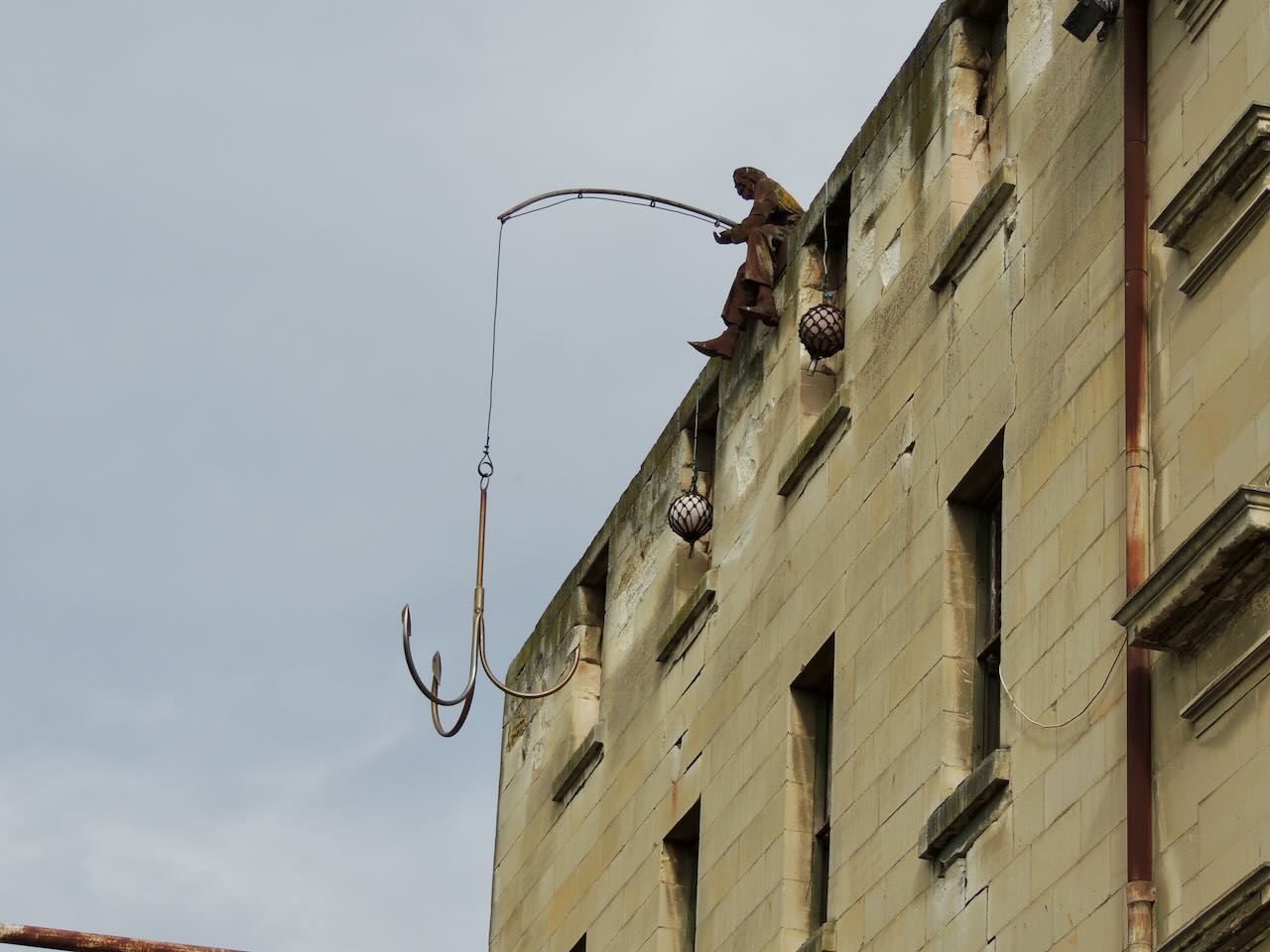 Fishing with Grappling Hook at Steampunk Headquarters
Fishing with Grappling Hook at Steampunk Headquarters
 Penguin Sign
Penguin Sign
 Little Penguin Tunnel and Weighing Device
Little Penguin Tunnel and Weighing Device
 Little Penguin Burrow Box
Little Penguin Burrow Box
 Girls Swimming in Oamaru
Girls Swimming in Oamaru
Wednesday, October 9, 2024
We left the Steampunk town of Oamaru and headed north toward Christchurch. The drive was fairly long. Steve saw some Greylag Geese while we were riding, but I did not see them. Our only stop was at a Black-billed Gull colony on the way. More than a thousand of these rare gulls were there. The gulls are not popular among some people in the area, and a man was prosecuted a number of years ago for driving an all-terrain vehicle through the colony, destroying nests, eggs, and birds. Some birders recorded the act on video, and the man was given a hefty fine. Another man asked the local government if it was okay to poison birds, and they were just about to grant it until people learned that he wanted to poison the gull colony.
We then drove straight to an area near where Steve lives on the Banks Peninsula. At Lake Forsyth, we saw a lot of waterfowl, including Australasian Crested Grebes, Australasian Shovelers, and New Zealand Scaup. Some of the grebes were displaying. A few pairs of Black Swans had cygnets.
We had lunch in Akaroa, which has a strong French flavour. Many French settled in the area in the 1800s, and the French influence is present in many parts of the town. Akaroa is in the caldera of a volcano which last erupted six million years ago. A caldera is a depression formed when a volcano collapses after erupting. I spent much of the afternoon in the caldera, because we went on a boat trip with Black Cat Nature Cruises, riding through the caldera into the Pacific Ocean.
One area had a large rock in the water with a White-fronted Terns colony on it. Another highlight was seeing about 20 Hector's Dolphins. I had seen this species on a boat trip last week, but I had much better looks at them today. They are the world's smallest dolphins and rarest saltwater dolphins — some species of freshwater dolphins are rarer. They swam relatively close to our boat.
The walls formed by volcanic activity have created beautifully patterned rock formations. Some of the rock walls have caves. The rocky ledges in one area had a female New Zealand Fur Seal suckling a pup. Another had rocky ledges with nesting Spotted Shags. We saw a lot of Black-backed and Red-billed Gulls, and we came across a group of Fluttering Shearwaters. And I spotted a group of about six Canada Geese in the water. I have seen and heard them in various parts of New Zealand, but I did not expect to see them in the ocean.
I spent the night in a grain silo. Our room reservations in Akaroa got messed up, so Steve is spending the night in his house, and I am staying in a facility made of silos, which is close to where Steve lives. My cathedral ceiling is round and made of metal. The silos were never used for their original purpose. The place was very comfortable, and using new grain silos as hotel units was yet another of the quirky and innovative ideas I encountered in New Zealand.
 Black-billed Gull Colony
Black-billed Gull Colony
 Black Swans and Cygnets
Black Swans and Cygnets
 Hector's Dolphin
Hector's Dolphin
 New Zealand Fur Seals
New Zealand Fur Seals
 Spotted Shag Colony
Spotted Shag Colony
 Silo Hotel
Silo Hotel
 Inside a Silo
Inside a Silo
Thursday, October 10, 2024
The winds were blowing hard last night, but I felt safe in my silo. We started out by driving to the Hinewai Reserve, which is inside the Akaroa volcano. At our first stop, we saw a lot of small birds, all of whom were non-native. Among them were Yellowhammers, who are attractive yellow buntings with a rufous rump. We also saw Redpolls, European Greenfinches, and House Sparrows foraging near them. A henge (stone circle) had been constructed near where we saw these birds.
Some Tomtits flew close to us. I heard a Brown Creeper and had a quick look at it. The Maori name for this species is Pipipi, which is imitative of the bird's song and how I recognized the vocalization. Brown Creepers are skulkers and move quickly, so seeing one can be a challenge.
Steve pointed out some of the trees and plants in the area. The Totara tree has very hard wood. Quite a few Ribbonwood trees were near the paths. They are one of the few deciduous trees, along with the Fuchsias, found in New Zealand. They can grow to be up to 17 meters tall (55 feet). Steve showed me some stinging nettle plants which are native to New Zealand — Urtica ferox. You must be very careful not to touch it, because the sting of the nettles really hurts, and even worse, contains an anaesthetic which can hospitalize or even kill a person if the sting is severe enough.
We then headed to the home of the artist Tricia Hewlett and her partner Paul Newport, who is a botanist. On the way, we encountered a man named Hugh Wilson at a junction in the road. Hugh is a spry man of 79 whose enthusiasm is infectious. He has done remarkable work in Hinewai. The forest in this area is regenerating with the help of gorse. When farm animals are present, gorse is a terrible invasive weed. But where no or few animals are present, it can serve as an effective plant which fixes nitrogen in the soil and helps trees to grow. Once the trees grow tall enough, the gorse is starved for light and dies, leaving only the native trees. On YouTube, you can see a video about Hugh's efforts in Hinewai.
When we arrived at Tricia's and Paul's house, Tricia served us scones and tea. I bought a print Tricia had created with a Kea. We heard a Shining Bronze Cuckoo, but did not see it. Paul raises Red-crowned Parakeets, who are almost totally absent from the two main islands. They like to forage on the ground, and they have been eliminated by rats, stoats, and other invasive mammals. Paul had a special permit to raise them. He had four in an aviary, and he let me go inside the aviary to see them. Taking photographs was not easy, because one parakeet was on my left hand eating some kiwi fruit I was holding. I had to take the photos with only my right hand. The parakeets preferred the seeds to the flesh of the fruit.
Paul came with us for a walk in the nearby forest and found a bird I really wanted to see. The Rifleman is a small green bird who weighs only 5 to 6 grams and whose tail appears to be missing. Riflemen are the smallest bird species in New Zealand. By comparison, a Carolina Chickadee weighs only 10 grams. I had good looks at a female flitting in the trees. They are named because their plumage is similar to the green military uniforms worn by New Zealand riflemen. When we got back to the house, I bought a print Tricia had done of a rifleman. Tricia also gave me numerous copies of the newsletter Pipipi, which is about the Hiewai reserve.
Paul showed us a lot of plants. The Kakabeak has red flowers that look like the beak of a parrot called a Kaka who has disappeared from much of New Zealand. In the Maori language, kaka is a general term for all species of parrots. The Seven Fingers plant was used by the Maoris as a remedy for foot fungus. The Maoris used many plants for medicinal purposes. Paul showed us a White Kawakawa; I had already seen many of the Kawakawa trees with green leaves. He also showed us a Weta motel, containing one of the insects.
We had lunch in the town of Little River, where Steve lives. The weather had warmed up a little, so we ate outside at a place which is a cafe with an art museum attached. We were surrounded by many outdoor sculptures. Before lunch, Steve had shown me the area around the local high school. On one of the athletic courts had a hoop with a net but no backboard. It is for the sport of netball, which is very popular in both New Zealand and Asia, but hardly known in the US. New Zealand television broadcasts netball games, and I had trouble understanding the rules during the bit that I watched.
After lunch, we began our drive to Christchurch. We arrived near 4, and we checked out the Heathcote/Avon Estuary. Feeding there were 100-150 Bar-tailed Godwits, as well as a bunch of Pied Oystercatchers. We were looking directly into the sun, which made photography difficult. A woman who monitors bird activity in the area came up and talked to us and gave me her card.
Steve dropped me off at my B&B in Christchurch. Christchurch is New Zealand's second largest city, but it has only about 380,000 people, which is about a third as large as the county where I live. Still, it felt a bit strange being in a place with so many people after the experiences during my first three weeks in New Zealand.
 Yellowhammer
Yellowhammer
 Redpolls
Redpolls
 The Hinewai Henge
The Hinewai Henge
 Totara Tree
Totara Tree
 Ribbonwood Tree
Ribbonwood Tree
 New Zealand Stinging Nettle
New Zealand Stinging Nettle
 Red-crowned Parakeet Aviary
Red-crowned Parakeet Aviary
 Red-crowned Parakeet Eating Kiwi Fruit
Red-crowned Parakeet Eating Kiwi Fruit
 Kakabeak
Kakabeak
 Seven Fingers Plant
Seven Fingers Plant
 White Kawakawa
White Kawakawa
 Weta Motel
Weta Motel
 Outdoor Kaka Sculpture at Little River Museum
Outdoor Kaka Sculpture at Little River Museum
 Netball Basket
Netball Basket
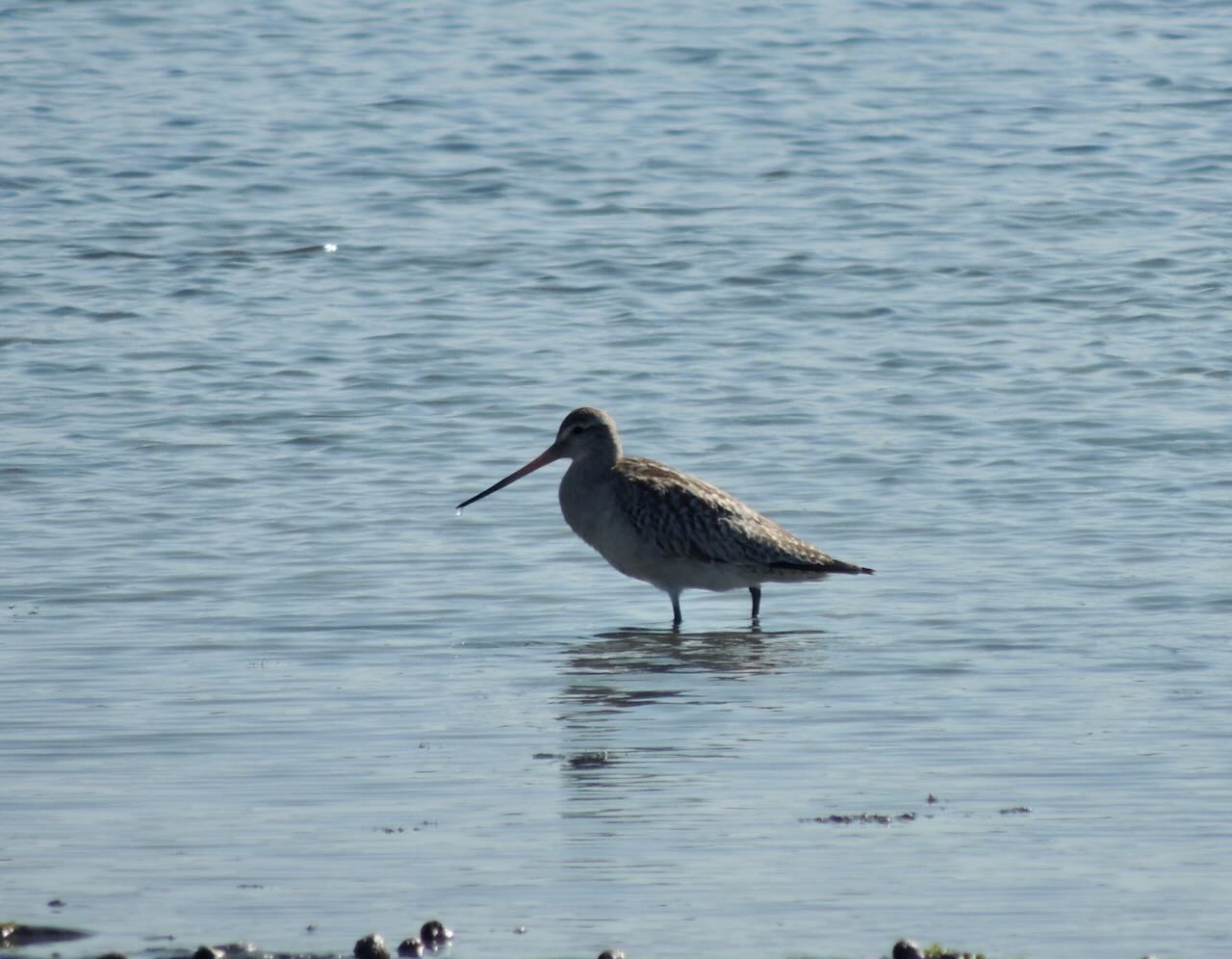 Bar-tailed Godwit
Bar-tailed Godwit
Friday, October 11, 2024
I spent most of today in wetlands, which is one of my favourite habitats. I enjoy looking at waterbirds, and I saw a lot of them. We stopped first at the Woodend Bakery. Woodend is also the name of the headquarters of the Nature Forward organization, which is a couple of miles from where I live in Maryland. In the bakery parking lot was a Red-billed Gull standing next to a much less common Black-billed Gull. Seeing them next to each other was a good way to compare the two species. The Red-billed Gull appeared to be a little bigger.
We started birding at the Ashley River Mouth Holiday Park. I saw a Mute Swan, a new bird for the trip. This is an introduced species who is a close relative to the Black Swan. A New Zealand Scaup sat on a log over its reflection.
We then went to Ashley-Rakahuri Estuary and spent a lot of time there. In one spot, we saw both a Great Egret and a Little Egret. Both were new birds for the trip. Egrets are uncommon in New Zealand, especially the Little Egret, who resembles the Snowy Egrets in the US. The Great Egret is the same species as in the US. Both egret species had the nuptial plumes which almost caused their demise from hunters killing the birds to sell the plumes for use in women's hats. We later saw a second Little Egret. In the same general area was a Royal Spoonbill in breeding plumage. The Spanish name for the spoonbill is espatula. A Little Pied Shag was drying its wings. Cormorants do not have waterproof feathers, which makes them less buoyant when diving for food. When they resurface, they perch and spread their wings to dry.
In one area, we ran into a man fishing for Whitebait — small fish who sell for high prices and are very popular either coated and fried or in fritters. A White-faced Heron stood nearby, hoping to scoop up some of the fish. In the areas where we walked, water was on one side and trees were on the other. We saw a number of Yellowhammers and European Greenfinches in the trees.
We then went to a braided beach where I put on Wellington boots and looked for Wrybills. While we looked at an adult, I spotted a fuzzy Wrybill chick among the rocks. The chick did not have a fully bent bill — the bill bends as they get older. The adults did not seem especially protective of the chick.
After lunch, we went to the Travis Wetlands. Some Masked Lapwings were in the impoundments. They have a bare yellow wattle hanging down each side of their face which makes them appear to be wearing a mask, like a professional wrestler. This species can be very noisy and aggressive — in Australia, I saw one chase an eagle. Many Mallards had young. Among the other waterfowl were Australasian Shovelers, Grey Teal, Canada Geese, and Paradise Shelducks. Many Swamp Harriers soared overhead. Pukeko were all over the place. We saw a few pairs of Black Swans with cygnets. At one place where we saw swans, a lot of Longfin Eel were near the shore, hoping that visitors would throw them food. The eels also eat young waterfowl, including cygnets. It was a warm, sunny afternoon — one of the first times on the trip I felt warm. I really enjoyed being among such a profusion of wildlife.
The visit to the Travis Wetlands in Christchurch was the final adventure of the second leg of my trip. Being with Steve Attwood was a wonderful experience. It can be risky to hire a private guide you have never met, especially for a two-week tour. Steve works in public relations and was formerly a news reporter. He knows a great deal about New Zealand birds and the country of New Zealand, and I learned ever so much about both. As with most Kiwis I met, he was relaxed and easy going, which made for a very pleasant trip. He has a tattoo on his arm that says Humani nil alienum, which means "Nothing concerning mankind is indifferent to me". We talked about where we might go if I return next November to see some of the places in New Zealand I did not see on this trip.
 Red-billed and Black-billed Gulls
Red-billed and Black-billed Gulls
 Mute Swan
Mute Swan
New Zealand Scaup
 Great Egret
Great Egret
 Little Egret
Little Egret
 Royal Spoonbill
Royal Spoonbill
 Little Pied Shag
Little Pied Shag
 White-faced Heron
White-faced Heron
 Whitebait
Whitebait
 Wrybill Chick
Wrybill Chick
 Masked Lapwing
Masked Lapwing
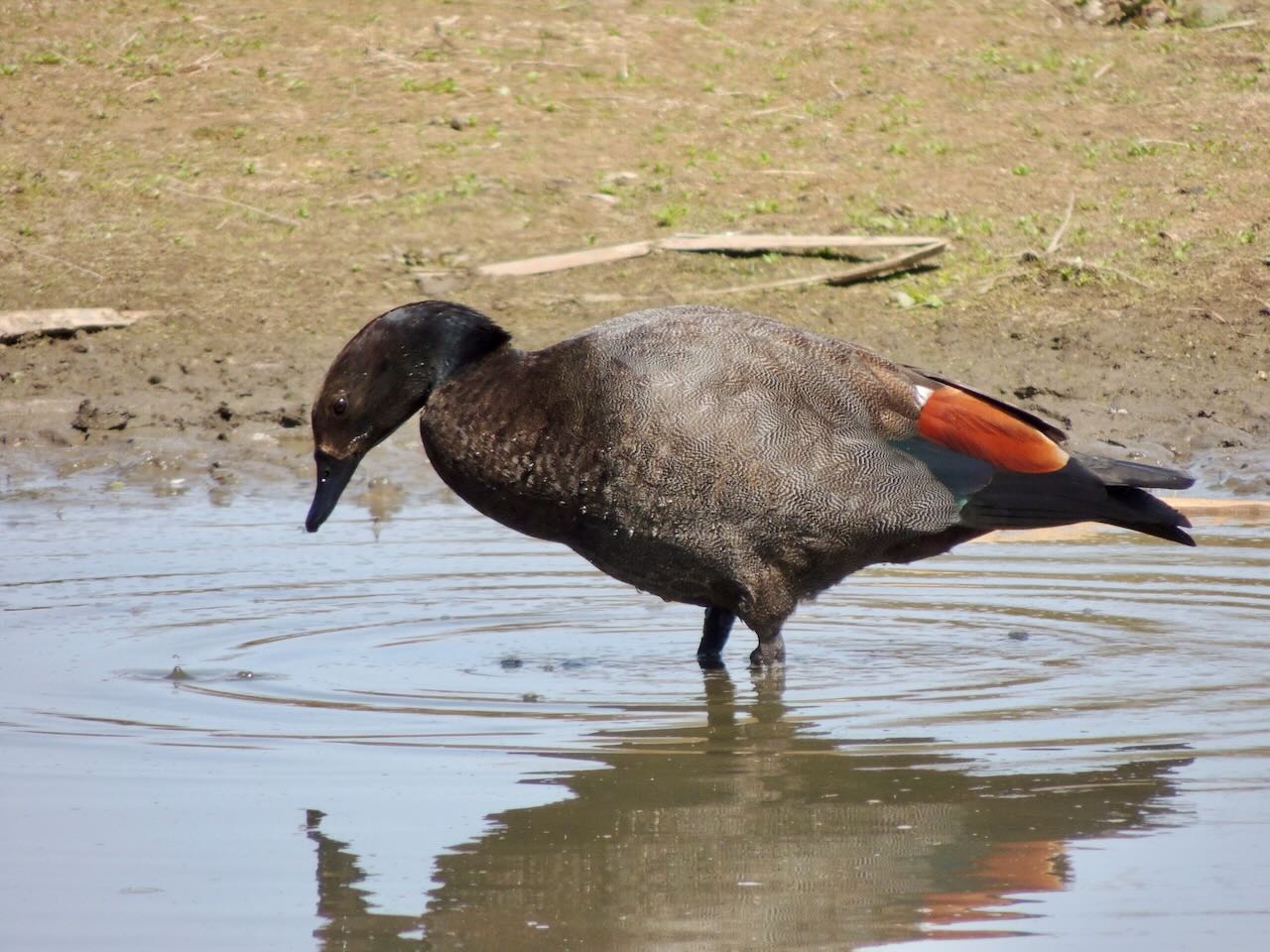 Male Paradise Shelduck
Male Paradise Shelduck
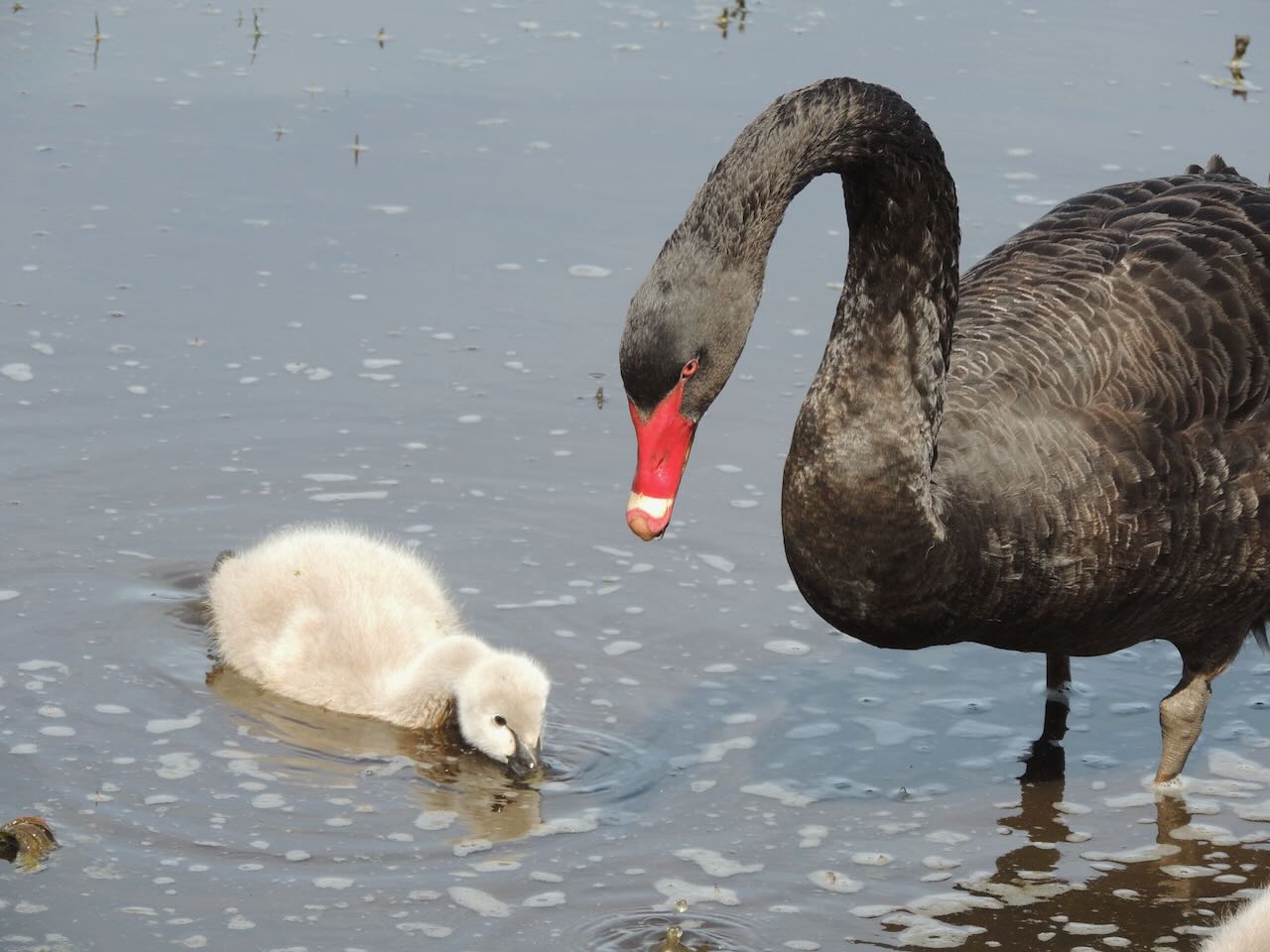 Black Swan and Cygnet
Black Swan and CygnetSaturday, October 12, 2024
Today, I did not go more than a mile from where I was staying, yet I had a very rich day. I did not go to look for birds, but I can't help myself.
After breakfast, I went to the Christchurch Botanical Gardens. On the way, I watched a European Greenfinch singing in a tree. Outside the gardens were banners with a Wrybill on them. The gardens had a lot of ducks, native and introduced, who had ducklings. Many Mallards had young. These birds don't flee from visitors to the gardens. One female Mallard had two ducklings, and one walked between my feet while I was trying to take photos. I also saw New Zealand Scaup, Canada Geese, and Australian Coots. Some Pied Cormorants were in a tree.
A number of Paradise Shelducks had ducklings. I was able to get very close to some without the parents seeming to mind. The young ones look like little badgers. Paradise Shelducks were one of the most common species on my trip. I saw pairs of them in fields in agricultural areas as well as in other habitats. They are large and a bit unusual with respect to their plumage. Usually, males are showier, and females have more subdued plumage so they will not be as conspicuous at the nest. But the female shelduck has a white head and a cinnamon body, while the male is mostly dark brown. I rarely saw a single shelduck. I usually saw a pair. The members of the pair are very loyal to each other. Yesterday when we were looking for Wrybills, we saw a newly dead female shelduck on the beach. A male who was nearby seemed to be wailing over his loss. One male I saw today could fly, but had an injured foot which made him walk with a limp — a literal lame duck. I also saw a female perched up in a tree.
The gardens had quite a few California Quail, an introduced species. In two different places, I saw one squawking from the branch of a tree. Their vocalization is a loud chi-CA-go.
I saw Yellowhammers, European Goldfinches, and Song Thrushes on the ground. A lot of Bellbirds were singing. The only species of butterfly I saw was the Monarch, the same species as in the US. They are also seen in Australia, where they are called Wanderers.
A Eurasian Blackbird with a leucistic cheek was hopping on one of the lawns. Leucism is caused in birds when their feathers do not have the proper level of the pigment melanin, which is what makes feathers black. Such colour abnormalities are usually of interest only to birders, Sometimes, the condition can exist in all the bird's feathers. Leucism is not the same as albinism.
I went for lunch in a building next to an outdoor market. One of the vendors sold works that had cutout shapes with New Zealand postage stamps behind them. I bought two of his works — one with a cutout albatross over albatross stamps, and one with a cutout Weka over Weka stamps. I have a collection of more than 3.000 postage stamps with birds, so I couldn't resist. From another vendor I bought a print with a New Zealand Fantail.
I went back to the Botanical Gardens for a tour of the New Zealand flora section of the gardens. Rebecca and Steve taught me a lot about plants and trees. So when the leader of the trip showed us a Rangiora tree and asked what the leaves had been used for, I said "letters and toilet paper." And when she said that wood from the Kahikatea tree had no odour, she asked me if I knew what people used it for, I said, "containers for butter." When other types of wood were used, the butter absorbed the odour and was not any good by the time it arrived in England.
After I left the gardens, I had a Thai massage at a studio close to where I bought the artwork. After the massage, I had dinner at a Thai restaurant. I was both relaxed and full.
 European Greenfinch
European Greenfinch
 Wrybill Banner
Wrybill Banner
 Mallard with Ducklings
Mallard with Ducklings
 Female Paradise Shelduck and Duckling
Female Paradise Shelduck and Duckling
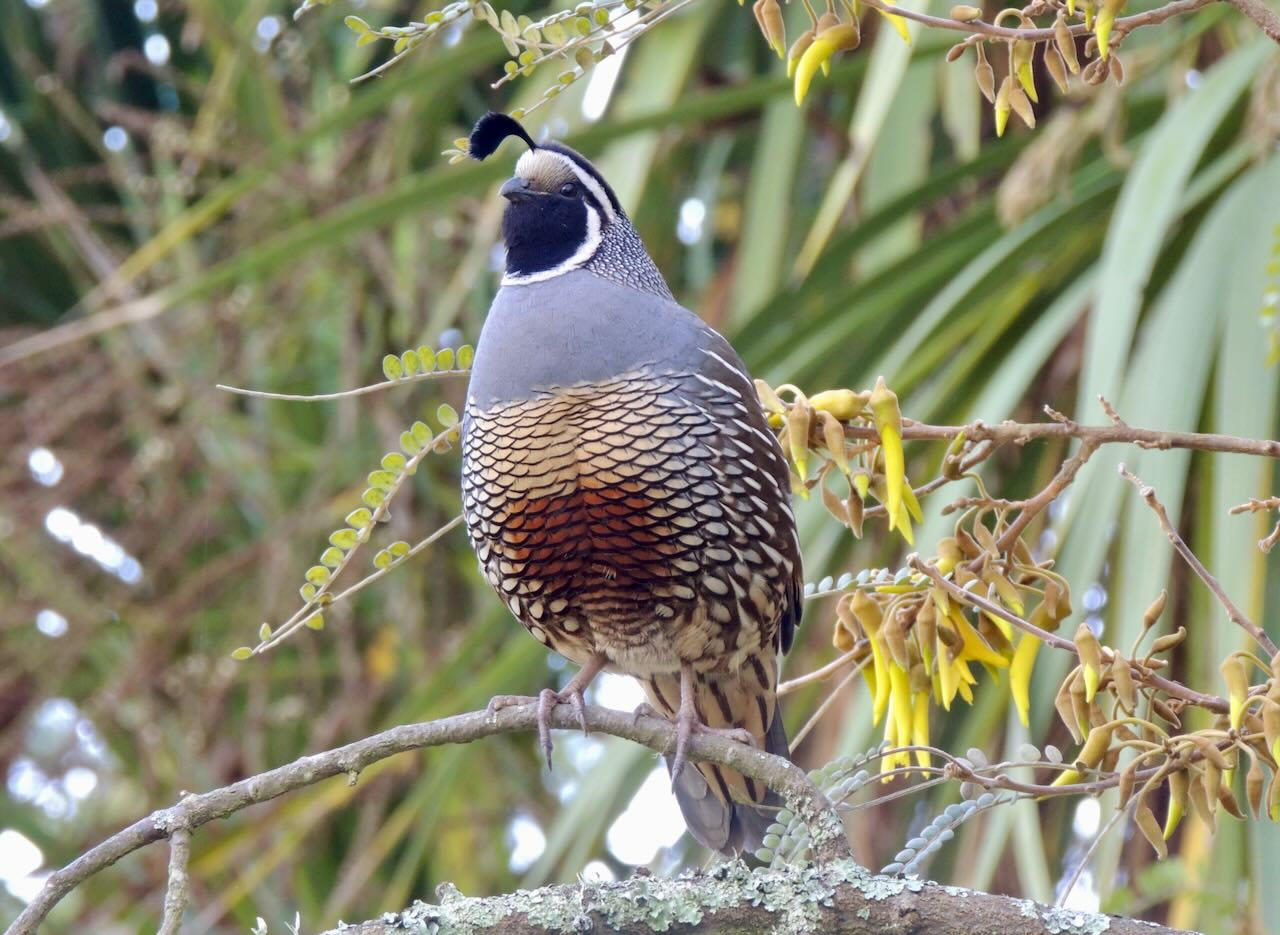 Male California Quail
Male California Quail
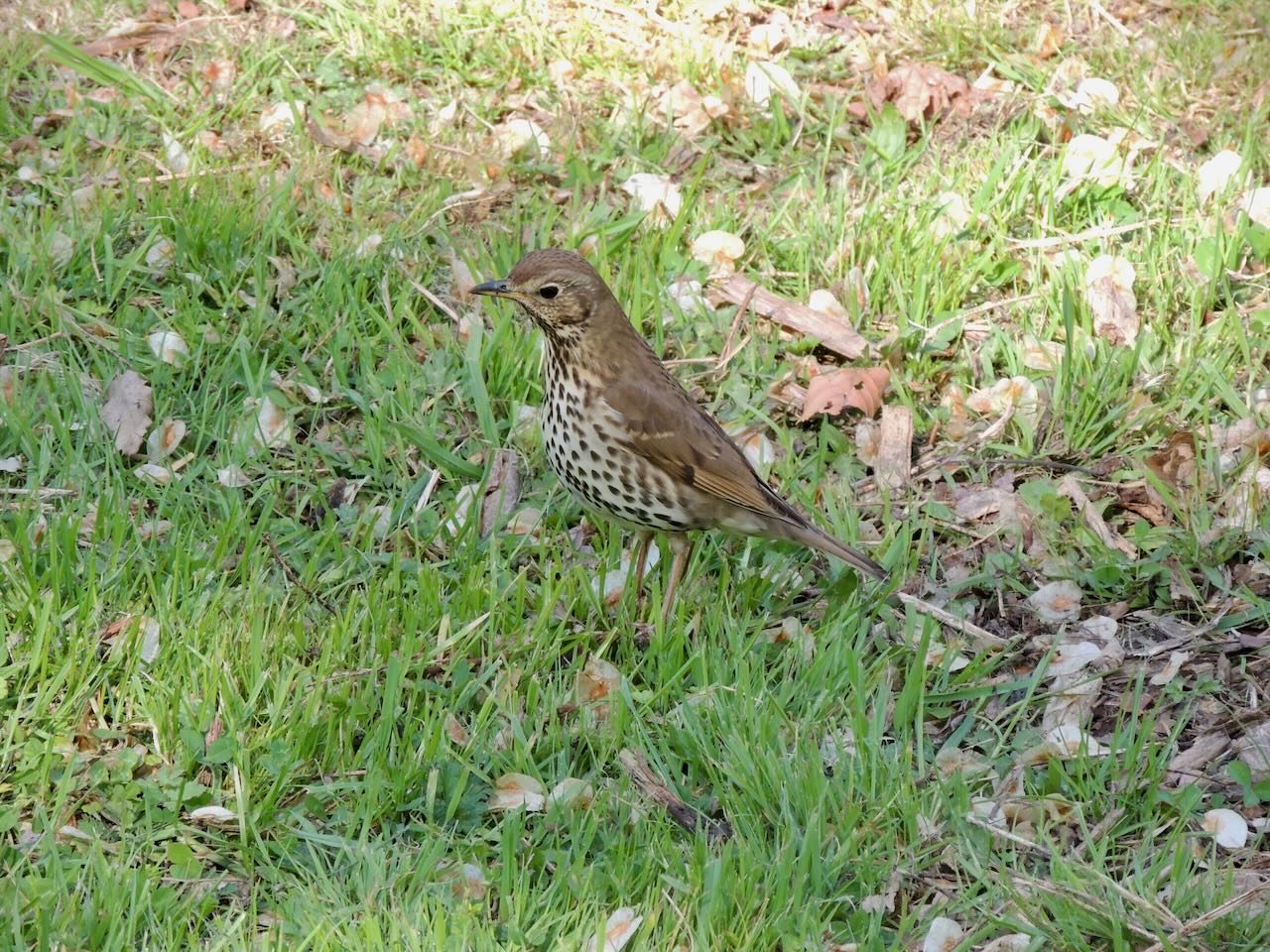 Song Thrush
Song Thrush
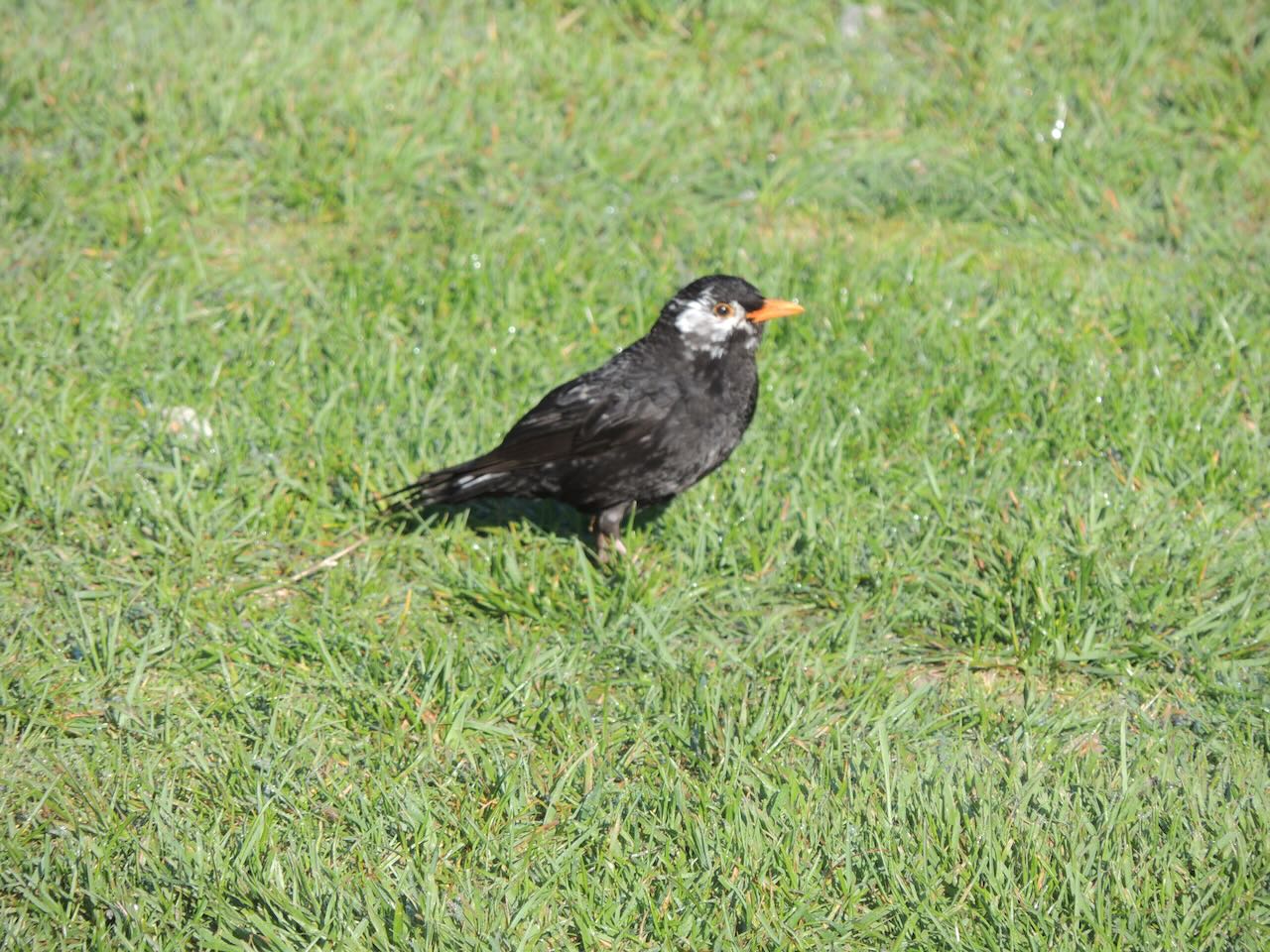 Leucistic Eurasian Blackbird
Leucistic Eurasian Blackbird
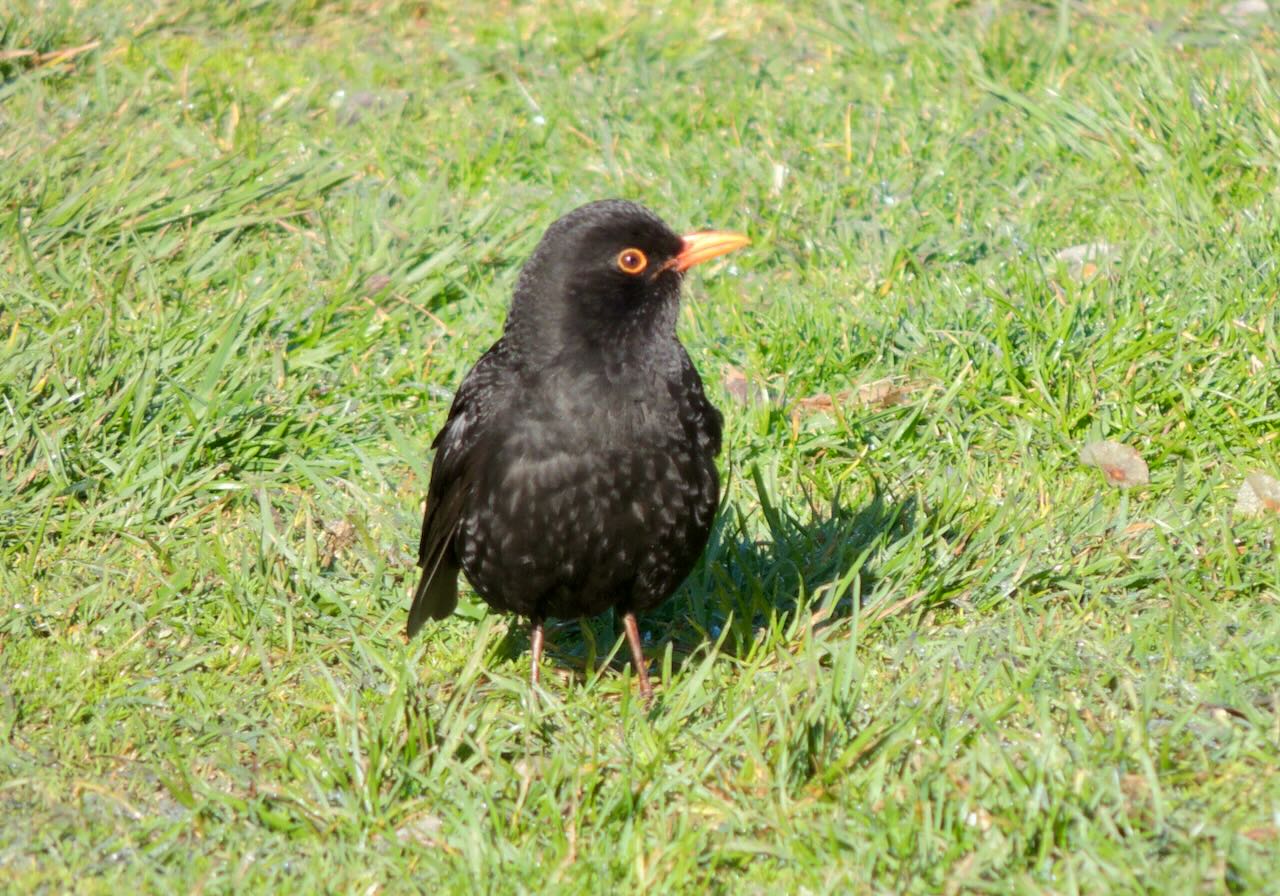 Male Eurasian Blackbird
Male Eurasian Blackbird
 Female Eurasian Blackbird
Female Eurasian Blackbird
Sunday, October 13, 2024
This morning was overcast and drizzly in Christchurch, so I took a walk to see a few things I had read about. Christchurch has a floral clock — a large round flowerbed with a clock mechanism under it. The hands of the clock circle the flowers. Because not much was in full bloom and the weather wasn't good, the clock was a bit of a disappointment. The clock is near Victoria Square, which has a statue of Queen Vic as well as one of James Cook. I was trying to learn about New Zealand society, and I sensed that although Christchurch is a very English city, there also is a deep undercurrent against colonialism. The statue of Cook, who was the first Englishman to explore New Zealand, had a red X spray painted across his front.
I next went to a church nicknamed the Cardboard Cathedral because it is constructed using 86 cardboard tubes. I was there on a Sunday morning when a service was in progress, so I could not wander around inside. Instead, I wandered back toward my hotel, taking photos of street art. The city was full of paintings on walls, utility boxes, and anything else with a large surface. There was also a lot of graffiti.
Because of the weather, I went to a couple of museums, The Centre of Contemporary Art, or CoCA, was being renovated, but a small part of their collection was on display in a building not far from where I was staying. The items included a gold-plated motorcycle, a fragment of the Canyon Diablo meteorite which crashed into Arizona, and various items of memorabilia from polar explorers. There was also a stuffed moa on a balcony.
I then went to the Christchurch Art Gallery, which I greatly enjoyed. A guided tour began at 11, and only I and a couple originally from Ireland were on it. The docent was very enthusiastic, telling us about some of the important large works of art in the collection, including a piece called Chapman's Homer out front which featured a piano with a large bull standing on it.
The docent took us to an exhibition of the work of the New Zealand artist Marilynn Webb, who was in her early 80s when she died a few years ago. She produced a lot of art in various media for a large portion of her life. She was very supportive of Maori rights and culture, and she was also outspoken against nuclear weapons. New Zealand is one of the leaders in the anti-nuclear movement.
The Maoris were in New Zealand about 500 years before the British and other European colonial powers came over, and the Maori influence is much greater than the Native American influence in the US or the Aboriginal influence in Australia. Some of the Maori resentment was reflected in the art. A lot of the protest is based on differing interpretations of the meaning of the language in the 1840 Treaty of Waitangi, which dealt with the use of New Zealand land by both the Maoris and the British. The docent, while commenting on one work, talked about the Maori reverence for the land, saying that the Maori word whenua means both land and placenta.
The tour was supposed to last about 45 minutes, but it ran almost twice as long. I grabbed a quick lunch and hurried over to the Botanical Gardens for a 1:30 walk about some of the outstanding trees in the gardens. When I got there, I was the only person on the tour, so I had the docent from the Christchurch Horticultural Society all to myself. The tour was supposed to last about an hour, but once again, it ran almost twice as long. The people who act as docents are volunteers, and they seem to deeply love what they do.
The docent showed me a line of Wollemi Pines planted near the visitors' centre, This is an ancient species that was rediscovered in Australia in 1994. The location of the original tree has been kept secret, but Wollemi Pines are now available all over the place for relatively little money and even sold in some places as Christmas trees. She showed me how the male and female cones on the tree are different. She pointed out the many sequoia trees from California in the gardens. The cones are small and extremely hard. The gardens have a Monterrey Cyprus which has what looks like a bunch of branch-like trunks that come out of the base.
We stopped by the Peace Bell, which was a present to the gardens from Japan. The bell is rung by striking it with a rod, but you can make it ring by hitting it with your hand. A tree grown from a cutting from a tree that survived the Nagasaki bomb is in the area in front to the bell. Inscribed in the concrete of the area surrounding the bell is the word for peace in many different languages. By the time we finished, I knew a lot more about trees, both in New Zealand and elsewhere.
I ended the day by grabbing a quick dinner and then going for another massage. My hamstrings have been tight, and massages on two consecutive days have loosened them up.
At the museum, I saw part of a video featuring a woman from Samoa. One thing she said is that no matter how far a duck flies, it will always return to the water. I guess that meant I needed to return to Maryland after my trip to New Zealand, but I was not sure I wanted to.
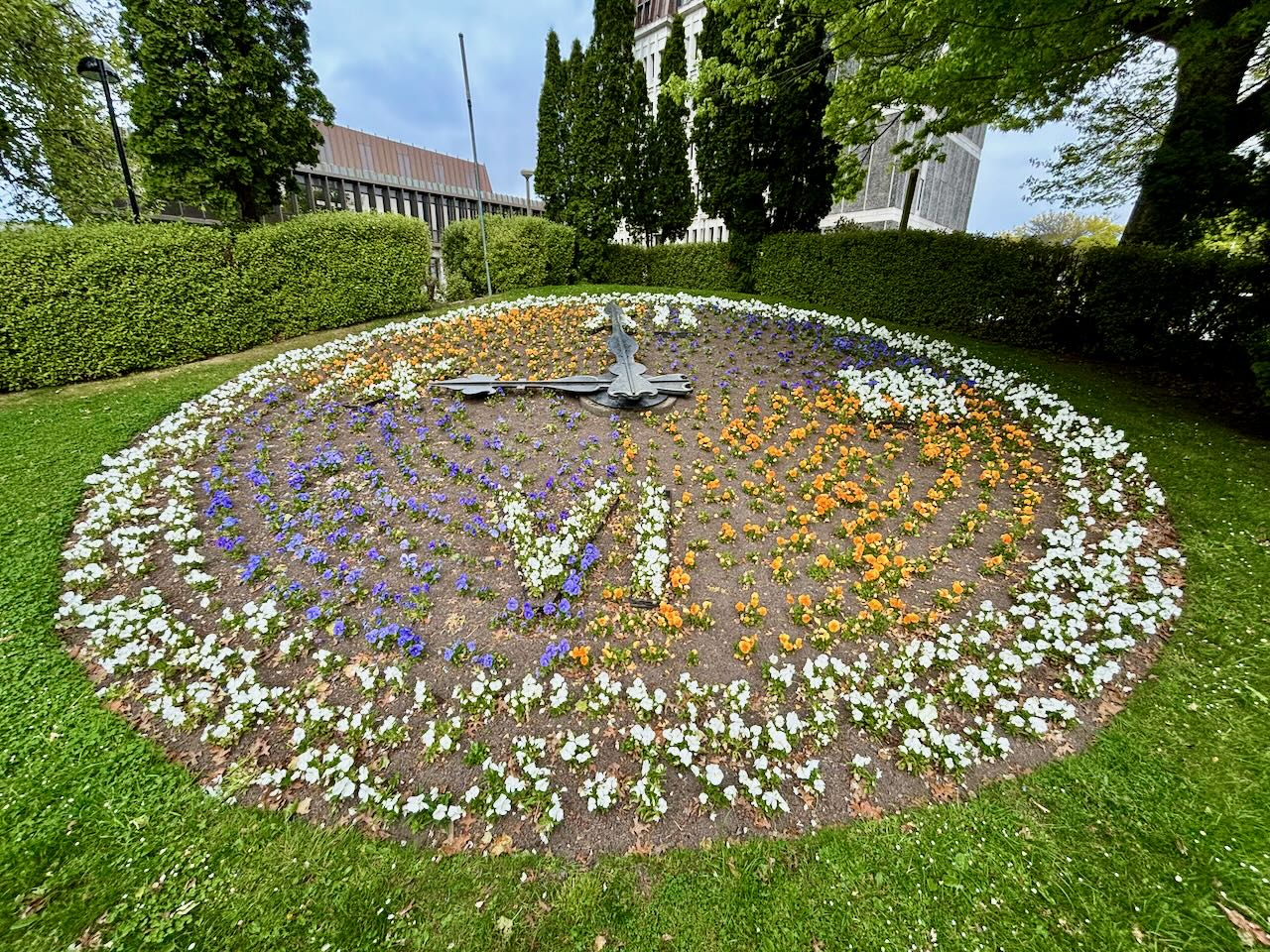 Floral Clock
Floral Clock
 Statue of James Cook
Statue of James Cook
 Cardboard Cathedral
Cardboard Cathedral
 Diablo Canyon Meteorite
Diablo Canyon Meteorite
 Stuffed Moa
Stuffed Moa
 Chapman's Homer at Christchurch Art Gallery
Chapman's Homer at Christchurch Art Gallery
 Hand in Burning Landscape, by Marilynn Webb
Hand in Burning Landscape, by Marilynn Webb
 Maori Protest Art
Maori Protest Art
 Female Cones of Wollemi Pine
Female Cones of Wollemi Pine
 Male Cones of Wollemi Pine
Male Cones of Wollemi Pine
 Sequoia Cones
Sequoia Cones
 Monterrey Cyprus
Monterrey Cyprus
 Peace Bell
Peace Bell
Monday, October 14, 2024
This morning, I went to a rehab facility, not because I had issues with substance abuse, but because I was interested in the care of injured birds.
After breakfast, I set out for the Bellbird Bakery to buy some things for lunch. I like to patronize vendors with bird names. I bought a croissant, a mini-baguette, and a palmier cookie — the same things I usually buy for breakfast when I'm in Paris. I then walked to Cathedral Square to catch a shuttle bus to the International Antarctic Centre, which is near the airport. It provides various attractions for visitors. There was a video about the Antarctic, much of it shot on South Georgia Island. The video showed many of the sights and places I saw when I was there in 2016. The film was in 4D. In addition to having to wear 3D glasses, there were scenes where the seats rocked as if you are on a boat, and a few instances where you were sprayed with water or simulated seal slobber. Another attraction at the centre was going into a room which simulated what it is like to be in Antarctic weather, with the wind chill going below 0 degrees F. The room was cold, but I did not find it to be a whole lot colder than I had felt in many places in New Zealand. One other attraction was a ride in the type of vehicle used in the Antarctic. It was like being in a tank and going through an obstacle course, climbing 45-degree hills, tilting sideways 17 degrees, going through water, going over crevasses, etc.But the main reason for my visit was to get a tour at the Centre's facility for rehabilitating injured Little Penguins. The Centre offered a special behind-the-scenes tour, which involved going into the labs. The Centre was caring for 10 females and 5 males. The sex imbalance created some odd situations, with some penguins swapping partners, and one pair of females forming a couple. (There are no gay birds — homosexuality is a human construct.)
The scientific name for the Little Penguin means "good little diver", as does the Maori name. The penguins at the centre lived a lot longer than the members of their species in the wild. A wild Little Penguin usually lives about 6 or 7 years, but some of the birds at the Centre had lived to be 25. They were fed a lot of fish, and the penguin feeding was one of the public attractions at the centre. These penguins would never be returned to the wild, and they would have no offspring. When one of them laid an egg, the keepers replaced it with a dummy egg. The eggs are fairly large. Little Penguin populations were not doing well in many places. As with a lot of New Zealand bird species, they are the victims of stoats, rats, and other introduced predatory mammals.
I went from the Antarctic Centre to a reserve called Willowbrook, which is basically a zoo. One section had New Zealand birds, some of whom I had not seen on my trip. Among the birds in the park were kiwis. I went into a dark room and watched one for about ten minutes in reasonable light from a distance a little longer than my arm. The bird was pecking and scratching in the dirt. It had big red feet and a long thin bill that looked like a red drinking straw.
Willowbrook also had Kea, Kaka, Moreporks (small owls), and a lot of other species. The Moreporks are named for their vocalization. I was not able to see a Blue Duck when I was on the tour with Steve, because we could not go to a possible place to see them due to a rainstorm. Willowbrook had a Blue Duck, but she was nowhere to be found when I was there. This is a special bird to New Zealand, and an image of one appears on the back of a $10 bill. In fact, all five denominations of New Zealand currency have a bird on the back.
Just before I left, I encountered a member of the staff who was with students feeding ground meat to Longfin Eels. Some of the eels slithered partway out of the water, showing their teeth. These are large, aggressive creatures known to eat swimming ducklings and other young waterfowl.
I continued to be impressed by the thoughtfulness of people in New Zealand. This morning, I was looking for the shuttle that goes to the Antarctic Centre. It left from Cathedral Square (which is near the real cathedral, not the cardboard one). Many vendors set up stalls in the square, and one of them suggested that I ask for help from a woman who appeared to be wearing a train conductor hat. When I asked the woman, she pointed to where the bus was scheduled to leave in about thirty minutes. When the bus arrived, I boarded it. Before it left, the woman with the hat poked her head in the door, looked at me, and told the driver, "I just wanted to make sure he got on."
I ate dinner tonight at a place called the Little High Eatery, which was a food court. Many of the tables were taken, but one table for four had only one young woman looking at her mobile phone in a seat in the corner. I asked if she minded if I sat in the front seat across the table, and she said, "No worries, go for it." She stayed busy with her phone while I ate a sandwich called Big Jim's Ex Girlfriend. It was one of those sandwiches which has a lot of slippery sauces so that when you take a bite, things slide out the bottom. I was about three quarters through it and making a mess when the young woman said, "Here," and pushed a napkin dispenser toward me. She must have been watching me out of the corner of her eye.
Such incidents were not unusual. I encountered them every day, which was a major reason I enjoyed my visit to New Zealand so much.
 Bellbird Bakery
Bellbird Bakery
 Little Penguins
Little Penguins
 Little Penguin Egg
Little Penguin Egg
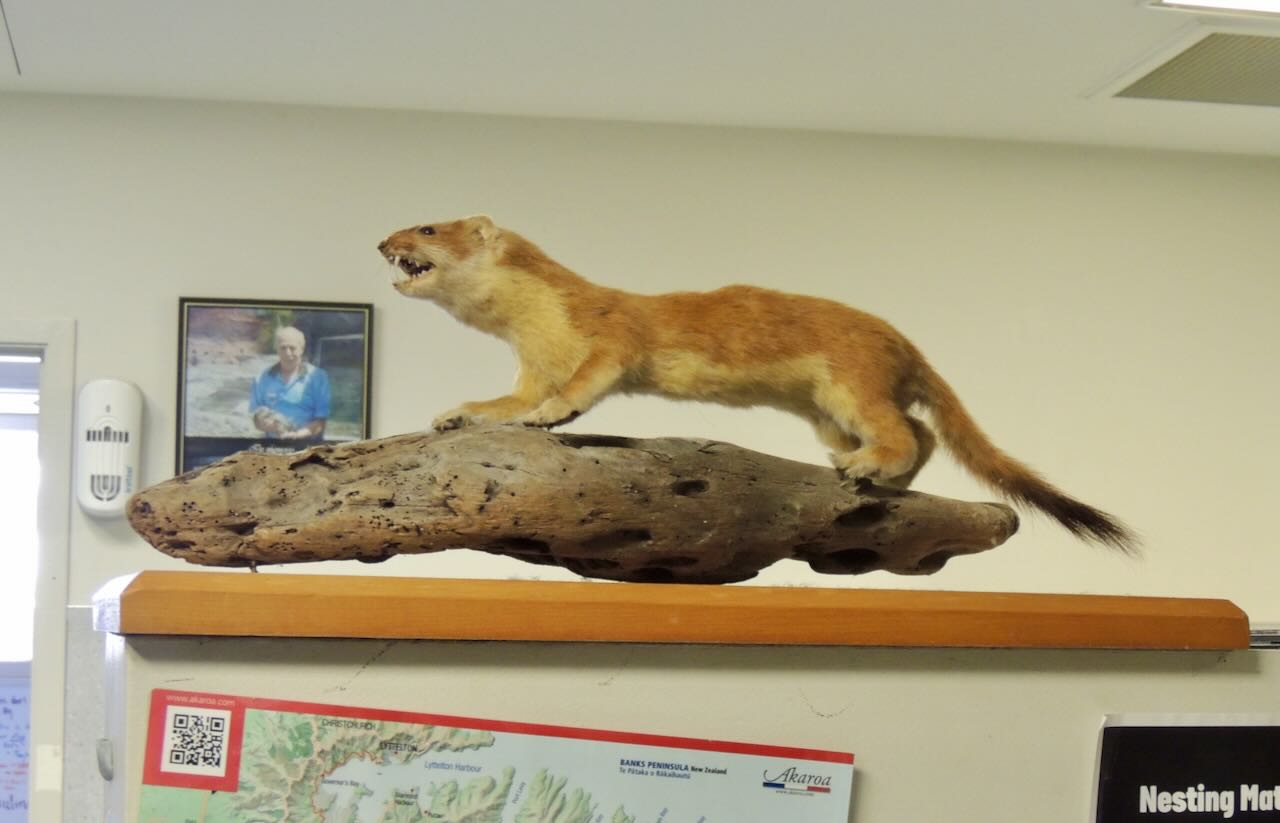 Stuffed Stoat
Stuffed Stoat
 Morepork
Morepork
 Longfin Eels
Longfin Eels
Tuesday, October 15, 2024
This morning, I was scheduled to meet someone named Centuri to show me street art in downtown Christchurch. On my way to meet him, I noticed a trailer with a sign that asked, "Do you have an idea or project you would like to test in a real life space?" I asked one of the people standing out front what it was all about, and he said the person who could best explain it was Centuri, who was by the side of the trailer. The group's work is based on an idea, originating in New York, that everyone on the street has a story to tell.
I then began my two-hour walk with Centuri. Downtown Christchurch is loaded with street art, which is one of the only good things that resulted from the two earthquakes in 2010 and 2011. These quakes resulted in many deaths and widespread destruction of buildings in the area. The city lost 80 percent of its concrete buildings of three stories or more.
But this provided a major opportunity for the city to reinvent itself. For a long time, major portions of the city were fenced off to repair the damage. The increase in fence space led to an increase in artwork or graffiti on the fences. There was still a lot of repair work being done more than a decade after the quakes, which meant more fence space. An artist instituted a project to put flowers at the top of the many construction cones around the city.
One work featured Tui and a Rifleman. It was done by a Wellington artist known as Chimp with aerosol paint, which seemed remarkable considering the amount of detail. Another showed native birds on the left and introduced rabbits on the right, symbolizing the battle between the two groups, which the rabbits were winning. The work was done by an artist known as Flox. A mural with elephants had gone through many iterations, and the current one reflected work during the current month. The Kiwi Bank had an elaborate bird mural on one of its exterior walls, and the Novotel Hotel had a large external mural showing Antarctic penguins. Some of the work contained political messages. Christchurch has a chunk of the Berlin Wall, painted on both sides.
One of my favourite pieces was called Rise from the Rubble, by the artist Brandon Warrell. It featured a Silvereye perched upon a damaged brick wall, pecking at a Kowhai tree. The artist was juxtaposing the beauty of nature against the destruction caused by the quakes.
I could write much more about what I saw on the tour, including the larger-than-life spray paint cans that people were invited to paint and write on. (I added something with a paint pen Centuri lent to me.) Or the Dance-o-Mat, which was a small outdoor space where people could dance to music — it could be activated with a mobile phone through a contraption in a beat-up old washing machine.
When you walk around a city, you typically see many things without knowing the background of what you are looking at. My friend Paul Dickson co-wrote a book about all the things that happened in various places in Washington, DC, before the current buildings were put there. After the tour with Centuri, a lot of places in Christchurch seemed much more familiar to me.
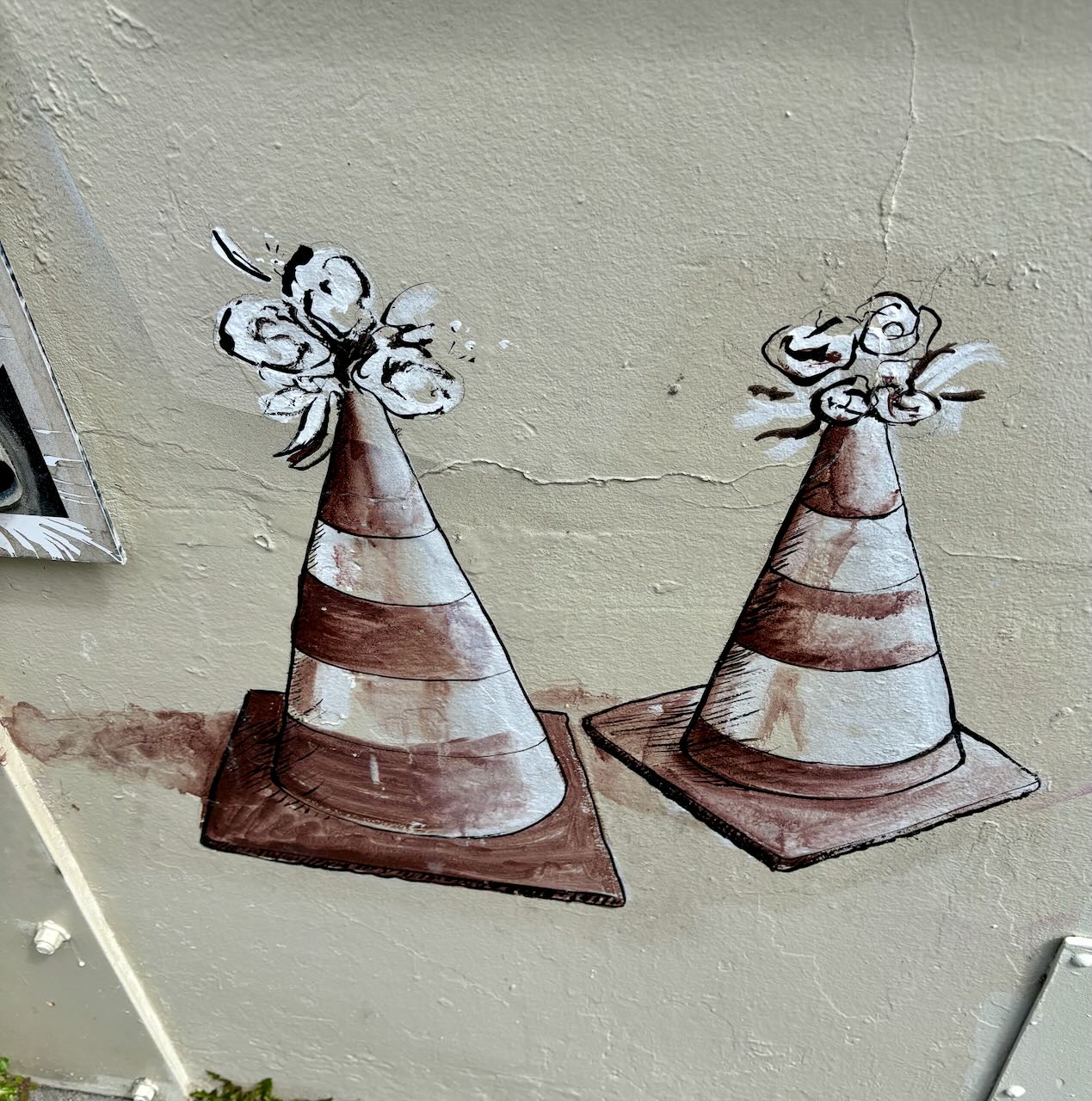 Construction Cones with Flowers
Construction Cones with Flowers
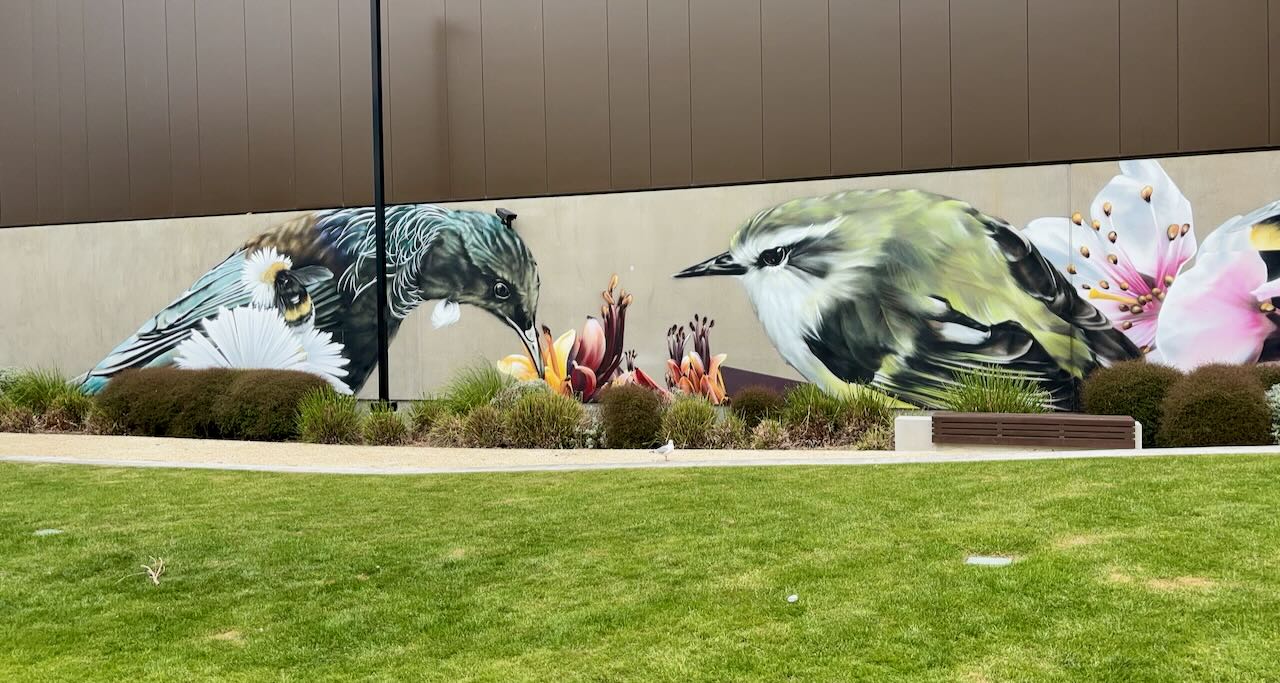 Tui and Rifleman Mural
Tui and Rifleman Mural
 Birds vs Rabbits Mural
Birds vs Rabbits Mural
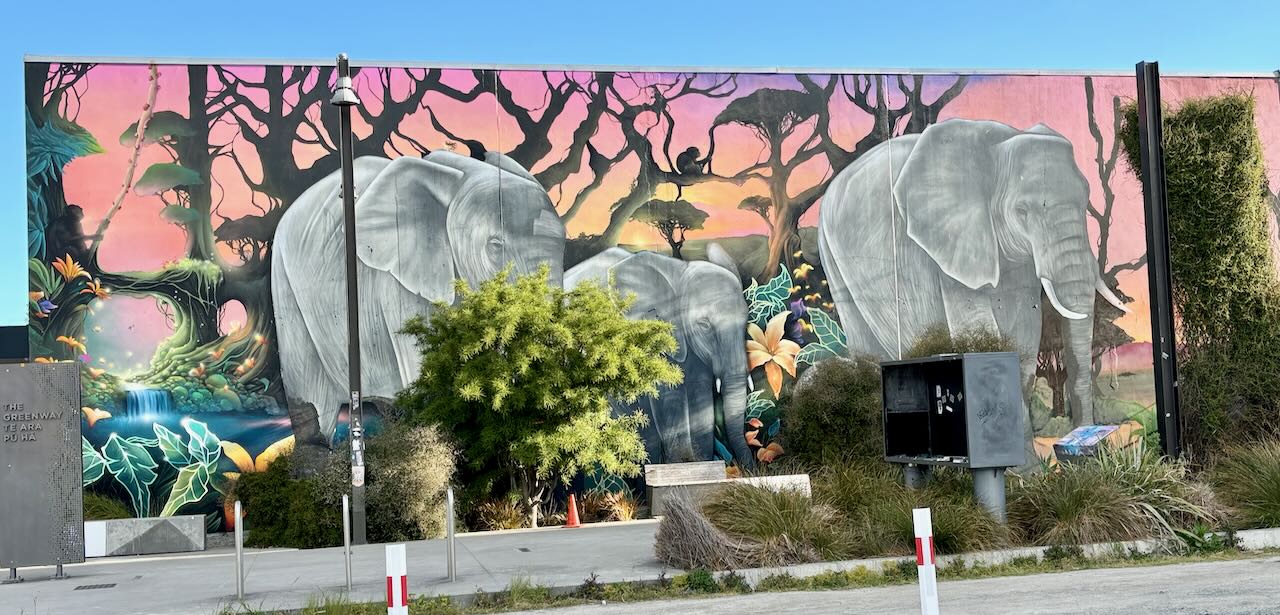 Elephant Mural
Elephant Mural
 Kiwi Bank Mural
Kiwi Bank Mural
 Rise from the Rubble Mural
Rise from the Rubble Mural
Wednesday, October 16, 2024
This morning, I had to say goodbye to two old friends. One of my running shoes began to fall apart. Because the two shoes had been inseparable for as long as I had worn them, I parted with both. They went into a waste receptacle near the Christchurch Convention Centre.
My first stop was the Christchurch library. It is a large open building with a lot of natural light. On the ground floor was a chess board and a jigsaw puzzle (which someone was working on). I went up to the New Zealand collection to look for books by some of the authors Steve had told me about. One was the writer Owen Marshall, and I found a few poems in his book The White Clock which I liked. One was called "The Finch".
Cleanliness proves fatal as a green bird
smacks the broad glass, falls into crocuses.
Softly warm, bowed, passed into death, it
had seen nothing between itself and a
future of everlasting sky and flowers
so felt no fear, no pain, before eclipse.
An instant in full flight, then to strike and
fall into nothingness. Not a bad way to go.I then went to the SALT district, which is one of the places I had explored with Centuri. Its name comes from the first letters of three of the main streets in the area: Saint Asaph, Lichfield, and Tuam. A wellness centre called the O Studio is there, and I went to use one of their flotation tanks. The purpose of these tanks is to go into an environment where you can turn off your senses. Some places have tanks that are like coffins you float in, but the ones at the O Studio were much less claustrophobic.
The tank was a large tub about a foot deep, and the water was loaded with Epsom salts. You take off all your clothes, get in the tub, lie on your back, and the Epsom salts hold you up. You must trust that the Epsom salts will do this. I could feel the upward push on my legs as I was lying there. You could turn on a blue or red light, and you had the option of having stars on the ceiling, similar to the glowworm areas I visited. Gentle music played for the first ten minutes, then there was thirty minutes of silence, then five more minutes of music at the end. I turned out the lights and did not have the stars, so I saw the same pitch blackness whether my eyes were open or shut. People receive about 80 percent of their sensory inputs from their eyes, so when you can't see anything, the rest of your senses become more acute. I became much more conscious of my breath and the sound of any movements of my jaw. You need to stay as still as possible so that you won't drift into the sides of the tub. The experience was like being at a Quaker meeting in utero.
My flotation session ended shortly before a guided meditation was scheduled to begin at the same facility. I quickly showered to get all the salt off of me, got dressed, and went into the room where the meditation was held. The O Studio had a guided meditation every day at noon. The meditation was very relaxing. All of the people were lying down while a woman named Jess guided us.
The neighbourhood had a lot of health and wellness establishments, and I ate some couscous salad for lunch at one of them. Then I walked back to my B&B by way of the Bellbird Bakery so I could pick up something to eat on my 6-hour bus ride to Dunedin the next day.
A bit later, I went back to the Thai massage studio and had one final massage before leaving Christchurch. The therapists there did a wonderful job in the four massages I had. My skin was a bit slippery from all of the Thai Balm that has been rubbed on me.
Afterward, I had dinner at a Vietnamese restaurant with a name that made even me wince a little; You Hanoi Me. Nonetheless, the curry I had was quite tasty.
I ended the day by stopping at the art museum, which was open late on Wednesdays. It was refreshing to be able to walk into a museum without being treated like a suspected criminal. There were no security checks at the front door, and many of the paintings were not covered with glass. The Marilynn Webb exhibition that I had seen on Sunday had closed, but there was a new exhibit by a painter who was inspired by the dolomite formations in the part of New Zealand where he lived. I noticed in both the library and the museum, the focus was on New Zealand work, and the work from other parts of the world seemed secondary.
 Flotation Tank
Flotation Tank
 You Hanoi Me Restaurant
You Hanoi Me Restaurant
Thursday, October 17, 2024
Today was a travel day. My taxi arrived early, and I got to the station where I needed to catch the bus to Dunedin. The bus station had few signs, and I was not sure where to go. A ticket taker finally arrived and told me where the bus would load. The trip was supposed to take a bit more than six hours, but it ended up taking about a half an hour longer because of roadwork stoppages and a woman who did not come back from a toilet stop quickly enough.
The journey was not as scenic as many of the trips I had taken around the South Island. We went through flat rural areas. A lot of fields were filled with grazing sheep and/or cows. New Zealand does not have CAFOs (Concentrated Animal Feeding Operations), and most of the livestock feeds in fields. It is certainly less stressful for the animals, even though the end result for them is the same. New Zealand also has a lot of deer farms which produce venison to eat as well as velvet from the antlers of bucks for use in Chinese medicine and as a dietary supplement.
We drove through some of the same areas I travelled on my trip with Steve. We went across the bridge next to the large Black-billed Gull colony. A regulation in New Zealand said that bus drivers were required to rest for at least thirty minutes if they drove a long distance. The place where our driver rested was Oamaru, the place with all the Steampunks. We stopped not far from the ocean, but I could not get there because of construction work on the road where the bus was parked. I saw a lot of construction work almost everywhere I went in New Zealand.
We eventually got to Dunedin, but the place where the bus stopped had only one taxi at a taxi stand, and someone grabbed it before me. I had to walk a couple blocks with my luggage to locate another taxi.
My room was fairly nice, looking out onto a garden with a lot of flowering trees. I spent the rest of the afternoon unpacking, getting takeout from a restaurant next door, and doing laundry. My room had kitchen facilities, so I went to a Woolworths store and bought food. Woolworths in New Zealand (and Australia) is a grocery chain with no connection to the F.W. Woolworth five-and-ten-cent stores. My hotel was near a university, so most of the people I saw on the street were college students. And most of the restaurants I saw near where I stayed seemed to cater to a student clientele.
 Garden Outside My Door at Dunedin Motel
Garden Outside My Door at Dunedin Motel
Friday, October 18, 2024
My first full day in Dunedin turned out to be very full. After breakfast, I walked to the Dunedin Botanical Gardens. My Google app guided me to the wrong end of the gardens, so I wandered around on wild woodland paths without seeing any labels on trees or other foliage. The gardens are VERY hilly, and climbing the hills gave me a good workout. I heard a lot of Bellbirds and Tui, and while I had good views of them, I was not able to take any decent photos. One of the main features of the gardens was rhododendrons. There were a lot of different kinds, and many were in bloom. The gardens had an aviary, with a lot of birds in large cages. Most of the birds were parrots, many of whom were species I had seen in Australia. One cage had a Kea who periodically uttered a loud squawk which sounded like a cry for help.
I made my way back to my motel, walking through an area of Dunedin that does not seem very pretty. The people, most of whom appeared to be students, avoided eye contact much more than New Zealanders I encountered in other places. The area had a somewhat rundown urban vibe. I saw a mural with a lot of New Zealand birds. I walked past student housing, and one structure had a sign out front that said "Love Shack". I also walked past a pizza place with a window that said "Welcome to Hell: Home of the Seven Deadly Sins".
In the afternoon, Dunedin suddenly became beautiful. I went on a trip with Monarch Wildlife Cruises and Tours to the Otago Peninsula. I went around wild coastline and saw a lot of nature. We saw many Pukeko, who are communal nesters. When a female Pukeko sits on eggs or cares for young, she does not know which ones are hers. The strategy must be working, because there are a lot of Pukeko.
We went to a beach to see New Zealand Sea Lions, one of the world's rarest sea lions; only about 12,000 were left. The males are dark and much bigger than the females, weighing in at more than 800 pounds. We saw one male lying on the beach, and we later encountered a male and female lying together. The female is smaller and is tannish rather than dark brown.
Part of the trip offered a choice between going to the Royal Albatross Centre or doing an hourlong pelagic trip. I chose the latter, which went past the Albatross Centre. (I would have preferred to do both, but Monarch does not offer an option to do that in the same trip.) We saw Northern Royal Albatrosses on a hillside and flying around. I photographed one sitting in the water. These birds were almost as large as the Wandering Albatross.
The final stop of the day was at a facility run by the Otago Peninsula Eco Restoration Alliance, or OPERA, which is dedicated to conservation, rehabilitation, restoration, and education regarding wildlife on the Otago Peninsula. One of their projects involved helping the Yellow-eyed Penguin (or Hoiho), who is on the back of the New Zealand $5 bill and was voted the 2024 New Zealand Bird of the Year. Only 1,200-1,500 are left in the world. This species is very shy and does not tolerate disturbance by humans. We saw one walking from the water toward its nest in the grass next to the beach, but it was more than 100 meters away. The walk did not take long, and had we not been there at that moment, we would have missed seeing the bird. We later saw another do the same walk. However, before that, we saw a young Hoiho who had just come into the OPERA rehab facility during the previous 24 hours. I took photos from close range without disturbing the bird.
On the way to the point to look down toward the beach, we walked past artificial burrows OPERA had put up for Little Penguins. A few Little Penguins were in the burrows.
I felt very fortunate to have seen so much wonderful nature while I was in New Zealand. I had already been there a month, and I still had two more weeks to go.
 Male (left) and Female New Zealand Sea Lions
Male (left) and Female New Zealand Sea Lions
 Northern Royal Albatross
Northern Royal Albatross
 Yellow-eyed Penguin
Yellow-eyed Penguin
 Little Penguin in Burrow Box
Little Penguin in Burrow Box
Saturday, October 19, 2024
I spent most of the day exploring places around Dunedin. I first went to the information centre at the Octagon, which is considered to be in the centre of Dunedin. While Christchurch is a very English city, Dunedin is very Scottish. Its name comes from the Gaelic name for Edinburgh. A statue of the Scottish poet Robert Burns sits in the middle of the Octagon, and I saw a Red-billed Gull sitting on his head.
The information centre had a map showing a lot of the city's street art, so I spent the next few hours looking for it. Looking for street art is a bit like looking for birds. If an unusual bird shows up somewhere, you often get directions to go to a place which you would never otherwise go. A lot of the art is in alleys or in rundown sections of town, so seeing it is very different from viewing art in a museum. It also is easy to miss the art unless you either know exactly where it is or are careful to look for any opening where art could appear. Some was in spaces so narrow that I could not back up far enough to take photos of it.
I was intrigued that so much New Zealand street art included birds and wildlife. The Yellow-eyed Penguins were known not only to Dunedin bird enthusiasts. They were part of the Dunedin culture, and they appeared in a lot of street art. The same held true for Northern Royal Albatrosses, whom I saw painted on a utility box. Another utility box had a Tui.
A street I did not walk all the way down was called No Name Alley. It appeared to dead end at some loading docks. Near the beginning was a work featuring wildlife seen in and around Dunedin. This work used the Maori names for most of the wildlife. A work by a Chinese artist known as DALeast featured the extinct Haast Eagle, who used to live on the South Island. This eagle was HUGE and preyed upon moas, who could be 10 feet tall. One work featured a young woman looking up in the air through a binocular. It was not meant to indicate that she was watching birds, but I wanted to think of it that way.
After lunch, I had a hot oil massage and looked for more street art. While I was waiting to cross a street, a young woman in a tank top and shorts asked if I was lost. I told her that I had the map because I was looking for street art. I then asked her if she was cold. The weather was sunny and in the 50s, but the wind was blowing more than 10 miles per hour. She said she wasn't. I saw a few New Zealanders who appeared to be trying to keep warm by scrunching theirs shoulders together and crossing their arms in front of them, but the few whom I asked did not admit to being cold and acted puzzled why I would ask.
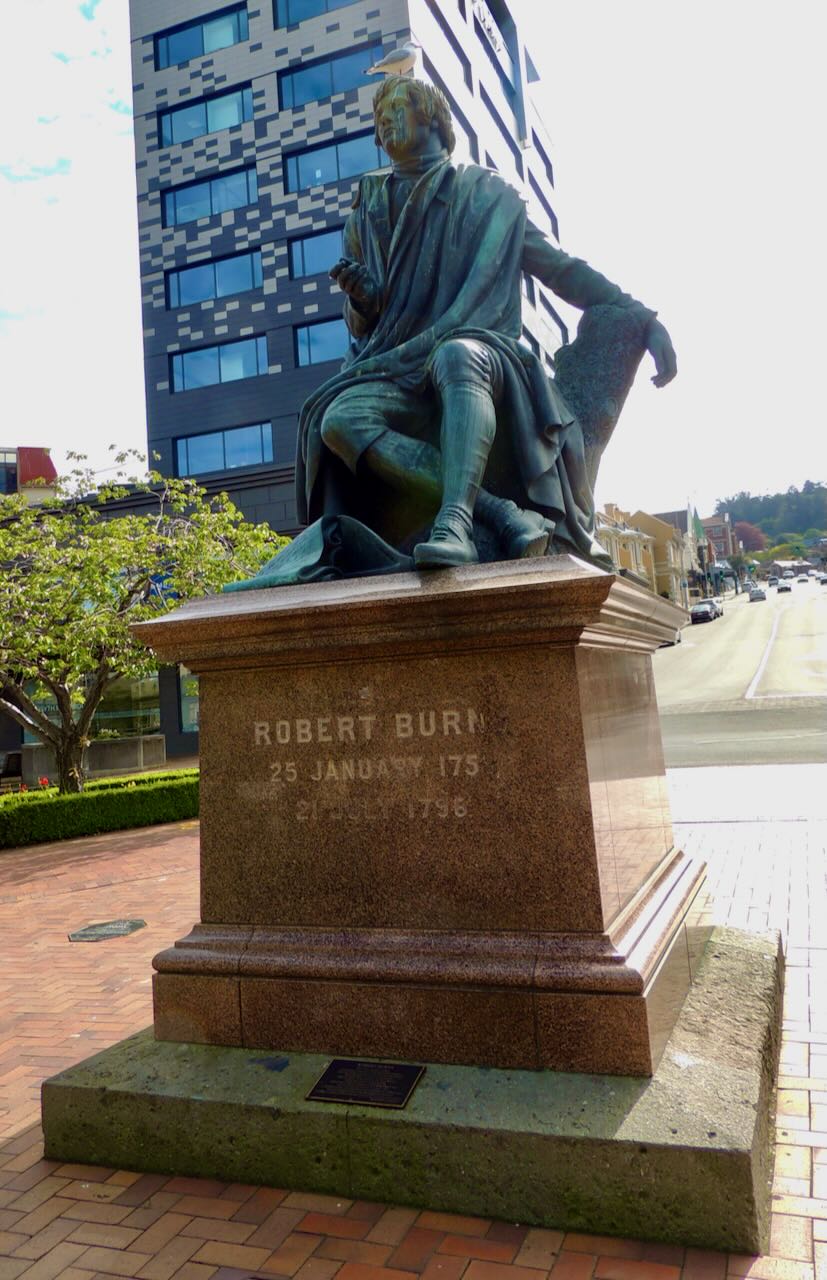 Robert Burns Statue
Robert Burns Statue
 Yellow-eyed Penguin Art
Yellow-eyed Penguin Art
 Northern Royal Albatross Art
Northern Royal Albatross Art
 Tui Art
Tui Art
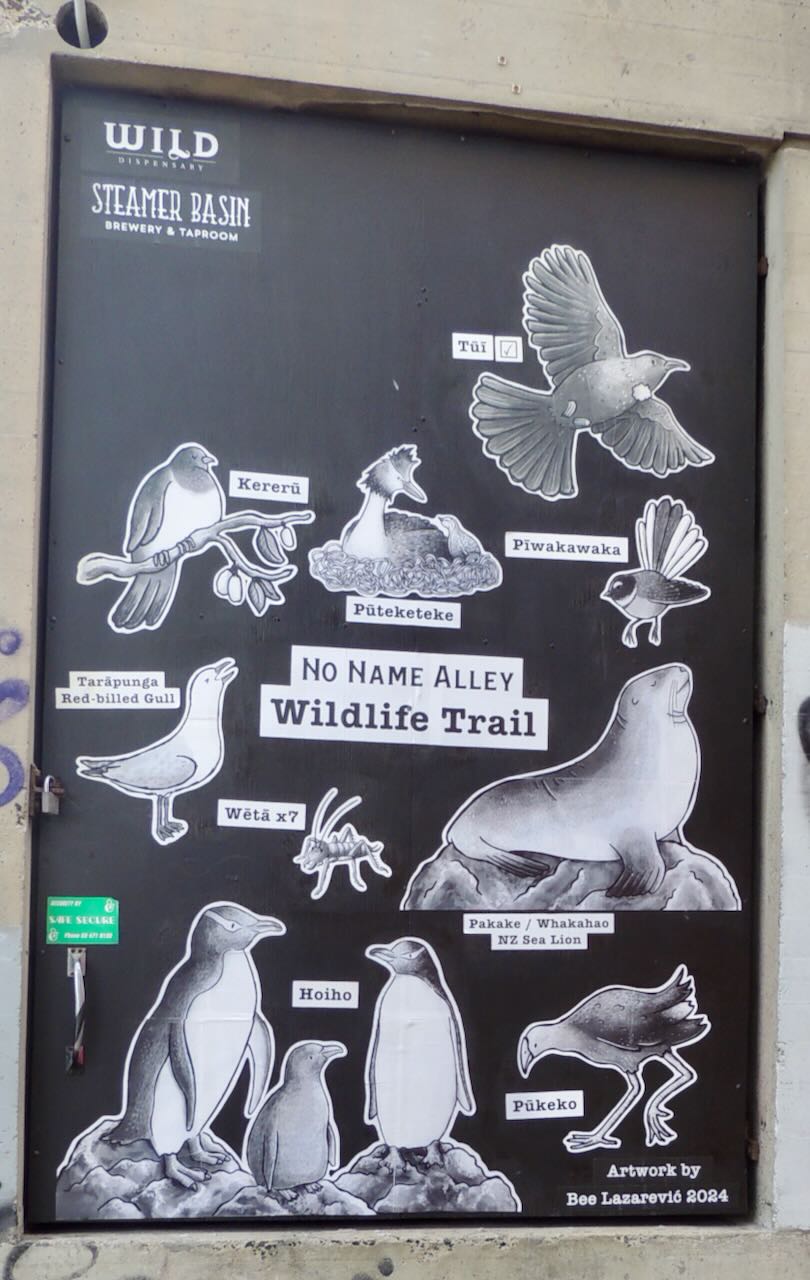 Dunedin Wildlife Art
Dunedin Wildlife Art
 Haast Eagle Art
Haast Eagle Art
 Woman with Binocular Art
Woman with Binocular Art
Sunday, October 20, 2024
Today featured many different activities, ranging from the natural to the peaceful to the downright weird. After breakfast, I walked to the Botanical Gardens. On my way, I saw Welcome Swallows at a nest under a bridge, and I photographed a perched one. My camera was not quick enough to capture them in flight. This species looks like a Barn Swallow and is the only swallow species regularly seen in New Zealand.
When I walked into the Botanical Gardens, the first bird I saw was an Eastern Rosella, a new bird for the trip. This parrot was introduced from Australia. A bit later when I walked to the Rhododendron Dell in the gardens, I found a nest cavity with Eastern Rosellas going in and out of it. When I left the gardens and began my walk home, a young couple stopped me and asked what I had been photographing, and I showed them a photo of a rosella.
The gardens had Kowhai trees, a favourite tree of Tui. Even though I saw some Tui, I still had not gotten a good photo of one. The Kowhai trees have yellow flowers, and I saw one of the large New Zealand Pigeons sitting among the blossoms.
Likewise, I had not been able to take a good photo of a Bellbird, even though I heard them in a great many places. They tended to move around a lot among the leaves, and I had had no luck catching one in the open. The gardens had a lot of Mallards, and the males seemed to be in an especially amorous mood. I shot video of one consummating his passion.
I went back to my motel for a bite to eat and then set off into a section of Dunedin I had not yet been. For some reason, I had not noticed a sign less than a half a block from my motel which said "Quaker Meetinghouse", with an arrow pointing up one of the side streets. Today, I went up that side street, and I do mean up. The street had a couple of very steep hills, as do a lot of streets in Dunedin. A couple miles from my motel was Baldwin Street, which claimed to be the steepest street in the world. I did not go to see it, but I walked up other very steep streets.
Because today was Sunday, some people were at the meetinghouse. When I walked in, a small group of women were sitting in a circle, singing. A couple of women came out and invited me in. They wanted to give me a cup of tea and asked me to stay for lunch. I politely declined. A lot of New Zealanders look happy, but these folks looked especially so.
My next stop was unexpected and weird. I saw a place called The Museum of Natural Mystery. Out front was a sign that said "Just the Right Amount of Weird". There was no handle on the outside of the door. You needed to use the door knocker, which was a crab made of metal. When I knocked on the door, a bunch of chihuahuas came running out and barked at me. The woman who answered the door I think was the partner of the guy who put the museum together. He was very interested in nature, and most of the items on display had something to do with nature or natural curiosities. He was also an artist, and a lot of his work used real animal bones. For example, he mounted a baboon skull on a bed of rabbit skulls. One of his works was a guitar made of bones. I spent about 45 minutes looking at the exhibits. When I had seen enough, I asked the woman with the chihuahuas to let me out.
A short way down the hill from the museum was the Dhargyey Buddhist Centre. I went because that was the starting point for the 2024 Dunedin Interfaith Walk for Peace. The walk went from the Buddhist Centre to the Anglican Cathedral and then to a synagogue. The centre had a shop, and I bought some small prayer flags. While I was waiting for the walk to begin, I spoke with a man named Bruce Spittle, who had written a voluminous work about alleged Moa sightings.
Before the walk started, about 20 of us gathered in a room which had an altar and a lot of Buddhist artwork and photos. Someone did a reading from A Guide to the Bodhisattva's Way of Life about the importance of eliminating anger from our lives. We all meditated silently for 20 minutes and then went outside to begin the walk. The cathedral was not far from the Buddhist Centre, and most of the walk was downhill.
In the late afternoon, I had another deep tissue massage at a place I had not previously been. While getting the massage, I heard gentle music, which was a relaxing way to end a day of roaming.
The word "gentleman" is used as a polite form of address, often for men who are not very gentle. I have found the people in New Zealand to be much gentler than the majority of the people I encounter in the US. And the Quakers and the Buddhists I was with seemed even more gentle than the typical New Zealanders. I felt comfortable letting my guard down when I was among such people. The gentleness was contagious, because I acted more gently in their presence.
 Welcome Swallow
Welcome Swallow
 Eastern Rosella
Eastern Rosella
 New Zealand Pigeon in Kowhai Tree
New Zealand Pigeon in Kowhai Tree
 Baboon Skull over Rabbit Skulls
Baboon Skull over Rabbit Skulls
 Bone Guitar
Bone Guitar
Monday, October 21, 2024
The forecast for today was for overcast and drizzly weather, so I visited a couple of museums. In the morning, I went to the Otago Museum, which was not far from where I was staying. It is a natural history museum, and as with the Museum of Natural Mystery I visited the day before. I saw a lot of bones (although these were much better organized). The museum had skeletons of animals from all over the world. I was very interested in some of the bird skeletons, especially the moas, some of whom were giant birds. Some species of moas were smaller, but they were still large enough to be hunted to extinction. The museum had a skeleton of the extinct Haast Eagle, the largest raptor who ever lived and a bird who used to prey on moas.
One section had the eggs of many types of birds. A few kiwis were on display, as were their eggs. Kiwis lay an egg that is twenty percent of their body weight, which would be like a 125-pound woman giving birth to a 25-pound baby.
Admission to the museum was free for the main part of the collection. It was child friendly, but children were expected to be kept under control. (One museum sign suggested that rowdy children would be fed to the lions.) If you paid extra, you could enter a portion of the museum which had a lot of interactive science displays as well as a section with tropical butterflies (and terrapins, spiders, a few birds, etc.). It was a multi-story space which was kept hot and humid to mimic tropical surroundings. The butterflies were fluttering around, and you needed to be examined before you left to make sure you didn't have any on your clothing.
In the afternoon, I went to the Octagon by way of Great King Street, which is the same street on which the Otago Museum is located. The university stretched for a great many blocks and was very large. This explained why I had seen so many students near where I was staying. I walked past some street art that made a statement about the dangers of air pollution. My destination was the Dunedin Public Art Gallery, which is on the Octagon. It was yet another institution that focused mainly on the culture of New Zealand. A major part of the items on display dealt with the history of museum. One painting was a still life with albatross feathers. One exhibition dealt with the idea of rewilding and showed how artists have explored gardens, the environment, and what might happen if nature prevailed.
The weather had warmed up a bit. Even though it was still not warm, I no longer felt like a Bill-sicle.
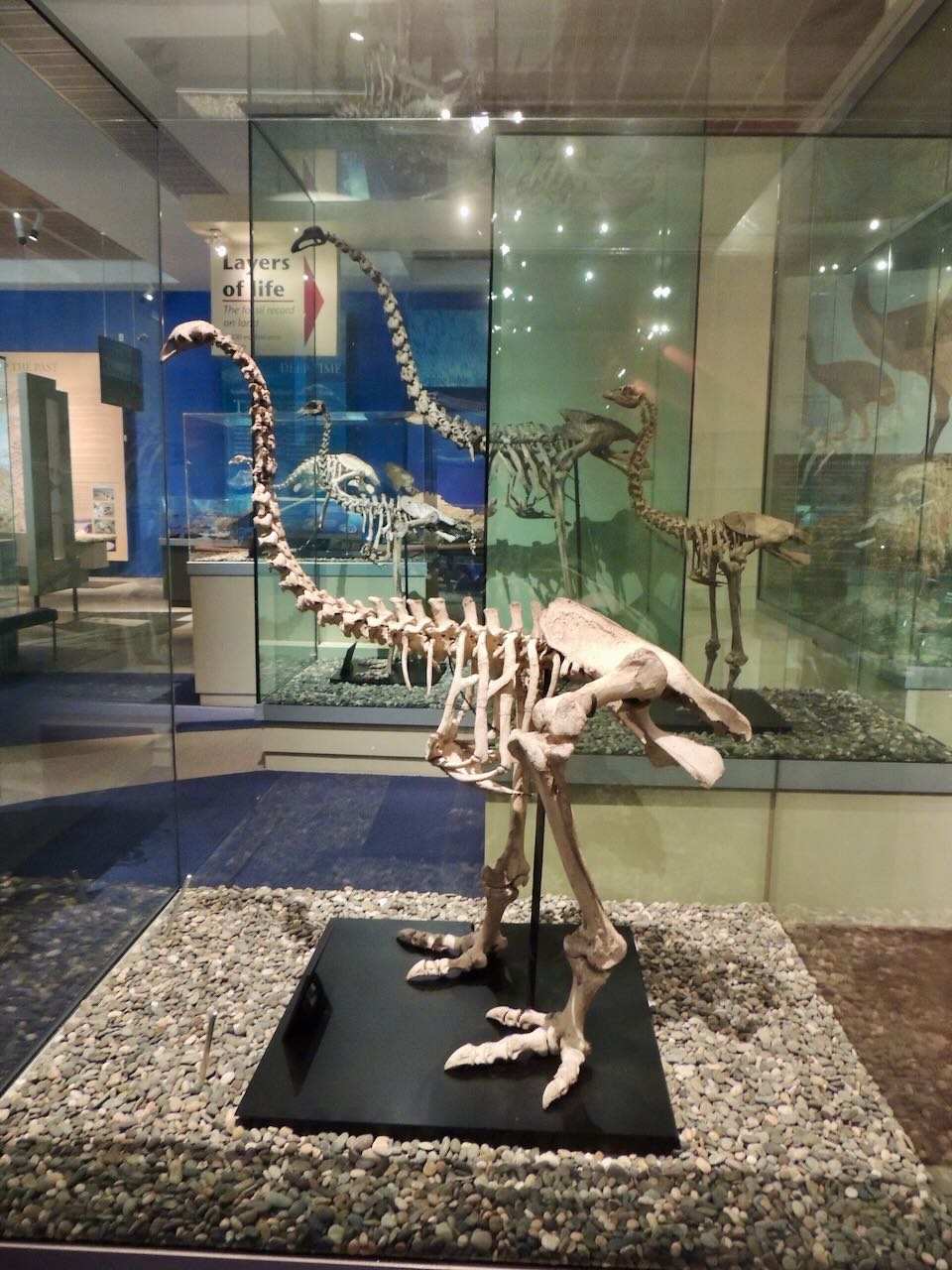 Moa Skeletons
Moa Skeletons
 Haast Eagle Skeleton
Haast Eagle Skeleton
 Stuffed Brown Kiwis
Stuffed Brown Kiwis
 Kiwi Eggs
Kiwi Eggs
 Rowdy Children Sign
Rowdy Children Sign
 Live Butterfly Exhibit
Live Butterfly Exhibit
 Air Pollution Mural
Air Pollution Mural
 Still Life with Albatross Feathers
Still Life with Albatross Feathers
Tuesday, October 22, 2024
The weather in Dunedin was overcast this morning. One of the guides on my trip last Friday said that the city has a lot of days when the weather is rainy and/or the skies are grey. I walked toward the Botanic Gardens, but I took a side trip to the nearby Woodhaugh Gardens. I walked on a path along the Water of Leith, which is a small river with the same name as a river in Edinburgh, Scotland. I heard Tui and Bellbirds in the trees, but I couldn't see any. Dunedin has a belt of green around the city. The city seemed much more urbanized than Christchurch, but the greenbelt is an area protected from development.
I doubled back and went to the Botanic Gardens. While there, I saw a Bellbird perched out in the open, but the light was so bad that none of my photos came out. Now that I knew which way to enter, I enjoyed the gardens a lot more. Not many bird species were active. I saw a lot of Dunnocks. The gardens had a lot of flowers in bloom. Especially noticeable were some Echium plants. Earlier in my trip, I had seen a species of violet-coloured Echium, but the ones in the gardens today were Echium wildpretii, which had long red spear-like flowers. The gardens had a number of sculptures. One sculpture near the information centre was based on the story of Peter Pan.
After I left the gardens, I headed up North Road. I had thought about going to see the steepest street in the world. However, when I walked past another street that looked impossibly steep, I decided it wasn't worth the time or effort. Dunedin is a REALLY hilly city. Some of the streets are so steep that you have to expend a lot of effort to walk downhill. I worked my way back toward the area where I was staying. On the way, I saw a wall painting featuring a Kaka, whose closest relative is the Kea.
I took a short nap, and when I woke up, the weather was sunny and clear. I made my way downtown for a Thai massage, which felt good after climbing a lot of hills in the morning.
 Dunnock
Dunnock
 Echium
Echium
 Peter Pan Statue
Peter Pan Statue
 Steep Street
Steep Street
 Street Art with Kaka
Street Art with Kaka
Wednesday, October 23, 2024
This morning, I spent about four hours wandering around sections of Dunedin I had not previously explored. I first went through the University of Otago's main campus. I had seen many of the university's buildings on some of the nearby streets, but I had not visited the campus. The city had about 135,000 people, and between students and staff, the university had about 24,000 people. That meant more than one out of every six people in Dunedin was connected to the university. Because my motel was so close to the campus, the percentage of students I saw was much greater. I also visited the university's library, which had an impressive collection.
I enjoy walking around in places when I have no set destination. I often stumble upon things I would not otherwise see. For instance, I walked past a parked car occupied by a skeleton in the front passenger's seat.
During my stay in New Zealand, I had been impressed by the number of flowers I had seen. Christchurch had more than Dunedin, but even in some of the very urbanized sections of Dunedin, I saw a lot of flowers by the footpaths. As with Christchurch, there is a large statue of Queen Victoria. It was not far from a tall obelisk which honoured New Zealanders who died in World War I.
In general, the natural environment seemed to be a much greater area of concern in New Zealand than in the US. The motel where I stayed provided me with a lot of information about their efforts to conserve water (showers were limited to 4 minutes) and reduce waste. This morning, I saw street art that had been created for Earth Day in 1990.
I walked past a store called Gun City, which claimed to be the world's largest gun store. A lot of New Zealanders hunt, but New Zealand has rather strict gun laws.
New Zealand drivers are not allowed to make turns on red lights as in the US. At some intersections, traffic stops from all directions to allow people to cross, which means you can cross the street diagonally. Both pedestrians and drivers have to wait a little longer under this system, but it seems to be safer.
The food in New Zealand was excellent. It was fresh and at most restaurants well prepared and presented. The seemingly high prices I mentioned earlier worked the other way at restaurants. For an American, everything cost only about three fifths of the stated amount, so a NZ$30 meal cost only US$18.
Today was one of the first warm days I experienced. I shed a few layers and at times was down to a tee shirt and flannel shirt.
This was my final full day in Dunedin before flying to Auckland, which is New Zealand's largest city. I sensed that quite a few people in the South Island were not fond of Auckland in the north. Some South Island people referred to it as "the smoke", which is how some British people living outside London refer to London.
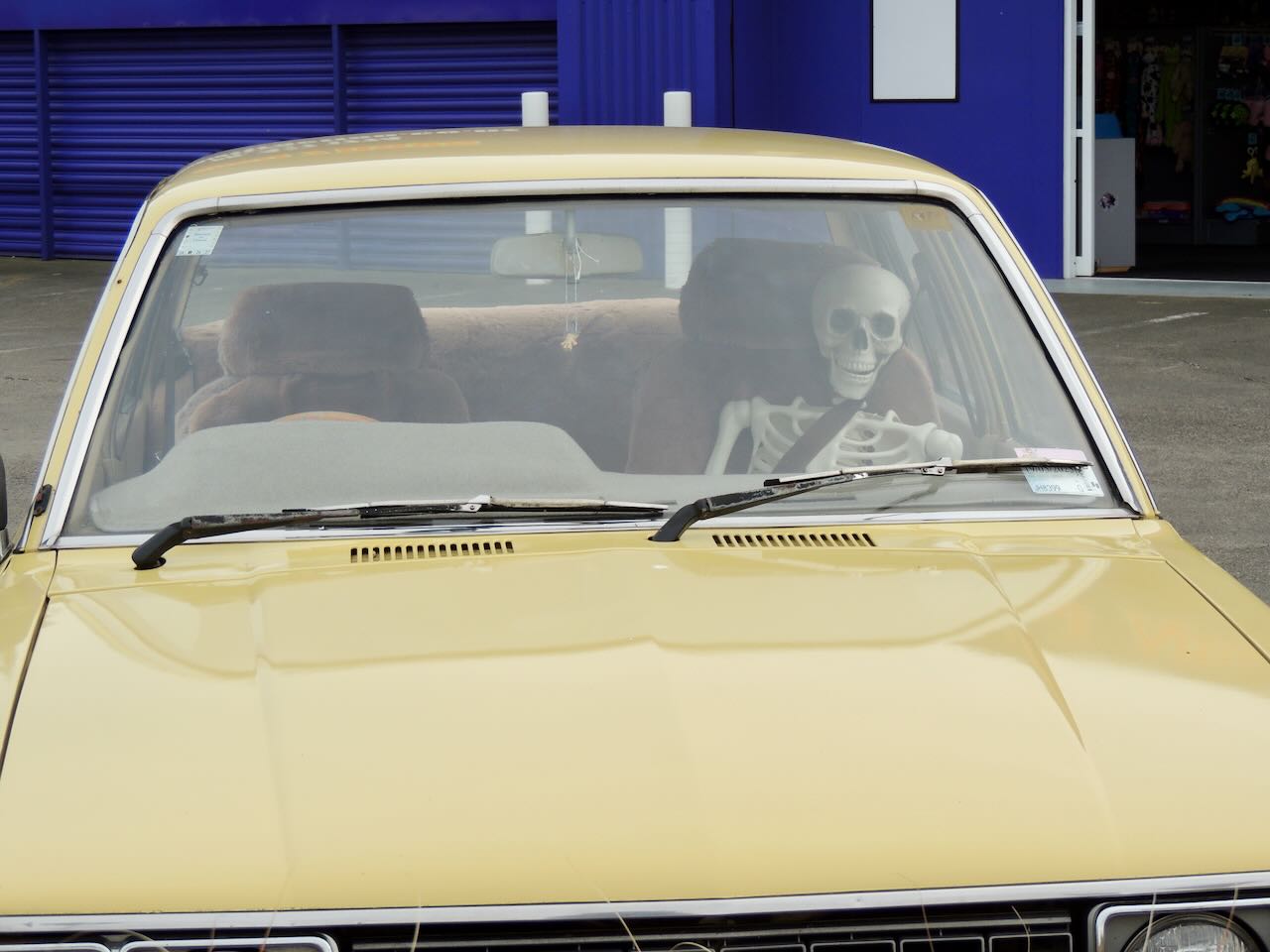 Skeleton in Car
Skeleton in Car
 Dunedin Roadside Flowering Bushes
Dunedin Roadside Flowering Bushes
 Queen Victoria Statue
Queen Victoria Statue
 Care for the Earth Sign
Care for the Earth Sign
 Gun City
Gun City
Thursday, October 24, 2024
This morning, I flew from Dunedin to Auckland. A driver picked me up at 7:15 and took me to the airport. She was from Charlottesville, Virginia, and she had been living in New Zealand for about 20 years. She gave some of the pros and cons of living in New Zealand. She said a lot of hospitals were old and needed to be updated. Drugs needed to be approved by the authorities in New Zealand, and she mentioned a cancer drug that had been approved for use in other countries 20 years before, but it had been available in New Zealand for only three years. As in the UK, if you had trouble getting service with the free health care system, you could use private medical care, which was quite expensive. She added that she had trouble getting close to people in New Zealand, and she found them to be reluctant to ask about personal things in other people's lives. She thought it might be because they did not want to appear to be prying.
My flight was uneventful, and I arrived in Auckland early. My taxi driver drove a Tesla, the second one I had ridden in since arriving in New Zealand. He was from Mumbai, and he had lived in Auckland close to 30 years. It seemed that once people came to New Zealand, they were reluctant to leave.
Unlike all of the places I visited, Auckland was really into building tall structures. My hotel had 36 floors. The tallest structure in the city was the Sky Tower, which I could see if I looked sideways out my bedroom window. It was more than 1,000 feet tall and looked like a giant minaret.
My room was very nice, with a full kitchen and a washer/dryer. One of the first things I did after putting away my luggage was to walk to a grocery store and buy food. I lugged it back to the hotel so that I would have something to eat for breakfast without having to go outside. On the way to the store, I went to the harbour to see where I would catch the ferry the following morning to Tiritiri Matangi Island.
I had dinner at the Joyve Cafe, a vegan restaurant. I had the vegan version of Peking duck, with cucumbers and mushrooms. It was quite tasty. Some of the food in New Zealand restaurants was different from what you saw on US menus. A lot of restaurants offered dishes with venison. I also saw dishes with beef cheeks, which is exactly what it sounds like; the meat is cooked slowly and is similar to brisket.
Even though smoking and vaping was banned in most public places, vaping was very popular, and I saw a lot of people vaping and a lot of vape stores. I also saw a lot of tattoo parlours. I sometimes saw Maori women with a moko kauae, which is a chin tattoo.
 Sky Tower
Sky Tower
 Vape Shop
Vape Shop
 Tattoo Parlour
Tattoo Parlour
Friday, October 25, 2024
Peter Greenaway made a film called A Zed and Two Noughts about which he said that all animals now were in zoos, whether in Regent Park (home of the London Zoo) or Yellowstone Park. I thought about that today when I went to Tiritiri Matangi Island, a magical place that is 90 minutes from Aukland by ferry. Humans have reduced the habitats of wild animals, and an increasing number are living in areas that are now totally surrounded by development. Birds can fly away, but flightless animals are now trapped in smaller and smaller spaces.
The situation is somewhat different in New Zealand. Many New Zealand birds evolved in an environment with few natural predators. When the Maoris and the Europeans introduced predatory mammals, birds who nested and/or fed on the ground were either wiped out or severely harmed. Only in places such as Tiritiri Matangi and other reserves which have eliminated the deadly introduced mammals can many bird species continue to exist. It is not clear to me whether they are actually wild birds. Some have been relocated from other places. They are carefully monitored, and some reserves send species to other reserves to broaden the gene pool and give the birds a better chance to survive. Some species would be extinct were it not for human intervention. But the question remains as to how much can humans intervene before the birds cease to be wild.
I hired a private guide named Peter who took me around the island. We went to a beach and had good looks at Whiteheads, who are small birds with a white head. In the same area, we saw North Island Saddlebacks, who have a russet saddle across their black back. Saddlebacks are in the wattlebird family, and they have red wattles on their face. They were confiding and hopped on the ground not far from where we stood. Their vocalization had the rhythm of a car engine trying to start.
A bit later, we saw a vulnerable species called a North Island Kokako, who is also a wattlebird. Kokako are about the size of a chicken, and their wattles are blue. They can be difficult to find. However, while we were near a water trough, a Kokako hopped right in front of us and then fed in nearby trees for a considerable time. My guide estimated that fewer than one percent of New Zealanders have ever seen this species. Human intervention helped them to survive. At the same trough, a New Zealand Bellbird came to drink and bathe.
The New Zealand Flax was in flower, and a lot of birds were feeding on it, including the Tui. One of the women working on the island had a Tui tattooed on her arm (a Tat-tui?).
I saw a couple other new birds for the trip. Brown Quail fed on the paths. These very small quail somehow got to New Zealand on their own. I saw a vulnerable bird called a Stitchbird, or Hihi. The males are black, white, and yellow. Stitchbirds dart around quickly, but I had good looks at a couple of them. I photographed my first Australian Magpie of the trip. This species is not a corvid and is not related to the magpies in the US and Europe.
As we headed back to the docks, we saw people standing near a small pond where a Brown Teal was feeding. This highly vulnerable species is found only in New Zealand. They used to be common, but they were almost wiped out by mammalian predators — different species, same story. This is why places such as Tiritiri Matangi Island are so important.
Auckland was the first large city I had been in during my trip, which was a bit jarring and took a bit of adjusting. However, the city also offered a lot of things that are more difficult to find in smaller areas. Yesterday, I had a minor emergency when I was walking down the street and my belt buckle broke. It was the only belt I brought with me, and because I had lost a lot of weight last year, wearing a belt was a necessity. I found an H&M store on Queen Street and bought a new belt. Along with the noise and the crowds, cities often have many more avenues for addressing needs.
 North Island Saddleback
North Island Saddleback
 North Island Kokako
North Island Kokako
 New Zealand Bellbird
New Zealand Bellbird
 Tui
Tui
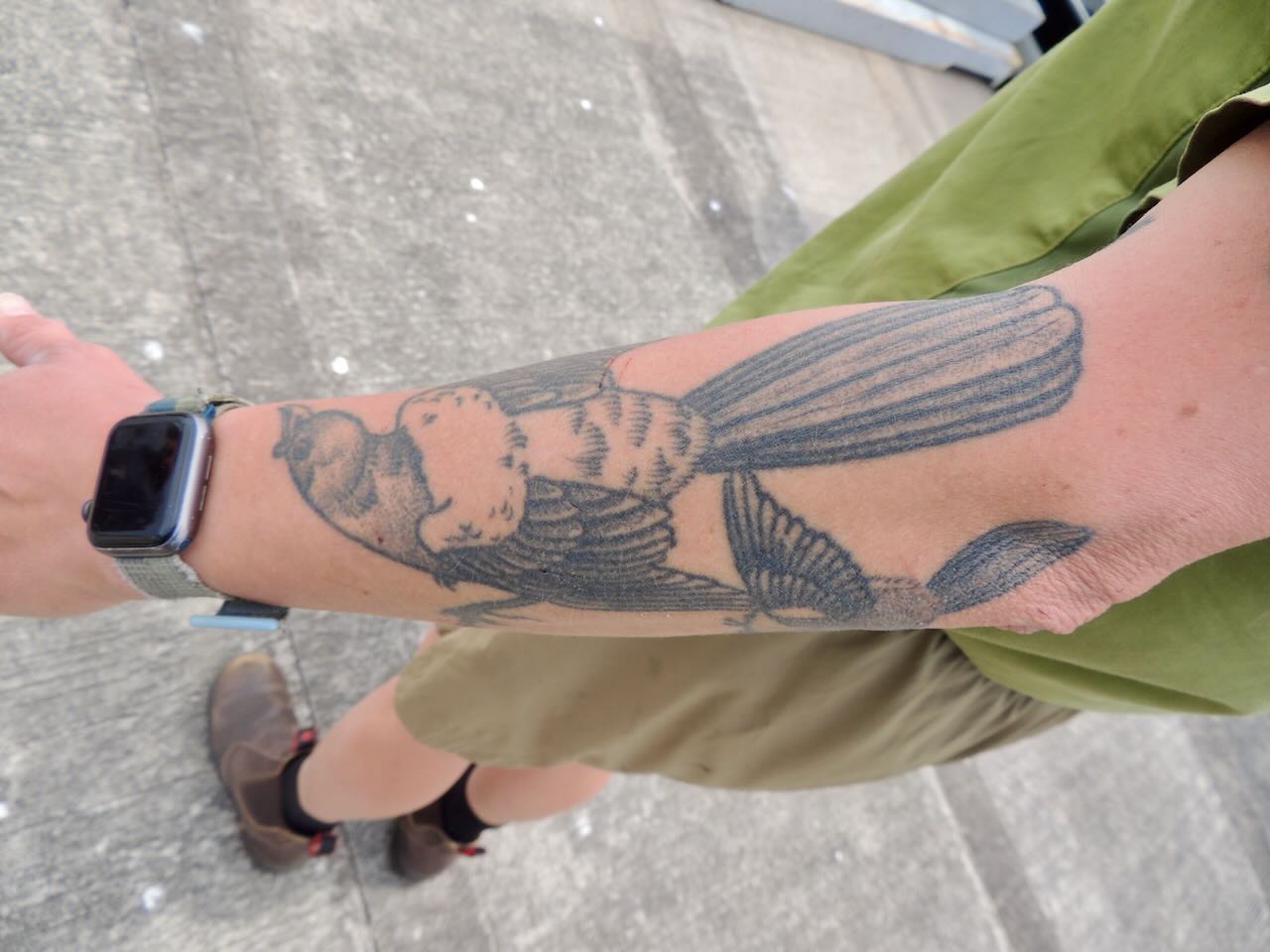 Tat-tui
Tat-tui
 Australian Magpie
Australian Magpie
 Brown Teal
Brown Teal
Saturday, October 26, 2024
On Saturday mornings, Auckland has a number of farmers markets. I went to one not far from the shoreline, about a 10-minute walk from where I was staying. Then I walked two miles to a much bigger one near Parnell Street. The street was named after Samuel Parnell, who was instrumental in achieving the eight-hour workday for New Zealand. His name is linked to the Labour Day holiday in New Zealand, which would occur two days later. As with the Labor Day holiday in the US, it is a day when most people don't work.
The weather was overcast, and not many flowers were in bloom. I had mentioned that when I was on the South Island, many houses had flowering trees. I did not see much of that in Auckland. The areas called parks had large expanses of grass and some trees, but they were "urban" parks. The birds I saw were mostly urban birds. I added a new species for the trip this morning — the Common Myna. It is an introduced species in the same family as starlings. In areas which have both species, the mynas usually outcompete the starlings.
The first market I visited had a lot of stalls selling ethnic foods. Among them was a stall selling Trinidad food. Auckland seemed like a very multicultural city. I saw a lot of Maoris, East Asians, and South Asians, and a few Africans. Some stalls had various knickknacks. None of the items looked especially valuable or noteworthy, but seeing tables such as this at markets made me wonder who made all this stuff and for whom did they make it.
I walked a long way along Parnell Street to get to the second market. I saw a lot of shops and restaurants along the way. I walked past a house that had Halloween decorations. Halloween here did not seem as big a deal as it is in the US. Perhaps people in the US view it as a bigger marketing opportunity before they go all out with Christmas marketing.
The Parnell market had a community feel. A lot of stalls sold fruit and vegetables. Some sold flowers. I spoke with one woman who was at a stall whose purpose was to provide information about what people could do to mitigate the effects of the climate crisis. She had moved to New Zealand from Norway about 25 years earlier. She was worried about the US elections. Some people I talked to seemed perplexed about what was going on in the US and why it was happening. I lived there, and I felt the same way.
 Common Myna
Common Myna
 Auckland Market Knickknacks
Auckland Market Knickknacks
 Halloween Decorations
Halloween Decorations
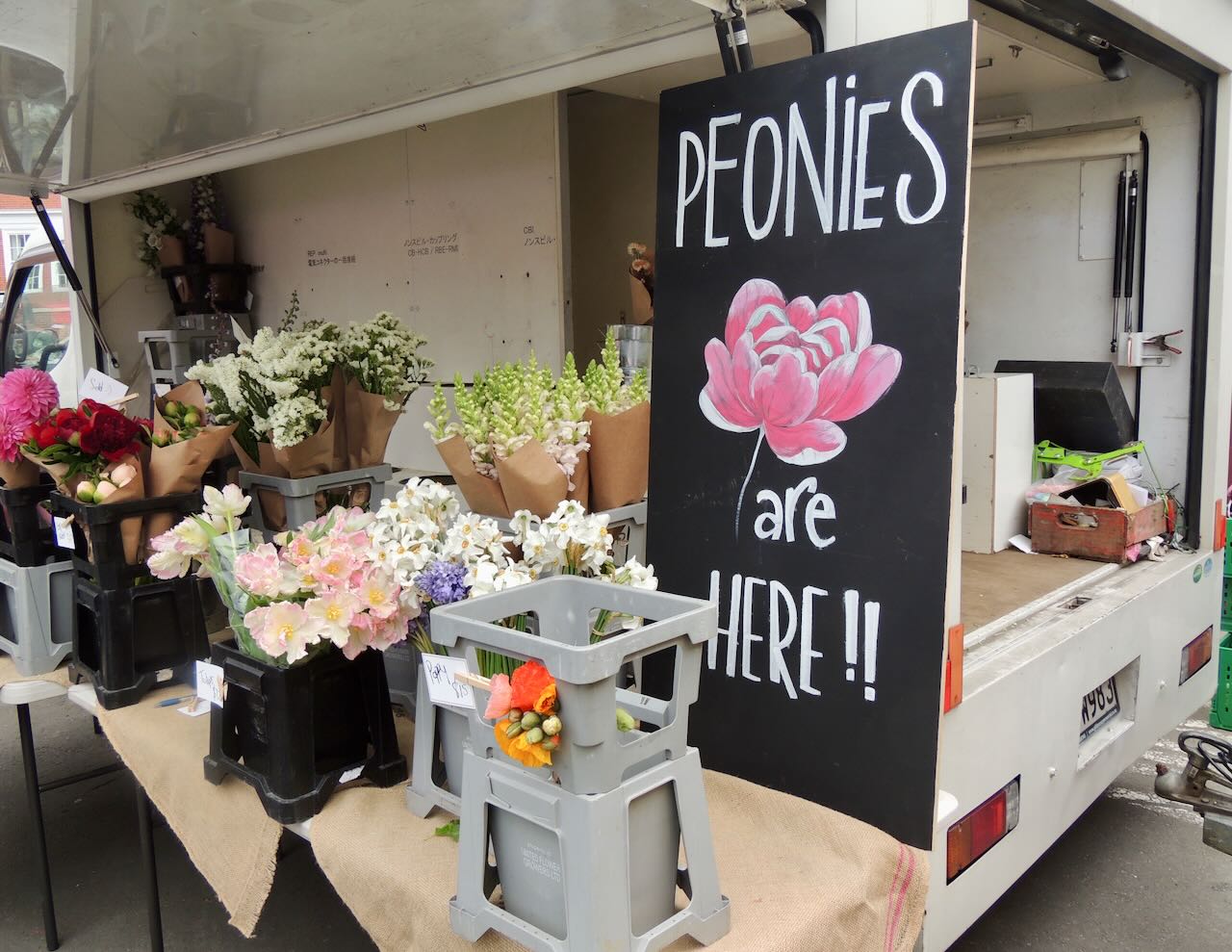 Flowers in Auckland Market
Flowers in Auckland Market
Sunday, October 27, 2024
Today, I did not see any new bird species, but I learned ever so much. I had asked to hire a private guide for Tiritiri Matangi on Friday and Monday, but the person I asked accidentally gave me guides for Friday and Sunday. I'm glad she did, because my guide was a woman named Sahrah who was working on a PhD in disaster risk management and knew an incredible amount about the wildlife on Tiritiri and a lot of other subjects. I was with her for 7 1/2 hours, and she taught me many things.
One of the protected species on the island is an insect called the Giant Weta. They are really large, and we found a few on our walks. They can weigh 35 grams, which is more than most songbirds. A female carrying eggs can weigh twice that much.
On a tree, we saw Mouse Ear Fungi, which looked a bit like a grey furry mouse ear. The underside, when seen in good light, looked orange. We saw the small green ball-like growths on a Kohekohe tree, which is also called the New Zealand mahogany.
I had really good looks at a threatened bird species called a Stitchbird, or Hihi. One of its distinctions is that it is the only bird species known to mate face-to-face. The male knocks the female down, and when she lands on her back, he jumps on her and mates. This species had a small population, and boxes were placed around the island showing the intricate nests they build.
The North Island Robin is a friendly little bird who is not afraid to come close to people. The trick of scratching the ground to attract the South Island Robin to come closer also worked with this species. The robin came to the disturbed ground to look for arthropods. Today, we saw a robin catch a centipede. I recorded video of a robin who vibrated her right leg to simulate the sound of rain, which might bring arthropods to the surface.
I got to know some of the volunteers and guides at Tiritiri, and they were a remarkable bunch. Sahrah gave me her guide button to make me an honorary guide. Some of the volunteers appreciated my interest in what they did. Tiritiri was certainly one of my favourite places in New Zealand.
 Giant Weta
Giant Weta
 Top Side of Mouse Ear Fungi
Top Side of Mouse Ear Fungi
 Underside of Mouse Ear Fungus
Underside of Mouse Ear Fungus
 Kohekohe Tree
Kohekohe Tree
 North Island Robin
North Island Robin
Monday, October 28, 2024
Because today was Labour Day in New Zealand, the ferry ran between Auckland and Tiritiri Matangi Island. It usually did not run on Mondays. I spent my third day on Tiritiri out of the last four. I went multiple times because the island is quite large, and it was not possible to visit all the trails in a single four- or six-hour visit. I walked on trails today that I had not walked on during my previous two visits. What you see on a trail at a particular time might not be what you will see on the same trail an hour later or the next day. Likewise, you might see birds in the afternoon that you did not see when you visited the same spot in the morning.
Tiritiri is a scientific research station which allows the public to visit. Many of the guides were people who did research on the island. They clearly loved what they did, and they communicated their love and knowledge to people who visit. My guide today was named Ian who knew a great deal about the flora and fauna on Tiritiri as well as about Captain Cook. I learned a lot.
New Zealand Flax was a common plant on both the North and South Islands, but the flax I saw on the South Island was not in flower. The flax in the north was, and quite a few birds like the nectar from the flowers. Red-crowned Parakeets (the species who ate fruit out of my hand at Hinewai) are ground feeders, so they have been easy prey for rats, weasels, and stoats. Tiritiri has none of these, so the parakeets could live there. I saw a few this morning, including some at the red flax flowers.
Tui also love flax flowers, and I saw some of them at flax plants. Near where I photographed the parakeets were a pair of Brown Quail. These birds looked very small when I saw them up close. Some Stitchbirds were very active around one of the nectar feeders. They have small tufts of white feathers over their eyes which they can raise when excited. I also saw Manuka trees in flower.
On the lawn outside the bookshop was a leucistic male Paradise Shelduck who had a lot of white on the head instead of having a solid black head. Inside the bookshop, I saw a couple of Rebecca's New Zealand Fungi books on sale. The copy I bought was wrapped up to survive my flight home. I have since looked at it, and it is a remarkable piece of work.
 Red-crowned Parakeet in Flowering Flax
Red-crowned Parakeet in Flowering Flax
 Tui in Flowering Flax
Tui in Flowering Flax
 Pair of Brown Quail
Pair of Brown Quail
 Male Stitchbird
Male Stitchbird
 Leucistic Male Paradise Shelduck
Leucistic Male Paradise Shelduck
 Rebecca's New Zealand Fungi Book
Rebecca's New Zealand Fungi Book
Tuesday, October 29, 2024
One reason I do not like tall buildings is that they are not on a human scale. Many are designed to make people feel small. I had not seen such buildings in Christchurch and Dunedin, but in Auckland, they were all over the place. My hotel — the Avani Residences in the central business district — had 36 floors. It was across from Albert Park, which was named after Queen Victoria's husband. The park had a statue of Queen Vic — I also saw statues of her in Christchurch and Dunedin. The park was on the site of the Albert Barracks, which was a military installation in the 1800s. The Albert Park Volcano erupted 145,000 years ago, covering in ash much of the area where the park was now located. I had to walk up a steep hill and then some steps to get to the park, which I think was part of the volcano. There were not many birds in the park, but I saw a Sacred Kingfisher land in a tree. They are the only kingfisher species who regularly occurs in New Zealand.
I then walked to the Sky Tower on Victoria Street. It is the second tallest freestanding structure in the Southern Hemisphere. The base and lower portion of the structure were concrete and not especially attractive. The tower looked like a rocket with a ruffled collar. As with the Eiffel Tower in Paris, it is a landmark that can be seen from far away. I could see it from Tiritiri Matangi, which is 30 kilometres away.
I had to run a couple of errands. I wanted to get a shiny $2 coin, because it had an egret on it. I had planned to have a set of New Zealand dollar bills framed, because each denomination had a different species of bird on the reverse side. I then went to a post office and bought a stamp with a Tui on it. On the way to the post office, I saw a coffee shop that had artwork featuring a Sacred Kingfisher, the species I had seen earlier at Albert Park.
The weather in Auckland could change quickly. It was sunny when I left, with no forecast of rain. As I was walking, the wind picked up, and there was a shower. Then the sun came back out. The weather forecasts were not especially accurate. It might have had something to do with the country's proximity to the sea. Weather blew in and out quickly and sometimes unpredictably. You had to adjust to the rapidly changing conditions. Steve later told me about a song by the band Crowded House called "Four Seasons in One Day", in which the Auckland weather was used as a metaphor.
 Avani Residences
Avani Residences
 Queen Victoria Statue in Albert Park
Queen Victoria Statue in Albert Park
 Sky Tower
Sky Tower
 Sacred Kingfisher Artwork at Coffee Shop
Sacred Kingfisher Artwork at Coffee Shop
Wednesday, October 30, 2024
I'm somewhat more tolerant of vandalism if it is creative. This morning, I saw a sign that was part of a program to educate parents how to raise kids who aren't afraid of failure. The sign showed a young girl with a basketball. However, a real estate agent neatly put a flyer in the upper left corner, so the sign read, "KEEP YOUR KID STOPPABLE" instead of unstoppable. I doubt the estate agent did this on purpose.
My first stop was the Auckland Public Library. It felt airy and roomy, and many of the books were displayed with the cover rather than the spine facing outward. It meant that fewer books could fit on the shelves, but the cover art designed to lure in readers was visible. I spent about an hour there, mainly looking at books about New Zealand trees.
A short distance from the library was the Auckland Gallery of Art, which was a couple of blocks from where I was staying. The gift shop had a lot about artists from around the world, but the art collection focused primarily on New Zealand. One work was a large, knitted octopus, which represented Pacific Island weaving traditions, especially in the Cook Islands.
I am very interested in how birds and nature are portrayed in art. One painting showed New Zealand's only native owl species, the Morepork. The Maori name for the species is the Ruru. Rurus are thought to be guardians of the spirit world. Because many owls (including the Morepork) are nocturnal, cultures around the world associate them with the dark world of the spirits. The museum had an exhibition called Modern Women: Flight of Time. Included in the exhibition were several works by the sculptor Molly Macalister. One sculpture was called Bird Watcher. Macalister was a Zen Buddhist, and the sculpture represented a sense of spirituality and peace. Another one of her sculptures was called Fantail. It was an abstract representation of a species I had seen many times on my trip.
A hallway in the museum showed paintings with a Gothic theme. One of them, called "Limbo Bay", showed a colony of watchful seabirds, inspired by a trip the artist had taken to the Subantarctic islands. The exhibition had a painting by Ngaio Marsh, who is the famous New Zealand writer of detective novels (and whose name often shows up in crossword puzzles).
A strange painting was about the marriage at Cana in the New Testament. Winifred Knights painted a table occupied with bored-looking guests, all of whom were barefoot and had a plate with a slice of watermelon on it. The dark pink of the watermelon contrasted the brown-green earth tones in the rest of the painting. She included herself among the guests, along with friends and lovers.
After lunch, I went back to the gallery for the 1:30 guided tour. A docent leading a tour usually tells you a lot of things you might not have noticed on your own. One work was a video installation which showed people in canoes circling a Swedish ship called the Don Juan. The ship sank off the coast of Dunedin. In the 1800s, the ship had been involved in the slave trade — specifically in the practice of "blackbirding", in which masses of people were abducted from across the Pacific and forced into slavery in faraway countries.
Keep Your Kid Stoppable
 Knitted Octopus
Knitted Octopus
 Morepork Painting
Morepork Painting
 Birdwatcher Sculpture
Birdwatcher Sculpture
 Fantail Sculpture
Fantail Sculpture
 Limbo Bay
Limbo Bay
Thursday, October 31, 2024
This morning, I headed for the shoreline and walked along the waterfront. Auckland is a port city, and a lot of boats come in and out, including huge cruise ships. I saw a couple on my walk. There is also a lot of shipping traffic, with cargo ships unloading their goods. One spot had a stone that acknowledged a gift of 3,000 acres by the Maoris to establish the city of Auckland. I doubled back and went past the place where people boarded the ferry to Tiritiri Matangi. I saw some of the Tiritiri guides and chatted with them — one of them recognized me. I had accidentally deleted some of the voice notes I made on my camera, and a couple of the guides helped me to identify three of the plants I had seen on Monday.
A free ferry ran from downtown Auckland to a neighbourhood called Wynyard. I boarded a boat whose name was the MV Hogwash, which did not inspire a lot of confidence. I had not carefully read the information about the ferry. It left the dock slowly, went slowly for a bit, then stopped. I thought there was some sort of problem, but when I turned around, I saw the other two passengers had gotten off. The ferry was in service while a bridge was being repaired, and the ride lasted about three minutes and travelled less than a couple hundred meters. I walked around Wynyard for a bit, but there was not much to see other than some restaurants and fish markets. I found some street art, part of which featured a woman with a Tui. I did not stay long and caught a ferry back to downtown.
I slowly made my way to the Auckland Art Museum, both to see parts I had not seen the day before and to look again at some of the work I had seen before I heard the docent's explanations. One piece was a reproduction of a fish trap the Maoris used. When the tide was high, the fish would go into the wide area at the top. When the tide ebbed, the fish would be trapped. The artist created the piece entirely out of clam shells.
After lunch, I had a deep-tissue massage with my massage therapist Mona. She was a diminutive young woman with tiny hands, but they seemed to be strong enough to crush concrete. During the massage, comforting soft instrumental music played in the background. After the massage, I went to the Joyve Cafe, which also played soft instrumental music. I thought about this after stopping at a restaurant the previous day which played loud, pulsating music. It made me think about how background music affects people's behavior.
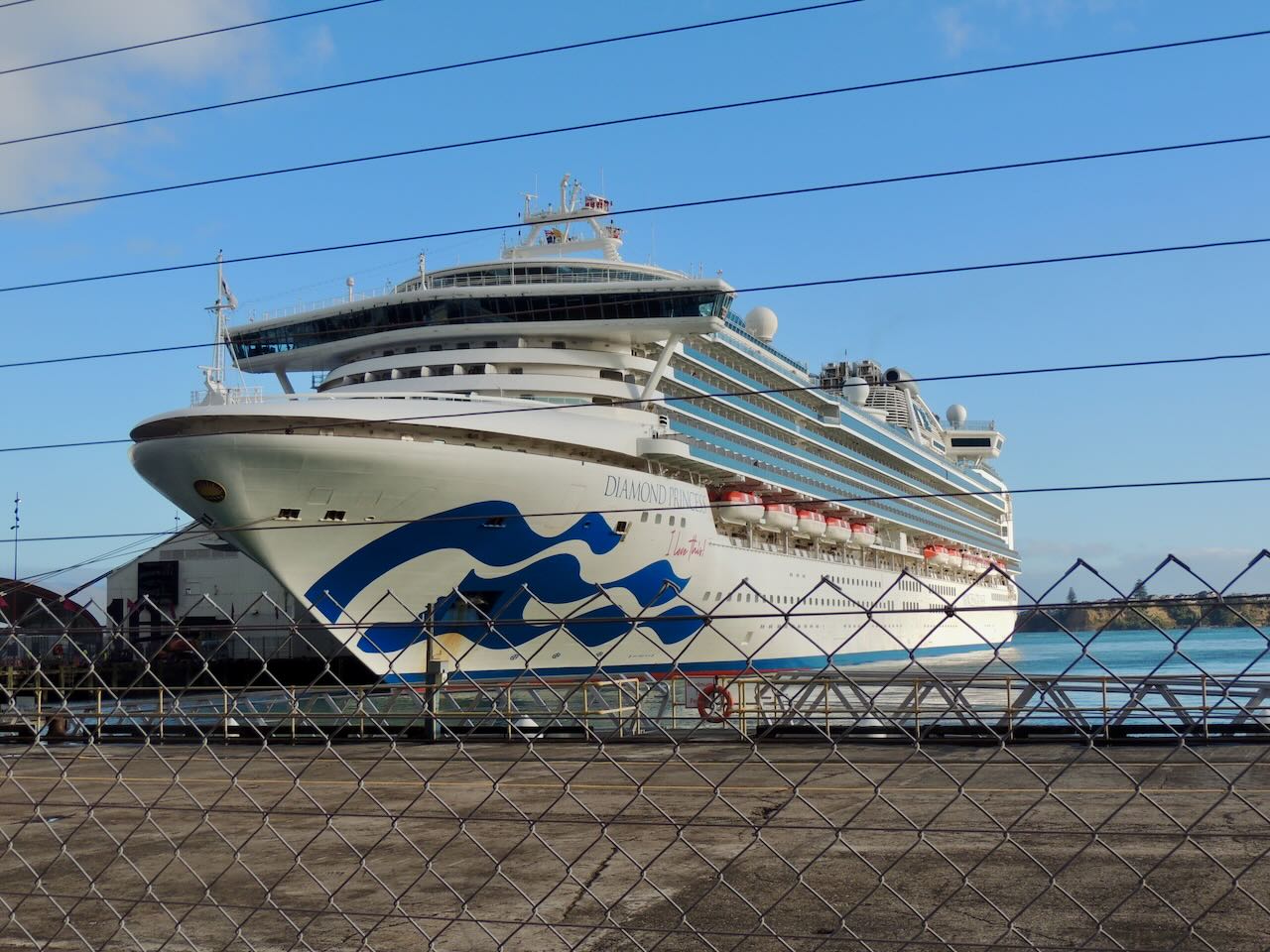 Cruise Ship in Auckland
Cruise Ship in Auckland
 Auckland Port
Auckland Port
 Maori Stone
Maori Stone
 Hogwash Ferry
Hogwash Ferry
 Tui Street Art
Tui Street Art
 Fish Trap Made of Clam Shells
Fish Trap Made of Clam Shells
Friday, November 1, 2024
On my final full day in New Zealand, I returned to Tiritiri Matangi. It was my fourth visit in eight days. I had already seen a lot there, but I had barely scratched the surface of what there was to see. On weekends, the trips to Tiritiri lasted 6 hours. On weekdays, they lasted only 4.
My guide was named Jane, and she knew a lot about the plants and birds on the island. One of the birds I wanted to see was a Fernbird. It is a small brown bird with an unusual tail. Most of the birds on Tiritiri were not afraid of humans and were relatively easy to see. Not the Fernbird. They are extreme skulkers who like plants in the Muehlenbeckia genus. We spent most of the morning looking for one without luck. After lunch, we located one near the house where people could stay overnight. I saw a small brown bird with a droopy tail fly into a bush and disappear. I never saw it through my binocular.
However, while we waited for the Fernbird, a rare bird called a Takahe began to forage in the grass near where we were waiting. This species was thought to be extinct but was rediscovered in the 1940s. Tiritiri had a pair on one side of the island and another pair on the other side. The island used to have more, but the Takahe devoted more time to fighting than to breeding, so the number was reduced. I had little hope of seeing one, because the pair who nested near the Fernbird site had just hatched a chick about a week earlier, and they are very protective during this period. Nonetheless, one of the adults came out and foraged in the grass. Except when breeding, these birds are usually out in the open, and there were signs warning people that a Takahe might steal their food.
Takahe look a lot like Pukeko, who are very common, including on Tiritiri. In fact, they used to be the same species before diverging a long time ago. Takahe can't fly, but Pukeko can. Takahe have larger bodies and a larger red bill. They have a green back, while the Pukeko's back is dark.
Tiritiri had a lot of Tui, most of whom didn't stay still. But I took a photo of one showing his pois, or the curled white feathers on the breast. The word "poi" in Maori culture means "ball on a cord", and the Maoris use them for dance performances and to improve strength and coordination.
We spent a lot of time looking at plants. One common plant was the Kawakawa, which has heart-shaped leaves. I saw quite a few leaves that had been damaged by a particular species of caterpillar. The plant sends a substance to the damaged area, and the Maoris use the damaged portion of the plant as an anaesthetic, which works like Lidocaine. I also saw a lot of Rasp Ferns, so named because they have a rough surface that feels like a rasp. Young Rasp Ferns are red, and they turn green as they get older. One way to remember the name is that the young red ferns are red like raspberries.
At lunchtime, I bought some things at the Tiritiri gift shop and spent all of my remaining New Zealand cash. One of the items I bought was a fleece jacket with the Tiritiri logo on it. These are usually sold only to Tiritiri guides, but the woman at the gift shop sold me one because of how often I visited the island. I could have done my entire trip to New Zealand using only credit cards and no cash. Credit cards are used even for small purchases. You might be charged a fee to compensate for the charge the credit card companies imposed on the vendor.
When I boarded the ferry to return to Auckland, I felt as if I wanted to return to Tiritiri someday. People are allowed to sleep on the island if they bring their own food and bedding. If you arrive on a Sunday, you can stay until Wednesday and have the island mostly to yourself, because the ferry does not run on Monday and Tuesday. That is what I hoped to do in 2025.
 Takahe Warning Poster
Takahe Warning Poster
 Takahe
Takahe
 Pukeko
Pukeko
 Tui Showing Pois
Tui Showing Pois
 Kawakawa Damage
Kawakawa Damage
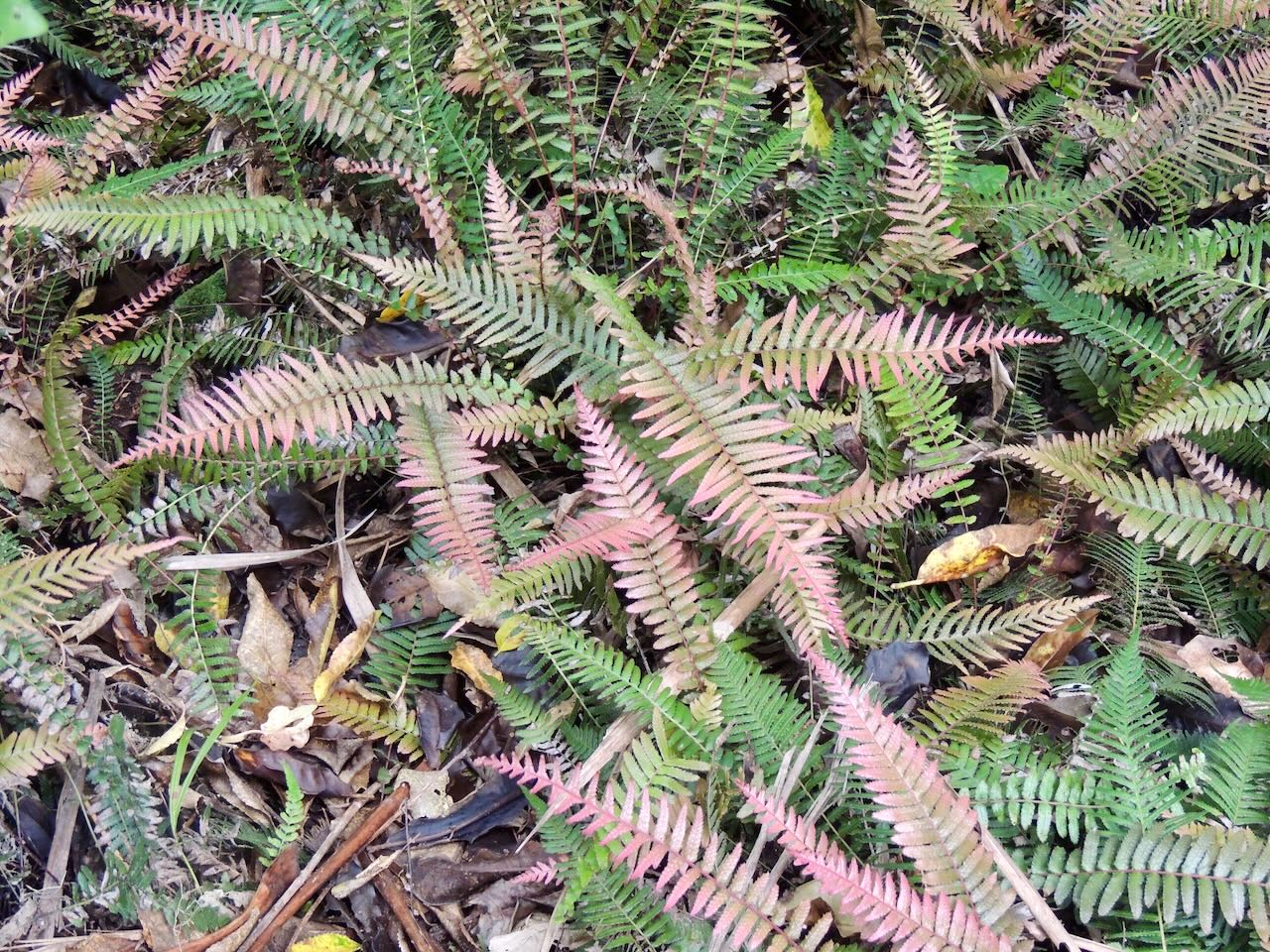 Rasp Ferns
Rasp Ferns
Saturday, November 2, 2024
I rose early, cleaned my hotel room, and finished packing. I took a walk along a portion of Queen Street which contained a theatre district. I stood in front of one electric sign which showed the events at various entertainment venues. One show was about Lord of the Rings and was promoted as "the greatest show on Middle Earth". I stopped briefly at the library before heading to the Joyve Cafe for one final meal. I had gotten to know the owner, and when I looked on my credit card statement after I got home, I saw that he had not charged me for the lunch. I had one final deep tissue massage with Mona before heading back to my hotel to collect my luggage. The cab driver was a young man from India who had been in New Zealand about ten years and really loved it. I heard this story over and over again.
I was not looking forward to returning to the United States. I felt comfortable in New Zealand from the moment I arrived, and I had a respite from the politics in the US. The people in New Zealand seemed much less aggressive and self centred than Americans. They also seemed much more patient and in less of a hurry. Except for some places in Auckland, people smiled a lot and seemed happy. People seemed to look out for each other rather than only for "number one". The problems talked about in the local news seemed trivial compared to US problems.
I sent an email to a list of friends and family every day of the trip. The emails arrived in the US when many people were sleeping — New Zealand time was two-thirds to three-quarters of a day ahead of most of the US. I hoped that people on the list would prefer to wake up to news about my New Zealand adventures rather than reports about the election. I also hoped that through the emails, people could enjoy hearing about my adventures even a portion as much as I enjoyed experiencing them.
I saw a few rainbows while I was in New Zealand. My favourite was from the ferry to Auckland from Tiritiri Matangi. The island was under the rainbow, and that is where I wanted to go again.
 Rainbow Seen from Tiritiri Matangi Ferry
Rainbow Seen from Tiritiri Matangi Ferry
Bird Species Seen on New Zealand Trip
Canada Goose
Mute Swan
Black Swan
Paradise Shelduck
Australasian Shoveler
Mallard
Mallard x Pacific Hybrid
Gray Teal
Brown Teal
Australian Wood Duck
New Zealand Scaup
California Quail
Brown Quail
New Zealand (Dabchick) Grebe
Great (Australasian) Crested Grebe
Rock Pigeon
New Zealand Pigeon
Eurasian (Australian) Coot
North Island Takahe
Australasian Swamphen
Weka
Pied Stilt
Black Stilt
South Island Pied Oystercatcher
Variable Oystercatcher
Masked Lapwing (Spur-winged Plover)
Double-banded Dotterel (Plover)
Wrybill
Bar-tailed Godwit
Silver (Red-billed) Gull
Black-billed Gull
Kelp (Southern Black-backed) Gull
Caspian Tern
Black-fronted Tern
White-fronted Tern
Yellow-eyed Penguin
Little Penguin
Northern Royal Albatross
Southern Royal Albatross
Wandering Albatross
Salvin's Albatross
White-capped (Shy) Albatross
Black-browed Albatross
Grey-backed Storm-Petrel
Southern Giant-Petrel
Northern Giant-Petrel
Westland Petrel
Sooty Shearwater
Short-tailed Shearwater
Cape Petrel
Hutton's Shearwater
Fluttering Shearwater
Australasian Gannet
Little Pied Cormorant
Pied Cormorant
Great Cormorant
Little Black Cormorant
Spotted Shag
New Zealand King Shag
Stewart Island (Otago) Shag
(Pacific) Reef-Heron
Little Egret
White-faced Heron
Great Egret (White Heron)
Royal Spoonbill
Swamp Harrier
Sacred Kingfisher
New Zealand Falcon
Kea
Red-crowned Parakeet
Malherbe's (Orange-fronted) Parakeet
Eastern Rosella
Rifleman
Tui
New Zealand Bellbird
Gray Gerygone (Warbler)
Whitehead
Pipipi (Brown Creeper)
Australian Magpie
New Zealand Fantail
North Island Kokako
North Island Saddleback
Stitchbird
Tomtit
South Island Robin
North Island Robin
Eurasian Skylark
Welcome Swallow
Silvereye
European Starling
Common Myna
Song Thrush
Eurasian Blackbird
Dunnock
House Sparrow
New Zealand Pipit
Common Chaffinch
European Greenfinch
European Goldfinch
Redpoll
Yellowhammer